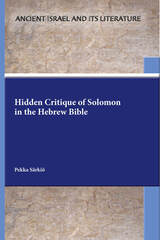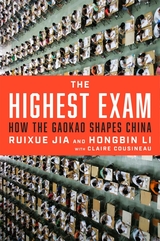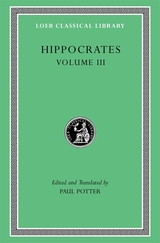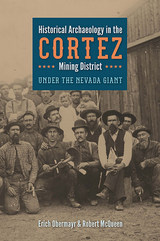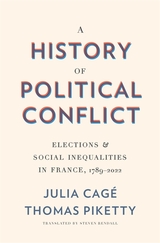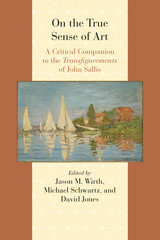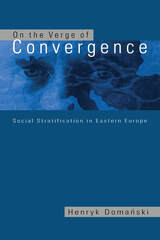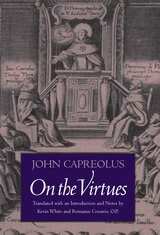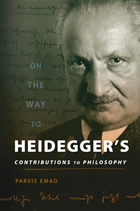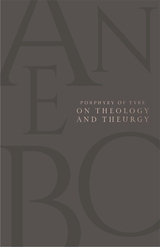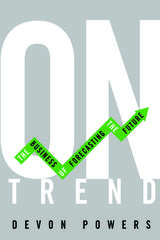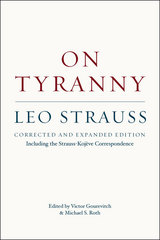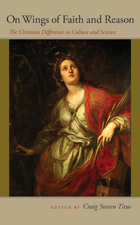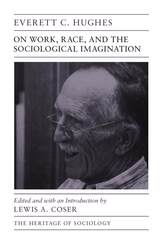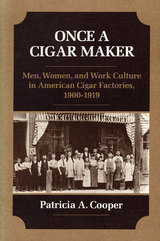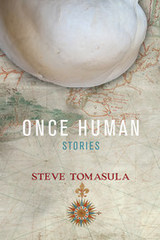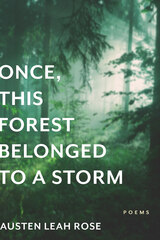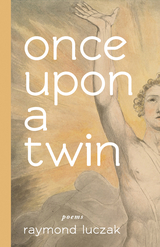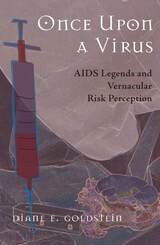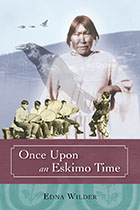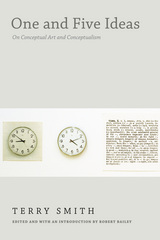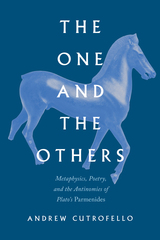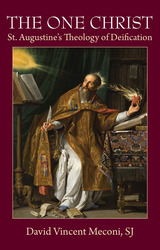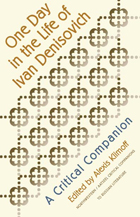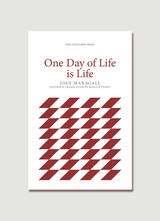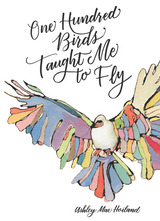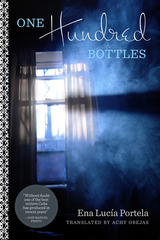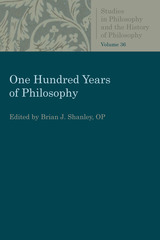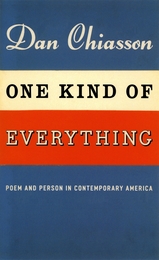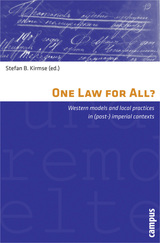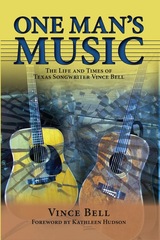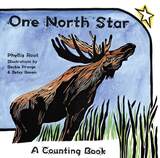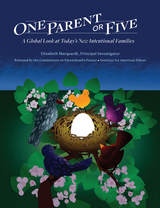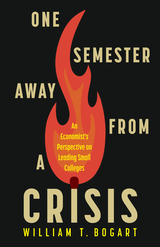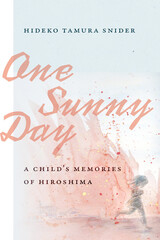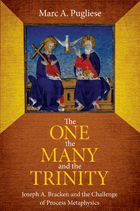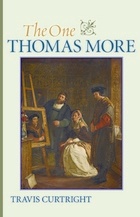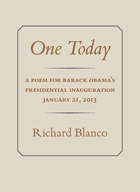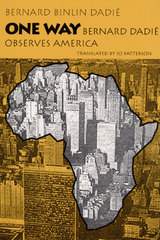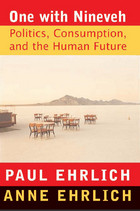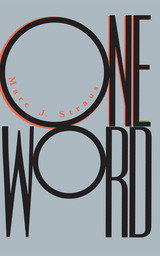On the True Sense of Art: A Critical Companion to the Transfigurements of John Sallis
Edited by Jason M. Wirth, Michael Schwartz, and David Jones
Northwestern University Press, 2016 On the True Sense of Art collects essays by philosophers responding to John Sallis’s Transfigurements: On the True Sense of Art as well as his other works on the philosophy of art, including Force of Imagination and Logic of Imagination. Each of the chapters, by some of the leading thinkers in Continental philosophy, engages Sallis’s work on both ancient and new senses of aesthetics—a transfiguration of aesthetics—as a beginning that is always beginning again. With a responsive essay by Sallis himself, On the True Sense of Art forms a critical introduction to the thought of this generation’s most important aesthetician.
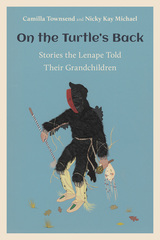 On the Turtle's Back: Stories the Lenape Told Their Grandchildren
Camilla Townsend
Rutgers University Press, 2023 NJSAA Collected Primary Sources Award Winner (2023)
The Lenape tribe, also known as the Delaware Nation, lived for centuries on the land that English colonists later called New Jersey. But once America gained its independence, they were forced to move further west: to Indiana, then Missouri, and finally to the territory that became Oklahoma. These reluctant migrants were not able to carry much from their ancestral homeland, but they managed to preserve the stories that had been passed down for generations.
On the Turtle’s Back is the first collection of Lenape folklore, originally compiled by anthropologist M. R. Harrington over a century ago but never published until now. In it, the Delaware share their cherished tales about the world’s creation, epic heroes, and ordinary human foibles. It features stories told to Harrington by two Lenape couples, Julius and Minnie Fouts and Charles and Susan Elkhair, who sought to officially record their legends before their language and cultural traditions died out. More recent interviews with Lenape elders are also included, as their reflections on hearing these stories as children speak to the status of the tribe and its culture today. Together, they welcome you into their rich and wondrous imaginative world.
On the Verge of Convergence: Social Stratification in Eastern Europe
Henryk Domanski
Central European University Press, 2000 Based on comparative surveys, the author presents a study of social transformation in Central and Eastern Europe after 1989. Focusing on Bulgaria, Czech Republic, Hungary, Poland, Russia and Slovakia, the author provides information relating to social structure, mobility, inequality, lifestyle and economic stratification. Applying the Erikson-Goldthorpe classification of class positions, Domanski effectively presents fully comparable data to enable political comparisons to be made with other countries, especially those with firmly established free market economies. As such, "On the Verge of Convergence" seeks to provide a clearer understanding of the on-going process of social transformation within developing capitalist societies.
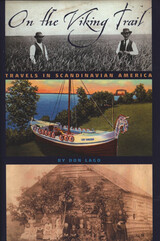 On the Viking Trail: Travels in Scandinavian America
Don Lago
University of Iowa Press, 2004 When his father developed Alzheimer’s disease, Don Lago realized that the stories and traditions of his Swedish ancestors would be lost along with the rest of his father’s memories. Haunted by this inevitable tragedy, Lago set out to fight back against forgetting by researching and reclaiming his long-lost Scandinavian roots. Beginning his quest with a visit to his ancestral home of Gränna, Sweden, Lago explores all facets of Scandinavian America—Swedish, Danish, Finnish, Norwegian, and Icelandic—along the way. He encounters Icelanders living in the Utah desert, a Titanic victim buried beneath a gigantic Swedish coffee pot in Iowa, an Arkansas town named after the famous Swedish opera singer Jenny Lind, a real-life Legoland in southern California, and other unique remnants of America’s Scandinavian past. Visits to Sigurd Olson’s legendary cabin on the banks of Burntside Lake in the Boundary Waters of Minnesota and Carl Sandburg’s birthplace in Galesburg, Illinois, further provide Lago with an acute sense of the Scandinavian values that so greatly influenced, and continue to influence, American society. More than just a travel memoir, On the Viking Trail places Scandinavian immigrants and their history within the wider sweep of American culture. Lago’s perceptive eye and amusing tales remind readers of all ethnic backgrounds that to truly appreciate America one must never forget its immigrant past.
On the Virtues
Jean Capreolus
Catholic University of America Press, 2001 The selection from Capreolus's work represented in this translation shows him defending Aquinas's conclusions on faith, hope, charity, the gifts of the Holy Spirit, and the virtues against such adversaries.
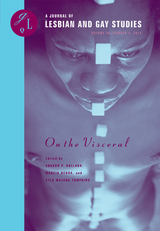 On the Visceral (Part One): Race, Sex and Other Gut Feelings
Sharon Holland, Marcia Ochoa, and Kyla Wazana Tompkins, special issue editors
Duke University Press Using the gut as a starting point, this special issue focuses on the idea of the visceral as a trope for the carnal and bloody logic that organizes life. It brings together scholars working in food studies, American studies, sexuality and queer studies, and critical race theory who are keen not only to understand patterns of bodily production and consumption but also to propose new theoretical scaffoldings for our understanding of the intersection of race, food, the human, and the animal. These essays highlight the moments, texts, and processes that link food, flesh, and the alimentary tract to systems of pleasure—as well as to historical and political systems of inequality. The contributors seek to unearth structures of feeling, sensing, and embodiment that have been obscured either by colonialist historiography or political prejudice.
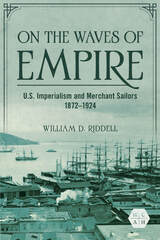 On the Waves of Empire: U.S. Imperialism and Merchant Sailors, 1872-1924
William D. Riddell
University of Illinois Press, 2023 In the aftermath of the Spanish-American War, the United States’ acquisition of an overseas empire compelled the nation to reconsider the boundary between domestic and foreign--and between nation and empire. William D. Riddell looks at the experiences of merchant sailors and labor organizations to illuminate how domestic class conflict influenced America’s emerging imperial system. Maritime workers crossed ever-shifting boundaries that forced them to reckon with the collision of different labor systems and markets. Formed into labor organizations like the Sailor’s Union of the Pacific and the International Seaman’s Union of America, they contested the U.S.’s relationship to its empire while capitalists in the shipping industry sought to impose their own ideas. Sophisticated and innovative, On the Waves of Empire reveals how maritime labor and shipping capital stitched together, tore apart, and re-stitched the seams of empire.
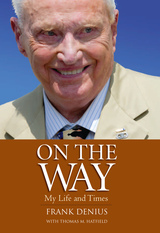 On the Way: My Life and Times
By Frank Denius
University of Texas Press, 2016 Frank Denius was not yet twenty-one when he fought his way across Europe and was awarded four Silver Stars, a Presidential Unit Citation, and two Purple Hearts. On the Way describes Denius’s formative experiences during World War II in gripping detail and will cause any reader to wonder how he or she might have held up under similar pressure. The powerful opening chapters are followed by a detailed account of Denius’s life and career after the war, assembled into a first-person memoir from conversations between Denius and Thomas Hatfield, and published by the Briscoe Center for American History at the University of Texas at Austin. Discharged from the army in October 1945, Denius enrolled at the University of Texas within a week. He is a lifelong supporter of the university: as part of the Texas Exes, as a donor to numerous academic programs, and as a fan of Longhorn football. Former UT football coach Mack Brown liked to say, “Frank has been to more practices than I have.” Denius graduated from the University of Texas School of Law and joined one of Austin’s leading law firms in the late 1940s. Denius recounts how Texas operated in Lyndon Johnson’s prime, observes power plays in the Texas energy industry, and describes his role in building a regional university into a global leader.
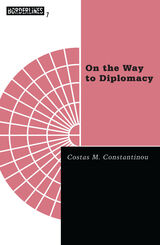 On The Way To Diplomacy
Costas M. Constantinou
University of Minnesota Press, 1996 A deconstruction of the idea of diplomacy that explores the links between its theory and practice. What does theory have to do with the concept-let alone the practice-of diplomacy? More than we might think, as Costas M. Constantinou amply demonstrates in this ambitious reconsideration of both the concept of diplomacy and the working of theory. Here, Constantinou focuses on the language that underwrites and directs theory and diplomacy, and shows that such a critical approach is actually a way of practicing politics. Constantinou underscores the original intertextual association between theory and diplomacy by employing the ancient Greek term theoria. Theoria once referred to both philosophical thinking and a sacred embassy sent to discharge a religious duty. The use of the term in this book leads to a new view of theory and diplomacy. Constantinou considers the structures of diplomacy and theory together with the notion of representation that is peculiar to Western metaphysical thought. A deconstruction of diplomacy itself, this work bridges classical and contemporary philosophy, ancient and modern political practice, and, ultimately, politics and the arts in general. It will alter the study, understanding, and practice of diplomacy.
On the Way to Heidegger’s Contributions to Philosophy
Parvis Emad
University of Wisconsin Press, 2007 One of the most significant philosophical works of the twentieth century, Contributions to Philosophy is also one of the most difficult. Parvis Emad, in this collection of interpretive and critical essays, unravels and clarifies this challenging work with a rare depth and originality. In addition to grappling with other commentaries on Heidegger, he highlights Heidegger's "being-historical thinking" as thinking that sheds new light on theological, technological, and scientific interpretations of reality. At the crux of Emad's interpretation is his elucidation of the issue of "the turning" in Heidegger's thought and his "enactment" of Heidegger's thinking. He finds that only when Heidegger's work is enacted is his thinking truly revealed.
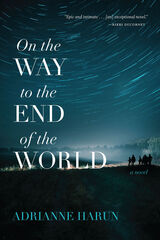 On the Way to the End of the World: A Novel
Adrianne Harun
Acre Books, 2023 In 1963, an eclectic group of characters embark on President Kennedy’s ambitious walking challenge.
As the Cuban Missile Crisis eases, President Kennedy is casting around for a demonstration of American prowess when one of his Cabinet unearths an old mandate that US Marines be fit enough to walk fifty miles in twenty hours. Perfect! Kennedy decides to throw down the gauntlet to “today’s Marines,” but before he knows it, he’s sparked a wild fad. The entire country has answered the call, it seems, and for a few crazed winter weeks, masses of Americans will embark on their own arduous Big Walks—the “JFK 50-Milers.”
Yet in tiny Humtown—an isolated mill town in the Pacific Northwest—not everyone who shows up for a hastily organized Big Walk is motivated by patriotism. Not Helen Hubka, an inveterate gossip; not the suicidal Caroline, who months earlier lost her beloved husband during the Storm of the Century. Not ex-soldier/fisherman Jaspar Goode, nor the unknown man in their midst, a collared priest who seems to shift identities at will. Certainly not Avis, a battered teenager running from her terrifying brother . . . with a stolen town treasure. And when the walkers stumble upon the abandoned car of a missing young mother, they rekindle a mystery that soon reverberates among them, exposing hidden truths, talents, and alliances.
Splendidly imagined, with prose that sings on the page, On the Way to the End of the World is an adventure story riven with secrets, a national fairy tale twisted into a whodunit.
 On the Way to Theory
Lawrence Grossberg
Duke University Press, 2024 In On the Way to Theory, Lawrence Grossberg introduces the major ways of thinking that provide the backstory for contemporary Western theory. Asking readers to think about thinking, Grossberg traces cultural and critical theory’s foundations from the contested enlightenments to modern and postmodern conceptualizations of power, experience, language, and existence. He introduces key figures as historical characters and lays out the unique set of tools for thought that their “deep theories” offer. Through finely tuned and accessible descriptions of their concepts and logics, Grossberg highlights thinkers including Spinoza, Kant, Hegel, Marx, Nietzsche, Wittgenstein, Heidegger, Derrida, Foucault, Deleuze, and Hall, defining the possibilities of their thought. This book is essential for those interested in how theories shape our understanding of the world, influence our choices, and define our realities. It challenges us to recognize the multiplicity and complexities of ways of thinking in our quest for knowledge and understanding. By setting out a story of theoretical foundations, Grossberg invites readers to think toward the future of theory and expand conversations around theoretical scrutiny and criticism.
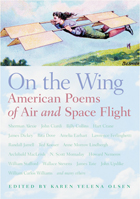 On the Wing: American Poems of Air and Space Flight
Olsen, Karen Yelena
University of Iowa Press, 2005 From Kitty Hawk to the jumbo jet and from the lunar landing to interstellar probes, American poets in On the Wing explore the phenomena of aviation and space flight. Edited by Karen Yelena Olsen, this balanced yet buoyant anthology collects 116 poems. The six thematic sections celebrate past achievements and the sensuous joys of flying (“Impulse of Delight”), revel in the vistas opening to the airborne traveler (“Worlds Above, Below, Within”), ponder the impact of air travel on everyday life (“Airplane Visions, Airport Truths”), outline the sinister role of the airplane in war (“Angle of Attack”), lament the shadow of airborne tragedy (“Icarus Falling”), and explore the mythic dimensions of space flight (“Space Odysseys”). Olsen’s introduction traces the prehistory of flight literature from the Bible to the 19th century and sketches the evolution of 20th-century response, from initial exuberance to a more nuanced and probing examination of aviation and aerospace as they affect our lives. The book includes a short history of flight in the U.S. The product of a lifetime’s passion for both flight and poetry, this collection will deeply interest those who have never been on a plane—and delight those who have.
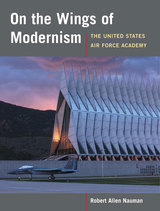 On the Wings of Modernism: The United States Air Force Academy
Robert Allen Nauman
University of Illinois Press, 2003 The United States Air Force Academy stands as one of the most extensive architectural projects of the cold war era. Key to a full understanding of American modernism, the project was also a volatile battleground involving competing ideas about aesthetics and politics. Arguing that the academy's production was squarely grounded in bureaucratic and political processes, Robert Allen Nauman demonstrates that selection of both the site and the design firm was the result of political maneuverings involving U.S. military leadership. In the academy’s iconic design, myths and metaphors of flight and the American West were interwoven with those of modernism, both to justify the plan and to free it from any lingering socialist or European associations. Skidmore, Owings, and Merrill’s first public exhibition of plans and models for the project was designed by the former Bauhaus master Herbert Bayer, and it incorporated photographs of the Colorado Springs site by Ansel Adams and William Garnett. Using previously unexplored resources of the U.S. Air Force Academy, SOM, and the Air Force Academy Construction Agency, Nauman uncovered materials such as negatives of Adams’s original photographs of the sites. He also conducted extensive interviews with SOM’s project director for the academy, Walter Netsch, in tracing the complete history of the academy's construction, from its earliest conception to eventual completion.
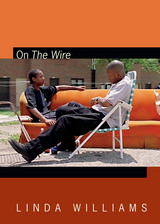 On The Wire
Linda Williams
Duke University Press, 2014 Many television critics, legions of fans, even the president of the United States, have cited The Wire as the best television series ever. In this sophisticated examination of the HBO serial drama that aired from 2002 until 2008, Linda Williams, a leading film scholar and authority on the interplay between film, melodrama, and issues of race, suggests what exactly it is that makes The Wire so good. She argues that while the series is a powerful exploration of urban dysfunction and institutional failure, its narrative power derives from its genre. The Wire is popular melodrama, not Greek tragedy, as critics and the series creator David Simon have claimed. Entertaining, addictive, funny, and despairing all at once, it is a serial melodrama grounded in observation of Baltimore's people and institutions: of cops and criminals, schools and blue-collar labor, local government and local journalism. The Wire transforms close observation into an unparalleled melodrama by juxtaposing the good and evil of individuals with the good and evil of institutions.
 On the Wonders of Land and Sea: Persianate Travel Writing
Roberta Micallef
Harvard University Press, 2013 On the Wonders of Land and Sea: Persianate Travel Writing initiates a comparative study of non-European travel writers in the eastern Islamic or Persianate world from the eighteenth to early twentieth centuries. The essays in this volume discuss travel narratives by male and female Muslim and Parsi/Zoroastrian travelers in the Hijaz, Iraq, Egypt, Turkey, Iran, Afghanistan, India, and Europe. Focusing on the literary and linguistic aspects of the travelogues, the essays reveal links to traditional forms of narrating travel and the introduction of hybrid forms of discourse. The authors’ methodological approach situates the texts in their socio-historical contexts and the travelers in their geographical locations, taking into account their gender and national identity. Each essay investigates a Muslim or Persianate traveler, whether sojourning in Europe or another part of the eastern world, and explores how the narrator represents what she or he sees while questioning the social and historical transformations accompanying modernity. The aim of this collection is to take a step toward a more sustained critical discussion of travelogues by Muslim travelers in dialogue with other Muslim, Persianate, and European travelers.
On the World and Religious Life
Coluccio Salutati
Harvard University Press, 2014 On the World and Religious Life (c. 1381) is the first surviving treatise of Coluccio Salutati (1332–1406), chancellor of the Florentine Republic (1375–1406) and the leader of the humanist movement in Italy in the generation after Petrarch and Boccaccio. The work was written for a lawyer who had left secular life to enter the Camaldulensian monastery of Santa Maria degli Angeli, located in the heart of Florence. The new monk prevailed on Salutati to write a treatise encouraging him to persevere in the religious life. His request led to this wide-ranging reflection on humanity’s misuse of God’s creation and the need to orient human life in accordance with a proper hierarchy of values. This work is here translated into English for the first time.
 On the Wrong Side
J. M. G. Le Clézio
Seagull Books, 2024 A short story collection from Nobel Prize winner J. M. G. Le Clézio offers a poignant and powerful exploration of the lives of the underprivileged and marginalized.
J. M. G. Le Clézio’s On the Wrong Side, a collection of eight short stories, continues the author’s life-long pursuit of granting visibility to the unseen and a voice to the voiceless. Here, the author focuses on the underclasses, primarily children who have been left behind, abandoned, and subjected to unspeakable violence.
In these haunting tales, we encounter Maureez Samson, a mistreated orphan from Rodrigues Island, who, thanks to her exceptional voice, becomes a famous singer and defies all expectations; some young Indians in Darién, a region straddling Panama and Colombia, struggle to raise their young son and save their idyllic land from its invasion and destruction by drug lords; Juanico and Chuche, two slave children who are taken in by the community of Saint Kateri Takakwitha after an arduous and perilous journey; and in Nogales, on the border between Mexico and the United States, the “street rats,” children who cross through the sewers to wreak havoc and perhaps indulge their dreams of life on the other side.
In Le Clézio’s own words, these stories are not simply meant to reveal or describe the plight of the “rejected,” but to “create in the reader a feeling of revolt in the face of the injustice of what is happening to them.”
 On Their Own Terms: Science in China, 1550-1900
Benjamin A. Elman
Harvard University Press, 2005 In On Their Own Terms, Benjamin A. Elman offers a much-needed synthesis of early Chinese science during the Jesuit period (1600-1800) and the modern sciences as they evolved in China under Protestant influence (1840s-1900).
By 1600 Europe was ahead of Asia in producing basic machines, such as clocks, levers, and pulleys, that would be necessary for the mechanization of agriculture and industry. In the seventeenth and eighteenth centuries, Elman shows, Europeans still sought from the Chinese their secrets of producing silk, fine textiles, and porcelain, as well as large-scale tea cultivation. Chinese literati borrowed in turn new algebraic notations of Hindu-Arabic origin, Tychonic cosmology, Euclidian geometry, and various computational advances.
Since the middle of the nineteenth century, imperial reformers, early Republicans, Guomindang party cadres, and Chinese Communists have all prioritized science and technology. In this book, Elman gives a nuanced account of the ways in which native Chinese science evolved over four centuries, under the influence of both Jesuit and Protestant missionaries. In the end, he argues, the Chinese produced modern science on their own terms.
On Theology and Theurgy
Porphyry of Tyre
Harvard University Press Porphyry of Tyre (c. 234–305) was not only the biographer of his teacher Plotinus, and the editor of his Enneads, but an important Platonist philosopher in his own right. On Theology and Theurgy presents two of Porphyry’s texts, preserved in fragments, in which he tries to bring philosophy to bear on religion, and ultimately to align the two. In “Letter to Anebo” and “Philosophy from Oracles,” Porphyry explores questions of reason, revelation, and ritual, of theology and theurgy, of how divination serves divinization. This edition includes the Greek fragments and Latin quotations of both texts with facing English translation, a Greek-English glossary (including Latin equivalents), and a commentary.
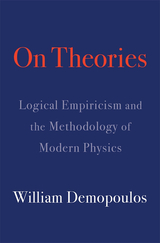 On Theories: Logical Empiricism and the Methodology of Modern Physics
William Demopoulos
Harvard University Press, 2022 A renowned philosopher’s final work, illuminating how the logical empiricist tradition has failed to appreciate the role of actual experiments in forming its philosophy of science.
The logical empiricist treatment of physics dominated twentieth-century philosophy of science. But the logical empiricist tradition, for all it accomplished, does not do justice to the way in which empirical evidence functions in modern physics.
In his final work, the late philosopher of science William Demopoulos contends that philosophers have failed to provide an adequate epistemology of science because they have failed to appreciate the tightly woven character of theory and evidence. As a consequence, theory comes apart from evidence. This trouble is nowhere more evident than in theorizing about particle and quantum physics. Arguing that we must consider actual experiments as they have unfolded across history, Demopoulos provides a new epistemology of theories and evidence, albeit one that stands on the shoulders of giants.
On Theories finds clarity in Isaac Newton’s suspicion of mere “hypotheses.” Newton’s methodology lies in the background of Jean Perrin’s experimental investigations of molecular reality and of the subatomic investigations of J. J. Thomson and Robert Millikan. Demopoulos extends this account to offer novel insights into the distinctive nature of quantum reality, where a logico-mathematical reconstruction of Bohrian complementarity meets John Stewart Bell’s empirical analysis of Einstein’s “local realism.” On Theories ultimately provides a new interpretation of quantum probabilities as themselves objectively representing empirical reality.
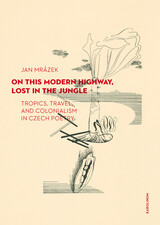 On This Modern Highway, Lost in the Jungle: Tropics, Travel, and Colonialism in Czech Poetry
Jan Mrázek
Karolinum Press, 2022 Postcolonial reflections on Indonesia’s influence upon the avant-garde poetry of a non-colonial European.
In 1926, the Communist avant-garde poet Konstantin Biebl (1898–1951) traveled from Czechoslovakia to the Dutch East Indies. In the writings from his journal—texts simultaneously poetic and comic—both landlocked Bohemia and the colonized tropical islands are seen in disorienting new perspectives, like “mirrors looking at themselves in each other.”
Jan Mrázek’s On This Modern Highway, Lost in the Jungle takes us on a journey of our own, crisscrossing Biebl’s life and work—with particular attention to his travel writing—as they mirror Mrázek’s own experiences as a multinational academic: a Prague conservatory graduate, educated at Michigan and Cornell, and now a scholar of Indonesia living in Singapore. Biebl’s writings are also the book’s point of departure for a broader exploration of the intersections of travel and poetry, issues of colonial and social injustice, and the representation of otherness in the Czech literary and visual imagination. In its attention to how poetic travel reflects the Czech historical experience in the shadow of imperial nations, Mrázek’s book elevates scholarly reflection on literary travel, modernity, and colonialism to a new level.
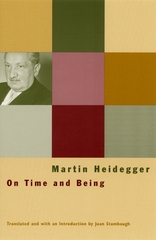 On Time and Being
Martin Heidegger
University of Chicago Press, 2002 On Time and Being charts the so-called "turn" in Martin Heidegger's philosophy away from his earlier metaphysics in Being and Time to his later thoughts after "the end of philosophy." The title lecture, "Time and Being," shows how Heidegger reconceived both "Being" and "time," introducing the new concept of "the event of Appropriation" to help give his metaphysical ideas nonmetaphysical meanings. On Time and Being also contains a summary of six seminar sessions that Heidegger conducted on "Time and Being," a lecture called "The End of Philosophy and the Task of Thinking," and an autobiographical sketch of Heidegger's intellectual history in "My Way of Phenomenology."
"This collection may well vie with Vom Wesen des Grundes and Identität and Differenz as definitive statements of Heidegger's ontology."—Library Journal
"The title of the English translation is that of the lead essay, the highly celebrated lecture which Heidegger gave in 1962 and which bears the same title as the never published 'third division' of the 'first half' of Being and Time. This lecture is perhaps the most significant document to be added to the Heideggerian corpus since the Letter of Humanism. . . . Stambaugh's translation is superb."—Stanley O. Hoerr and staff, The Review of Metaphysics
On Time Delivery: The Dog Team Mail Carriers
William S. Schneider
University of Alaska Press, 2012 From the turn of the twentieth century in interior Alaska, dog team mail carriers were charged with maintaining the trail systems and carrying the mail until they were replaced in the late 1930s and ’40s by airplane mail service. With the advent and widespread adoption of aviation, many of the trails were abandoned, and a generation of rural Alaskans has now grown up with few ties to the overland trail system that supported their grandparents and inspired modern traditions such as the world-famous Iditarod Race. In addition to chronicling the history of this unique postal service, On Time Delivery pays tribute to the men who carried the mail and the families who supported them, and considers the changing nature of how people experience the country where they live—and how this is affected by the systems of communication and transportation upon which they depend.
 On tourne!: French Language and Culture through Film
Véronique Anover and Rémi Fournier Lanzoni
Georgetown University Press, 2020 eTextbooks are now available through VitalSource.com! On tourne! is a one-semester, advanced French textbook (5th/6th semester of instruction) designed to be used as a stand-alone text for a course on French and francophone films or for a French conversation course. This textbook could also be used as a supplementary text in an advanced conversation course, a composition course, or a contemporary culture course. On tourne! guides students to analyze and discuss thirteen films from France and the francophone world. Each chapter focuses on a single film and includes pre-viewing activities, vocabulary, information on the cultural and linguistic nuances of the film, and post-viewing activities and discussion points. Moreover, each chapter contains a review of an essential grammatical structure as well as idiomatic expressions used in the film to highlight their pragmatic function. The films included explore a wide array of themes, ranging from family, food, and fashion to politics, religion, and racial/ethnic identities.
 On Transits and Transitions: Trans Migrants and U.S. Immigration Law
Tristan Josephson
Rutgers University Press, 2023 Celebrations of the “transgender tipping point” in the second decade of the twenty-first century occurred at the same time of heightened debates and anxieties about immigration in the United States. On Transits and Transitions explores what the increased visibility of trans people in the public sphere means for trans migrants and provides a counter-narrative to the dominant discourse that the inclusion of transgender issues in law and policy represents the progression of legal equality for trans communities. Focusing on the intersection of immigration and trans rights, Josephson presents a careful and innovative examination of the processes by which the category of transgender is produced through and incorporated into the key areas of asylum law, marriage and immigration law, and immigration detention policies. Using mobility as a critical lens, On Transits and Transitions captures the insecurity and precarity created by U.S. immigration control and related processes of racialization to show how im/mobility conditions citizenship and national belonging for trans migrants in the United States.
On Trend: The Business of Forecasting the Future
Devon Powers
University of Illinois Press, 2019 Trends have become a commodity—an element of culture in their own right and the very currency of our cultural life. Consumer culture relies on a new class of professionals who explain trends, predict trends, and in profound ways even manufacture trends. On Trend delves into one of the most powerful forces in global consumer culture. From forecasting to cool hunting to design thinking, the work done by trend professionals influences how we live, work, play, shop, and learn. Devon Powers' provocative insights open up how the business of the future kindles exciting opportunity even as its practices raise questions about an economy increasingly built on nonstop disruption and innovation. Merging industry history with vivid portraits of today's trend visionaries, Powers reveals how trends took over, what it means for cultural change, and the price all of us pay to see—and live—the future.
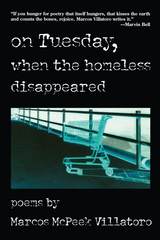 On Tuesday, When the Homeless Disappeared
Marcos McPeek Villatoro
University of Arizona Press, 2004 Marcos McPeek Villatoro is not afraid to discuss mysteries, truths, or injustices. He has lived them. Poet and novelist, activist and radio personality, Villatoro writes poetry steeped in formalism, free verse, and his own Salvadoran syntax. This new collection is a memoir-in-poems telling how the world appears to a Latin American immigrant. His sense of humanity is intact. He has a family, a job, a life in the States. But the face of the Mayan hero Tekún Umán hangs in his office, and he has "made clear all political positions by standing behind the wooden mask of a dead man."
Villatoro is a writer with a keen political sensibility and a sense of humor besides. After confronting the reader with weighty issues, he pauses to have an encounter with a curandera in a cornfield; to speculate on a visit from extraterrestrials; and to pay tribute to his free-spirited, loose-living Uncle Jack, who "chewed forest mushrooms like a rabbit, / Then howled at a California night / While whispering querida above open thighs." Combining Borgean logic, the grit of Neruda, and a heady dose of Zen, Villatoro offers a primer on how to integrate a history of brutality and injustice with the privilege and comfort of life in America. A final section of poems is presented in Spanish only—a statement of ascendance, a strategy for identity preservation, a gift to the cognoscenti.
Reading On Tuesday, When the Homeless Disappeared may make you shift in your seat—perhaps even toss in your sleep—as you encounter a poignant human voice that is unafraid to speak from the heart.
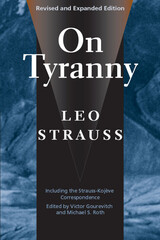 On Tyranny
Leo Strauss
University of Chicago Press, 2000 On Tyranny is Leo Strauss's classic reading of Xenophon's dialogue, Hiero or Tyrannicus, in which the tyrant Hiero and the poet Simonides discuss the advantages and disadvantages of exercising tyranny. This edition includes a translation of the dialogue, a critique of the commentary by the French philosopher Alexandre Kojève, Strauss's restatement of his position in light of Kojève's comments, and finally, the complete Strauss-Kojève correspondence.
"Through [Strauss's] interpretation Xenophon appears to us as no longer the somewhat dull and flat author we know, but as a brilliant and subtle writer, an original and profound thinker. What is more, in interpreting this forgotten dialogue, Strauss lays bare great moral and political problems that are still ours." —Alexandre Kojève, Critique
"On Tyranny is a complex and stimulating book with its 'parallel dialogue' made all the more striking since both participants take such unusual, highly provocative positions, and so force readers to face substantial problems in what are often wholly unfamiliar, even shocking ways." —Robert Pippin, History and Theory
"Every political scientist who tries to disentangle himself from the contemporary confusion over the problems of tyranny will be much indebted to this study and inevitably use it as a starting point."—Eric Voegelin, The Review of Politics
Leo Strauss (1899-1973) was the Robert Maynard Hutchins Distinguished Service Professor of Political Science at the University of Chicago.
On Tyranny: Corrected and Expanded Edition, Including the Strauss-Kojève Correspondence
Leo Strauss
University of Chicago Press, 2013 On Tyranny is Leo Strauss’s classic reading of Xenophon’s dialogue Hiero, or Tyrannicus, in which the tyrant Hiero and the poet Simonides discuss the advantages and disadvantages of exercising tyranny. Included are a translation of the dialogue from its original Greek, a critique of Strauss’s commentary by the French philosopher Alexandre Kojève, and the complete correspondence between the two.
This revised and expanded edition introduces important corrections throughout and expands Strauss’s restatement of his position in light of Kojève’s commentary to bring it into conformity with the text as it was originally published in France.
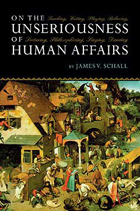 On Unseriousness Of Human Affairs: Teaching Writing Playing Believing
James V. Schall
Intercollegiate Studies Institute, 2001 “Readers will not go wrong ‘wasting’ the time it takes to cavort with the eternal truths presented, with such an enervating spirit of fun, in On the Unseriousness of Human Affairs.” —National Catholic Register “It is a book lightly written, laced with references to Charlie Brown and other cartoons, but deceptively heavy. I found myself inclined—almost forced—to pause after every section and think about Schall’s words.”
—Touchstone “Schall’s call to take seriously the unseriousness things of life is clearly, cleverly, and creatively stated.”
—Perspectives on Political Science “This new collection on what it is to be an educated human does not disappoint.” —New Oxford Review To the ears of ceaselessly busy and ambitious modern Westerners, it will come as a shock, and perhaps as an insult, to be told that human affairs are “unserious.” But this fundamental truth is exactly what James Schall, following Plato, has to teach us in this wise and witty book. Schall cites Charlie Brown, Aristotle, and Samuel Johnson with the same sobriety—the sobriety that sees the truth in what is delightful and even amusing. Singing, dancing, playing, contemplating, and other “useless” human activities are not merely forms of escape from more important things—politics, work, social activism, etc.—but an indication of the very nature of the highest things themselves. On the Unseriousness of Human Affairs is an instructive volume whose countercultural message is of vital importance.
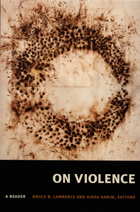 On Violence: A Reader
Bruce B. Lawrence and Aisha Karim, eds.
Duke University Press, 2007 This anthology brings together classic perspectives on violence, putting into productive conversation the thought of well-known theorists and activists, including Hannah Arendt, Karl Marx, G. W. F. Hegel, Osama bin Laden, Sigmund Freud, Frantz Fanon, Thomas Hobbes, and Pierre Bourdieu. The volume proceeds from the editors’ contention that violence is always historically contingent; it must be contextualized to be understood. They argue that violence is a process rather than a discrete product. It is intrinsic to the human condition, an inescapable fact of life that can be channeled and reckoned with but never completely suppressed. Above all, they seek to illuminate the relationship between action and knowledge about violence, and to examine how one might speak about violence without replicating or perpetuating it. On Violence is divided into five sections. Underscoring the connection between violence and economic world orders, the first section explores the dialectical relationship between domination and subordination. The second section brings together pieces by political actors who spoke about the tension between violence and nonviolence—Gandhi, Hitler, and Malcolm X—and by critics who have commented on that tension. The third grouping examines institutional faces of violence—familial, legal, and religious—while the fourth reflects on state violence. With a focus on issues of representation, the final section includes pieces on the relationship between violence and art, stories, and the media. The editors’ introduction to each section highlights the significant theoretical points raised and the interconnections between the essays. Brief introductions to individual selections provide information about the authors and their particular contributions to theories of violence. With selections by: Hannah Arendt, Walter Benjamin, Osama bin Laden, Pierre Bourdieu, André Breton, James Cone, Robert M. Cover, Gilles Deleuze, Friedrich Engels, Frantz Fanon, Michel Foucault, Sigmund Freud, Mohandas Gandhi, René Girard, Linda Gordon, Antonio Gramsci, Félix Guattari, G. W. F. Hegel, Adolf Hitler, Thomas Hobbes, Bruce B. Lawrence, Elliott Leyton, Catharine MacKinnon, Malcolm X, Dorothy Martin, Karl Marx, Chandra Muzaffar, James C. Scott, Kristine Stiles, Michael Taussig, Leon Trotsky, Simone Weil, Sharon Welch, Raymond Williams
 On Voluntary Servitude: False Consciousness and the Theory of Ideology
Michael Rosen
Harvard University Press, 1996 Those who approach the history of political thought must pick their way through a veritable elephant’s graveyard of grand theories. This book is aimed at one of the oldest and grandest of them all: the theory of ideology. The Age of Grand Theory has only recently ended, yet it is already hard to recall how many unquestioningly believed in the idea of ideology as false consciousness, most notably in Karl Marx’s version of that idea. Michael Rosen diagnoses the underlying question to which the theory of ideology was meant to provide the answer: “Why do people accept forms of political domination which it is against their interests to accept?” This book provides a historical and critical analysis of that answer and of the way in which it came to be taken for granted in social theory.Rosen’s post-mortem makes it clear that Marx was never able to develop an adequate theory of ideology and that recent attempts at reconstructive surgery on what he did give us, by G.A. Cohen and Jon Elster, have been unsuccessful. However, by putting Marx into a history that runs from Plato and Augustine to Benjamin, Adorno, and Habermas, Rosen shows that, though Marx may have failed, the rationalist tradition on which he drew is far from dead—that it is, in fact, the dominant tradition in Western political thought, with very few effective dissenters.This is a very rich and wide-ranging book in the history of ideas, written with philosophic rigor and great clarity.
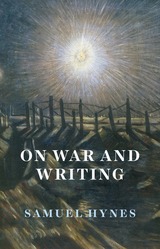 On War and Writing
Samuel Hynes
University of Chicago Press, 2018 “In our imaginations, war is the name we give to the extremes of violence in our lives, the dark dividing opposite of the connecting myth, which we call love. War enacts the great antagonisms of history, the agonies of nations; but it also offers metaphors for those other antagonisms, the private battles of our private lives, our conflicts with one another and with the world, and with ourselves.”
Samuel Hynes knows war personally: he served as a Marine Corps pilot in the Pacific Theater during World War II, receiving the Distinguished Flying Cross. He has spent his life balancing two careers: pilot and professor of literature. Hynes has written a number of major works of literary criticism, as well as a war-memoir, Flights of Passage, and several books about the World Wars. His writing is sharp, lucid, and has provided some of the most expert, detailed, and empathetic accounts of a disappearing generation of fighters and writers.
On War and Writing offers for the first time a selection of Hynes’s essays and introductions that explore the traditions of war writing from the twentieth century to the present. Hynes takes as a given that war itself—the battlefield uproar of actual combat—is unimaginable for those who weren’t there, yet we have never been able to turn away from it. We want to know what war is really like: for a soldier on the Somme; a submariner in the Pacific; a bomber pilot over Germany; a tank commander in the Libyan desert. To learn, we turn again and again to the memories of those who were there, and to the imaginations of those who weren’t, but are poets, or filmmakers, or painters, who give us a sense of these experiences that we can’t possibly know.
The essays in this book range from the personal (Hynes’s experience working with documentary master Ken Burns, his recollections of his own days as a combat pilot) to the critical (explorations of the works of writers and artists such as Thomas Hardy, E. E. Cummings, and Cecil Day-Lewis). What we ultimately see in On War and Writing is not military history, not the plans of generals, but the feelings of war, as young men expressed them in journals and poems, and old men remembered them in later years—men like Samuel Hynes.
 On Western Terrorism - New Edition: From Hiroshima to Drone Warfare
Noam Chomsky and Andre Vltchek
Pluto Press, 2017 “Noam Chomsky is arguably the most important intellectual alive today.” ― New York Times
“Noam Chomsky is a global phenomenon.”—New York Review of Books
In On Western Terrorism, world-renowned intellectual Noam Chomsky discusses Western power and propaganda with filmmaker and investigative journalist Andre Vltchek. Together they touch on colonialism, propaganda, and the media, and cover topics from the Soviet Union to Latin America to the Arab Spring.
Here is the perfect introduction to Chomsky's political thought and provides an accessible approach for anyone who wishes to better understand the West's fraught role in the world. Admired by some, condemned by others, and feared by all—the military might of the West is undeniably colossal.
Beginning with stories of the New York newsstand where Chomsky started his political education as a teenager, the discussion broadens out to encompass colonialism, imperial control, propaganda, and drone warfare.
Chomsky and Vltchek offer a powerful critique of the legacy of colonialism, touching upon many countries including Syria, Nicaragua, Cuba, China, Chile, and Turkey. The Table of Contents:
1. The Murderous Legacy of Colonialism
2. Concealing the Crimes of the West
3. Propaganda and the Media
4. The Soviet Bloc
5. India and China
6. Latin America
7. The Middle East and the Arab Spring
8. Hope in the Most Devastated Places on Earth
9. The Decline of U.S. Power Timeline
With a fresh design and a new foreword by Chomsky, this edition of On Western Terrorism stands as an influential and powerful critique of the West's role in the world, inspiring all who read it to think independently and critically.
 On What Cannot Be Said: Apophatic Discourses in Philosophy, Religion, Literature, and the Arts: Volume 1: Classic Formulations
William Franke
University of Notre Dame Press, 2007 Apophasis has become a major topic in the humanities, particularly in philosophy, religion, and literature. This monumental two-volume anthology gathers together most of the important historical works on apophaticism and illustrates the diverse trajectories of apophatic discourse in ancient, modern, and postmodern times. William Franke provides a major introductory essay on apophaticism at the beginning of each volume, and shorter introductions to each anthology selection. The first volume, Classic Formulations, offers excerpts from Plato, Plotinus, Damascius, the Bible, Gregory of Nyssa, Augustine, Pseudo-Dionysius, Maimonides, Rumi, Thomas Aquinas, Marguerite Porete, Dante, Teresa of Ávila, John of the Cross, and more.
“Any writer worth his salt knows that what cannot be spoken is ultimately the thing worth speaking about; yet most often this humbling awareness is unsaid or covered up. There are some who have made it their business, however, to court failure and acknowledge defeat, to explore the impasse of words before silence. William Franke has created an anthology of such explorations, undertaken in poetry and prose, that stretches from Plato to the present. Whether the subject of discourse is All or Nothing does not matter: the struggle of speech to name the unnameable is the same. This ambitious two-volume undertaking demonstrates a preoccupation as old as Western civilization itself: the limits of language and the virtue of being at a loss for words. How long we have been raiding the Inarticulate!” —Peter S. Hawkins, Boston University
“Developments in critical theory during the past two decades have led to renewed interest in negative theology. Books like Languages of the Unsayable (1989), Negation and Theology (1992), Derrida and Negative Theology (1992), and The Otherness of God (1998) have signaled the resurgence of this ancient tradition. William Franke’s distinctive contribution is to provide the background and texts from which these recent developments have emerged.” —Mark Taylor, Williams College
 On What Cannot Be Said: Apophatic Discourses in Philosophy, Religion, Literature, and the Arts: Volume 2: Modern and Contemporary Transformations
William Franke
University of Notre Dame Press, 2007 Apophasis has become a major topic in the humanities, particularly in philosophy, religion, and literature. This monumental two-volume anthology gathers together most of the important historical works on apophaticism and illustrates the diverse trajectories of apophatic discourse in ancient, modern, and postmodern times. William Franke provides a major introductory essay on apophaticism at the beginning of each volume, and shorter introductions to each anthology selection. The second volume, Modern and Contemporary Transformations, contains texts by Hölderlin, Schelling, Kierkegaard, Dickinson, Rilke, Kafka, Rosenzweig, Wittgenstein, Heidegger, Weil, Schoenberg, Adorno, Beckett, Celan, Levinas, Derrida, Marion, and more.
“Any writer worth his salt knows that what cannot be spoken is ultimately the thing worth speaking about; yet most often this humbling awareness is unsaid or covered up. There are some who have made it their business, however, to court failure and acknowledge defeat, to explore the impasse of words before silence. William Franke has created an anthology of such explorations, undertaken in poetry and prose, that stretches from Plato to the present. Whether the subject of discourse is All or Nothing does not matter: the struggle of speech to name the unnameable is the same. This ambitious two-volume undertaking demonstrates a preoccupation as old as Western civilization itself: the limits of language and the virtue of being at a loss for words. How long we have been raiding the Inarticulate!” —Peter S. Hawkins, Boston University
“Developments in critical theory during the past two decades have led to renewed interest in negative theology. Books like Languages of the Unsayable (1989), Negation and Theology (1992), Derrida and Negative Theology (1992), and The Otherness of God (1998) have signaled the resurgence of this ancient tradition. William Franke’s distinctive contribution is to provide the background and texts from which these recent developments have emerged.” —Mark Taylor, Williams College
 On Wide Seas: The US Navy in the Jacksonian Era
Claude Berube
University of Alabama Press, 2022 A meticulously researched account of how the US Navy evolved between the War of 1812 and the Civil War
The 1830s is an overlooked period in American naval history and is usually overshadowed by the more dramatic War of 1812 and the Civil War. Nevertheless, the personnel, operations, technologies, policies, and vision of the Navy of that era, which was emerging from the “Age of Sail,” are important components of its evolution, setting it on the long path to its status as a global maritime power. On Wide Seas: The US Navy in the Jacksonian Era details the ways in which the US Navy transformed from an antiquated arm of the nation’s military infrastructure into a more dynamic and effective force that was soon to play a pivotal role in a number of national and international conflicts.
By Andrew Jackson’s inauguration in 1829, the Navy had engaged with two major powers, defended American shipping, conducted antipiracy operations, and provided a substantive, long-term overseas presence. The Navy began to transform during Jackson’s administration due in part to the policies of the administration and to the emerging officer corps, which sought to professionalize its own ranks, modernize the platforms on which it sailed, and define its own role within national affairs and in the broader global maritime commons. Jackson had built his reputation as a soldier, but he quickly recognized as president the necessity for a navy that could foster his policies. To expand American commerce, he needed a navy that could defend shipping as well as conduct punitive raids or deterrence missions.
Jackson developed a clear, concise naval strategy that policymakers and officers alike could seize and execute. He also provided a vision for the Navy, interceded to resolve naval disciplinary challenges, and directed naval operations. Also, given Jackson’s own politics, junior officers were emboldened by the populist era to challenge traditional, conservative thinking. They carried out a collective vision that coincided with the national literary movement that recognized America’s future would rely upon the Navy.
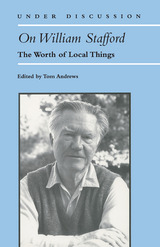 On William Stafford: The Worth of Local Things
Tom Andrews, Editor
University of Michigan Press, 1995 "[His] poems . . . bear witness to both the care and disregard around us--naming the places, catching the shine of the ordinary, pulling the rug out from under vanity and pretension, giving fresh credit to the selfless and decent, acknowledging the inevitable, nudging us toward observant lives and peaceful interactions."--Jurors, Western Book Awards Lifetime Achievement in Poetry, 1992
The late William Stafford's poetry and essays have had a major influence on contemporary American poetry. Since his book Traveling Through the Dark won the National Book Award in 1963, his awards have grown exponentially as new work has appeared. The range of writers in the past four decades who have celebrated Stafford's work-- from Margaret Atwood to James Dickey-- is remarkable. On William Stafford: The Worth of Local Things helps clarify the precise nature of Stafford's influence by assembling the responses of some of our best poets and critics to his work, including Richard Hugo, Charles Simic, Louis Simpson, Robert Coles, Linda Pastan, and Robert Creeley. This collection offers a unique view of Stafford's sometimes controversial work and insight into several of the liveliest recent debates in poetics.
Tom Andrews is Assistant Professor of English, Ohio University.
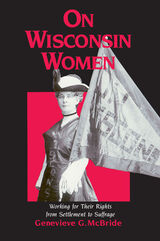 On Wisconsin Women: Working for Their Rights from Settlement to Suffrage
Genevieve C. McBride
University of Wisconsin Press, 1993 Wisconsin is known as the home of the Progressive party. But, in the words of a suffragist as late as 1912, “the last thing a man becomes progressive about is the activities of his wife.”
In On Wisconsin Women, Genevieve McBride traces women’s work in reform movements in the state’s politics and especially in its press. Even before Wisconsin became a state in 1848, women’s news and opinions appeared in abolitionist journals and “temperance sheets,” if often anonymously. But the first paper in Wisconsin published under a woman’s name, however, was boycotted by Milwaukee printers and failed in 1853.
From the passage of the Fourteenth Amendment in 1866 to the state’s historic ratification of the Nineteenth Amendment in 1919, Wisconsin women were never at a loss for words nor a newspaper to print them. Among women who would be heard were Mathilde Fransziska Anneke, Emma Brown, Lavinia Goodell, Emma Bascom, Olympia Brown, Belle Case La Follette, Ada L. James, and Theodora Winton Youmans. McBride brings their voices vividly to life, in their own words on their lifelong work for woman’s rights.
Nowhere was “the struggle” fought for so long and so hard as in Wisconsin. While women elsewhere sang suffrage hymns, women in the Badger State marched to a “fight song” with a familiar tune but sung in their own words—lyrics too long forgotten until now.
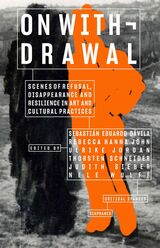 On Withdrawal—Scenes of Refusal, Disappearance, and Resilience in Art and Cultural Practices
Edited by Sebastián Eduardo Dávila, Rebecca Hanna John, Ulrike Jordan, Thorsten Schneider, Judith Sieber, and Nele Wulff
Diaphanes, 2023 A multidisciplinary examination of the forms taken by withdrawal.
What forms does withdrawal—meaning either that which withdraws itself or which is being withdrawn—take in artistic and cultural practices? What movements does it create or follow in specific contexts, and with what theoretical, material, and political consequences? The contributors to this book address these questions in a variety of writing practices, each focusing on specific scenes.
Through interviews, artistic and literary texts, visual contributions, and academic texts, On Withdrawal explores various modalities of withdrawal, ranging from a silencing of critical voices to a political and aesthetic strategy of refusal.
Contributors: Arnika Ahldag, Sofia Bempeza, Lauren Berlant, Kathrin Busch, Helen Cammock, Knut Ebeling, Sebastián Eduardo Dávila, Mutlu Ergün-Hamaz, Stefanie Graefe, Rebecca Hanna John, Ulrike Jordan, Pinar Ögrenci, Pallavi Paul, Thorsten Schneider, Judith Sieber, Diana Taylor, Deniz Utlu, Marivi Véliz, Nele Wulff, and Akram Zaatari
On Wonder
Matthew Bevis
Harvard University Press
On Work, Race, and the Sociological Imagination
Everett C. Hughes
University of Chicago Press, 1994 The writings in this volume highlight Hughes's contributions to the sociology of work and professions; race and ethnicity; and the central themes and methods of the discipline. Hughes was the first sociologist to pay sustained attention to occupations as a field for study and wrote frequently and searchingly about them. Several of the essays in this collection helped orient the first generation of Black sociologists, including Franklin Frazier, St. Clair Drake, and Horace Cayton.
On Writing the Biography of a Modest Man
Rollo Walter Brown
Harvard University Press Ever since Rollo Walter Brown wrote his famous biography of Dean LeBaron Russell Briggs, readers have asked him how it was possible to write it while the Dean was still alive. In this little book he gives the answer and at the same time records new anecdotes that shed light on the Dean’s character. The frontispiece is an enlargement from an informal snap-shot. To the thousands of Dean Briggs’s friends the book will be a perfect and enduring memorial of the best loved officer of Harvard in modern times.
 On Your Marx: Relinking Socialism and the Left
Randy Martin
University of Minnesota Press, 2001 Reclaims Marx for today through a fundamental reconsideration of how his works should be read. Why-and how-does Marx speak to our day? Seeking to reestablish the link between Marx, socialism, and the Left, this book negotiates the common ground between orthodox marxism and postmarxism to show how Marx can elaborate the present. More than a claim for his relevance, this book is also a forceful statement about how theory relates to political project and organization. What, Randy Martin asks, does Marx have to say to the discourses of radical democracy, postmodernism, and globalization-all of which purport to solve problems that emerge in Marx’s writings? A reading of Marx can in fact disclose the limitations of the contemporary modes of criticism, identifying the difficult conceptual problems that cannot be avoided or overcome. Using readings of Marx to restage contemporary political discussions, On Your Marx reengages orthodox and postmarxist understandings in a critical and constructive conversation. In doing so, the book points to powerful new alliances between cultural and political theorists and activists, opening new possibilities for mobilization and social justice.
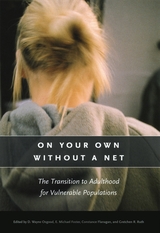 On Your Own without a Net: The Transition to Adulthood for Vulnerable Populations
Edited by D. Wayne Osgood, E. Michael Foster, Constance Flanagan, and Gretchen R
University of Chicago Press, 2005 In the decade after high school, young people continue to rely on their families in many ways-sometimes for financial support, sometimes for help with childcare, and sometimes for continued shelter. But what about those young people who confront special difficulties during this period, many of whom can count on little help from their families?
On Your Own Without a Net documents the special challenges facing seven vulnerable populations during the transition to adulthood: former foster care youth, youth formerly involved in the juvenile justice system, youth in the criminal justice system, runaway and homeless youth, former special education students, young people in the mental health system, and youth with physical disabilities. During adolescence, government programs have been a major part of their lives, yet eligibility for most programs typically ends between the ages of eighteen and twenty-one. This critical volume shows the unfortunate repercussions of this termination of support and points out the issues that must be addressed to improve these young people's chances of becoming successful adults.
 On Zion’s Mount: Mormons, Indians, and the American Landscape
Jared Farmer
Harvard University Press, 2010 Shrouded in the lore of legendary Indians, Mt. Timpanogos beckons the urban populace of Utah. And yet, no “Indian” legend graced the mount until Mormon settlers conjured it—once they had displaced the local Indians, the Utes, from their actual landmark, Utah Lake. On Zion’s Mount tells the story of this curious shift. It is a quintessentially American story about the fraught process of making oneself “native” in a strange land. But it is also a complex tale of how cultures confer meaning on the environment—how they create homelands.
Only in Utah did Euro-American settlers conceive of having a homeland in the Native American sense—an endemic spiritual geography. They called it “Zion.” Mormonism, a religion indigenous to the United States, originally embraced Indians as “Lamanites,” or spiritual kin. On Zion’s Mount shows how, paradoxically, the Mormons created their homeland at the expense of the local Indians—and how they expressed their sense of belonging by investing Timpanogos with “Indian” meaning.
This same pattern was repeated across the United States. Jared Farmer reveals how settlers and their descendants (the new natives) bestowed “Indian” place names and recited pseudo-Indian legends about those places—cultural acts that still affect the way we think about American Indians and American landscapes.
Once a Cigar Maker: Men, Women, and Work Culture in American Cigar Factories, 1900-1919
Patricia A. Cooper
University of Illinois Press, 1987 Patricia A. Cooper charts the course of competition, conflict, and camaraderie among American cigar makers during the two decades that preceded mechanization of their work. In the process, she reconstructs the work culture, traditions, and daily lives of the male cigar makers who were members of the Cigar Makers' International Union of America (CMIU) and of the nonunion women who made cigars under a division of labor called the "team system." But Cooper not only examines the work lives of these men and women, she also analyzes their relationship to each other and to their employers during these critical years of the industry's transition from handcraft to mass production.
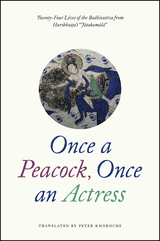 Once a Peacock, Once an Actress: Twenty-Four Lives of the Bodhisattva from Haribhatta's "Jatakamala"
Haribhatta
University of Chicago Press, 2017 Written in Kashmir around 400 CE, Haribhatta’s Jåtakamåla is a remarkable example of classical Sanskrit literature in a mixture of prose and verse that for centuries was known only in its Tibetan translation. But between 1973 and 2004 a large portion of the Sanskrit original was rediscovered in a number of anonymous manuscripts. With this volume Peter Khoroche offers the most complete translation to date, making almost 80 percent of the work available in English.
Haribhatta’s Jåtakamålå is a sophisticated and personal adaptation of popular stories, mostly non-Buddhist in origin, all illustrating the future Buddha’s single-minded devotion to the good of all creatures, and his desire, no matter what his incarnation—man, woman, peacock, elephant, merchant, or king—to assist others on the path to nirvana. Haribhatta’s insight into human and animal behavior, his astonishing eye for the details of landscape, and his fine descriptive powers together make this a unique record of everyday life in ancient India as well as a powerful statement of Buddhist ethics. This translation will be a landmark in the study of Buddhism and of the culture of ancient India.
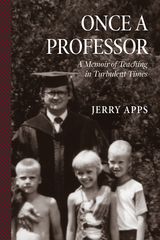 Once a Professor: A Memoir of Teaching in Turbulent Times
Jerry Apps
Wisconsin Historical Society Press, 2018 Farm boy professor shares a life of lessons.
“I never wanted to be a professor,” writes Jerry Apps in the introduction to Once a Professor. Yet a series of unexpected events and unplanned experiences put him on an unlikely path—and led to a thirty-eight-year career at the University of Wisconsin.
In this continuation of the Apps life story begun in his childhood memoir Limping through Life, Wisconsin’s celebrated rural storyteller shares stories from his years at the University of Wisconsin–Madison from 1957 to 1995, when he left the university to lecture and write fulltime. During those years Apps experienced the turmoil of protests and riots at the UW in the 1960s, the struggles of the tenure process and faculty governance, and the ever-present pressure to secure funding for academic research and programs.
Through it all, the award-winning writer honed a personal philosophy of education—one that values critical thinking, nontraditional teaching approaches, and hands-on experiences outside of the classroom. Colorful characters, personal photos, and journal entries from the era enrich this account of an unexpected campus career.
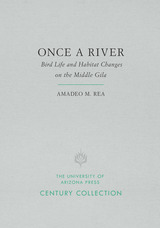 Once a River: Bird Life and Habitat Changes on the Middle Gila
Amadeo M. Rea
University of Arizona Press, 1983 Like many rivers of the arid Southwest, the Gila is for much of its length a dry bed except after seasonal rains. Yet a mere century ago it hosted a thriving biological community, and two centuries ago American Indians fished from its banks.
It is no mystery how the desert swallowed up the Gila. Beaver trapping, overgrazing, and woodcutting first ruined natural watersheds, then damming confined the last drops of its surface flow. Historical sources and archaeological data inform us of the Gila's past, but its bird life further testifies to the changes.
Amadeo Rea traces the decline of bird life on the Middle Gila in a book that addresses the broader issue of habitat deterioration. Bird lovers will find it a storehouse of data on avian migration patterns and on ornithological classification based on skeletal structure. Anthropologists can draw on its Piman ethnoclassification of birds, which links the Gila River tribe with various other Uto-Aztecan peoples of Mexico's west coast.
But for all concerned with protecting our environment, Once a River offers evidence of change that might be apprehended elsewhere. It is a case history of a loss that perhaps need never have occurred.
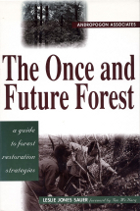 The Once and Future Forest: A Guide To Forest Restoration Strategies
Leslie Jones Sauer; Foreword by Ian McHarg; Andropogon Associates
Island Press, 1998 Developed by the pioneering landscape design firm of Andropogon Associates, world-renowned for their innovative approach to integrating environmental protection and restoration with landscape architecture and design, The Once and Future Forest is a guidebook for restoring and managing natural landscapes. Focusing on remnant forest systems, it describes methods of restoring and linking forest fragments to recreate a whole landscape fabric. The book begins by explaining the history and current situation of forest ecosystems in the eastern United States. Following that is an in-depth examination of the restoration process, with thorough descriptions of ecological strategies for landscape management along with specific examples of how those strategies have been implemented in various sites around the country. The final section provides hands-on information about the many specific details that must be considered when initiating and implementing a restoration program. All aspects of the restoration process are considered, including: Water -- opportunities for increasing infiltration, reducing pollutants, promoting habitat values Ground -- methods of protecting existing vegetation, removing fill, rebuilding soils Plants -- strategies and procedures for planting, maintenance, propagation Wildlife -- guidelines for preserving wildlife resources, management techniques to favor selected specie. The Once and Future Forest presents a comprehensive approach to assessing sites, detailed guidelines for determining management goals, and a thorough overview of appropriate management and restoration techniques. It is an important guide for professional planners and landscape architects, government agency personnel at all levels, land managers, scientists involved in restoration work, and citizen activists who wish to do something constructive about our deteriorating forest patches.
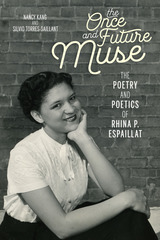 The Once and Future Muse: The Poetry and Poetics of Rhina P. Espaillat
Nancy Kang and Silvio Torres-Saillant
University of Pittsburgh Press, 2018 Honorable Mention, 2021 SSAWW Book Award
The Once and Future Muse presents the first major study of the life and work of Dominican-born bilingual American poet and translator Rhina P. Espaillat (b. 1932). Beginning with her literary celebrity as the youngest poet ever inducted into the Poetry Society of America, it traces her relative obscurity after 1952 when she married and took on family and employment responsibilities, to her triumphant return to the poetry spotlight decades later when she reclaimed her former prestige with a series of award-winning poetry collections.
The authors define Espaillat's place in American letters with attention to her formalist aesthetics, Hispanic Caribbean immigrant background, poetic community building, bilingual ethos, and domestically minded woman-of-color feminism. Addressing the temporality of her oeuvre—her publishing before and after the splitting of American literature into distinct ethnic segments—this work also highlights the demands that the social transformations of the 1960s placed on literary artists, critics, and readers alike.
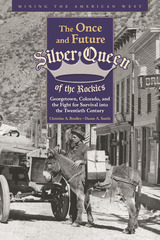 The Once and Future Silver Queen of the Rockies: Georgetown, Colorado, and the Fight for Survival into the Twentieth Century
Christine Bradley
University Press of Colorado, 2018 There are many studies of local communities during their heydays, but the life of a community in decline is rarely studied. The Once and Future Silver Queen of the Rockies delves into the life of Georgetown, Colorado, after the turn of the twentieth century as mining in Clear Creek County steadily declined and ultimately collapsed. One of the earliest mining communities in the state, Georgetown began to struggle for survival as the nineteenth century drew to a close. The price of silver dropped precipitously while other mining camps were still opening around the region. The new, bright future once envisioned for the “Silver Queen of the Rockies” began to fade. Yet the community managed to survive and re-create itself in the new world of the twentieth century. Tourism, skiing, and historic preservation replaced mineral extraction as the basis of the regional economy. Today, Georgetown maintains the aesthetic feel of a nineteenth-century mining town and stands as an example of community-supported historic preservation. This richly illustrated sequel to The Rise of the Silver Queen tells the compelling story of Georgetown’s survival, and ultimate flourishing, after the loss of its principal industry. It is an interesting and engaging addition to the history of Colorado and the West.
Once Human: Stories
Steve Tomasula
University of Alabama Press, 2014 A stunning new collection of stories by a master fictionist, Once Human shows the ways to go beyond standard maps of simple understanding
A manga artist who is afraid that she herself is slipping into a cartoon version of life, a lab technician who makes art with the cloning technology she uses at work, a sociologist hunting for the gene that makes some people want to take risks—these are some of the characters that populate the stories in Once Human. Exploring the spaces where life is shaped by science and the technologies we bring into being, Steve Tomasula’s characters often find that the harder they look at the world, the less they can say. The map that emerges from these stories charts the territory of human longing and the failure of poetry, science, and technology to explain the “why” of the world, if not its “how.”
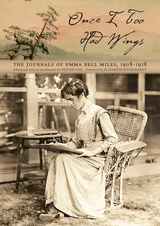 Once I Too Had Wings: The Journals of Emma Bell Miles, 1908–1918
Emma Bell Miles
Ohio University Press, 2014 Emma Bell Miles (1879–1919) was a gifted writer, poet, naturalist, and artist with a keen perspective on Appalachian life and culture. She and her husband Frank lived on Walden’s Ridge in southeast Tennessee, where they struggled to raise a family in the difficult mountain environment. Between 1908 and 1918, Miles kept a series of journals in which she recorded in beautiful and haunting prose the natural wonders and local customs of Walden’s Ridge. Jobs were scarce, however, and as the family’s financial situation deteriorated, Miles began to sell literary works and paintings to make ends meet. Her short stories appeared in national magazines such as Harper’s Monthly and Lippincott’s, and in 1905 she published Spirit of the Mountains, a nonfiction book about southern Appalachia. After the death of her three-year-old son from scarlet fever in 1913, the journals took a more somber turn as Miles documented the difficulties of mountain life, the plight of women in rural communities, the effect of disparities of class and wealth, and her own struggle with tuberculosis. Previously examined only by a handful of scholars, the journals contain both poignant and incisive accounts of nature and a woman’s perspective on love and marriage, death customs, child raising, medical care, and subsistence on the land in southern Appalachia in the early twentieth century. With a foreword by Elizabeth S. D. Engelhardt, this edited selection of Emma Bell Miles’s journals is illustrated with examples of her painting.
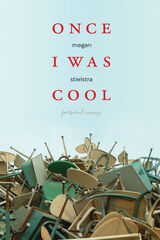 Once I Was Cool: Personal Essays
Megan Stielstra
Northwestern University Press, 2021 Once I Was Cool contrasts past aspirations with the mess and magic of the present. In her younger days, essayist Megan Stielstra saw Jane’s Addiction at the Aragon Ballroom and fantasized about living on the same block, right in the thick of music and revelry. As an adult, she lives in a turreted condo across the street, with her husband, a child, and an onerous mortgage. It’s just the home her young, cool self imagined. And it isn’t what she expected, either.
With conversational flourishes and on-the-mark descriptions, Stielstra’s essays evoke the richness of her everyday life and the memories that are never far away. She remembers learning how to shoot a gun, a cancer scare, and—in a piece that was anthologized in The Best American Essays 2013—the time she eavesdropped on another new mother using her son’s baby monitor. “I shouldn’t have listened,” she writes. “But it was the first time since my son was born that I didn’t feel alone.” Combining footnotes, electric sentences, and uproariously funny anecdotes (have you ever run into an ex while rolling on ecstasy?), Stielstra shows us that maturity is demanding, but its rewards are a gift.
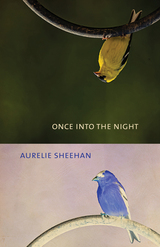 Once into the Night
Aurelie Sheehan, Foreword by Laird Hunt
University of Alabama Press, 2019 Winner of FC2’s Catherine L. Doctorow Innovative Fiction Prize
Stories that explore the potent and captivating boundaries between the real and the imaginary
Aurelie Sheehan’s Once into the Night is a collection of 57 brief stories—a fictional autobiography made of assumed identities and what-ifs. What is the difference between fiction and a lie? These stories dwell in a netherworld between memory and the imagination, exploring the nature of truthtelling.
Here the inner life is granted pride of place with authenticity found in misremembered childhood notebooks, invisible tattoos, and the love life of icemen. Radical in its conception of story, this collection blurs the line between fiction, poetry, and essay, reconceiving contemporary autofiction in its own witty, poignant vernacular. The stories intersect with and deviate from a “provable” life—a twin distinction that becomes the source of their power.
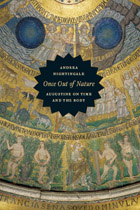 Once Out of Nature: Augustine on Time and the Body
Andrea Nightingale
University of Chicago Press, 2011 Once Out of Nature offers an original interpretation of Augustine’s theory of time and embodiment. Andrea Nightingale draws on philosophy, sociology, literary theory, and social history to analyze Augustine’s conception of temporality, eternity, and the human and transhuman condition. In Nightingale’s view, the notion of embodiment illuminates a set of problems much larger than the body itself: it captures the human experience of being an embodied soul dwelling on earth. In Augustine’s writings, humans live both in and out of nature—exiled from Eden and punished by mortality, they are “resident aliens” on earth. While the human body is subject to earthly time, the human mind is governed by what Nightingale calls psychic time. For the human psyche always stretches away from the present moment—where the physical body persists—into memories and expectations. As Nightingale explains, while the body is present in the here and now, the psyche cannot experience self-presence. Thus, for Augustine, the human being dwells in two distinct time zones, in earthly time and in psychic time. The human self, then, is a moving target. Adam, Eve, and the resurrected saints, by contrast, live outside of time and nature: these transhumans dwell in an everlasting present. Nightingale connects Augustine’s views to contemporary debates about transhumans and suggests that Augustine’s thought reflects our own ambivalent relationship with our bodies and the earth. Once Out of Nature offers a compelling invitation to ponder the boundaries of the human.
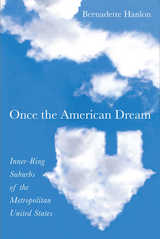 Once the American Dream: Inner-Ring Suburbs of the Metropolitan United States
Bernadette Hanlon
Temple University Press, 2012 At one time, a move to the suburbs was the American Dream for many families. However, despite the success of Levittown, NY,impoverished “inner-ring” suburbs—those closest to the urban core of metropolitan cities—like Lansdowne, MD, are in decline. As aging housing stock, foreclosures, severe fiscal problems, slow population growth, increasing poverty, and struggling local economies affect inner-ring suburbs, what can be done to save them?
Once the American Dream analyzes this downward trend, examining 5,000 suburbs across 100 different metropolitan areas and census regions in 1980 and 2000. Hanlon defines the suburbs’ geographic boundaries and provides a ranking system for assessing and acting upon inner-ring suburban decline. She also illuminates her detailed statistical analysis with vivid case studies. She demonstrates how other suburbs, particularly those in the outer reaches of cities, flourished during the 1980s and 1990s. Once the American Dream closes with a discussion of policy implications and recommendations for policymakers and planners who deal with suburbs of various stripes.
 Once the Buddha Was a Monkey: Arya Sura's "Jatakamala"
Arya Sùra
University of Chicago Press, 1989 Here is one of the most entertaining masterpieces of Sanskrit literature rendered in an English translation that fully captures the original's artistry and charm. Written most probably in the fourth century A.D., the Jatakamala is generally considered the masterpiece of Buddhist literature in Sanskrit. In elegant, courtly style, Arya Sura retells thirty-four traditional stories about the Buddha in his previous incarnations, human and animal. Whether as a king, a brahmin, a monkey, or a hare, the Great One is shown in assiduous pursuit of virtue and compassion. Though primarily intended as exemplary tales illustrating the Buddhist virtues, these stories also provide a vivid picture of life at a high point in ancient Indian culture—city life in ordinary households or at the royal court, and country life against a backdrop of mountain, desert, and jungle. Fresh study of the Sanskrit manuscripts, now scattered in libraries all over the world, has enabled Peter Khoroche to make this new translation faithful to the original in both style and content. His explanatory notes will assist student and general reader alike in appreciating this classic from an ancient and exotic civilization. “The general reader will be highly grateful for this new translation which, besides being beautifully printed, is rounded off with a very informative and reliable introduction.”—Renate Söhnen-Thieme, Bulletin of the School of Oriental and African Studies
“One would be a fool not to welcome the chance to read this book.”—Richard Gombrich, Journal of the Royal Asiatic Society
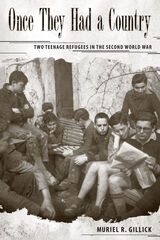 Once They Had a Country: Two Teenage Refugees in the Second World War
Muriel R. Gillick
University of Alabama Press, 2010 Muriel Gillick draws from a remarkable set of primary source materials, including letters, telegrams, and police records to relate the story of two teenage refugees during World War II. Once They Had a Country conveys well what it was like to establish a new life in a foreign country—over and over again and in constant fear for one’s life. The work tells of the extraordinary experiences of the author’s parents in Europe and demonstrates how citizens and the governments of Belgium, France, Switzerland, Brazil, America, China, and postwar Germany treated refugees. This story also reveals the origins of the Convention Relating to the Status of Refugees, the basis of contemporary international law affecting refugees in many countries today. In addition to the dramatic human story it tells, this work brings the plight of refugees home to the reader—and with over 8 million refugees worldwide today, the subject of how individuals and nation states respond to these individuals is indeed timely.
Once, This Forest Belonged to a Storm
Austen Leah Rose
University of Massachusetts Press, 2023 Does history live inside of us? Are we capable of transcending the past or are we destined to repeat it? With understated humor and grace, Once, This Forest Belonged to a Storm wrestles with questions of inheritance, spiritual unrest, the integrity of the self, and humanity’s relationship to the natural world. Excavating both personal and historical trauma and the rippling effects of the Holocaust, Austen Leah Rose writes of “the silence that follows after silence.” The poems in this debut collection map a surreal journey from alienation to belonging, as our speaker floats across the night sky over Los Angeles, communes with Shakespeare in a hotel room, attends a dinner party in outer space, and drifts down a river for fourteen years with her sister.
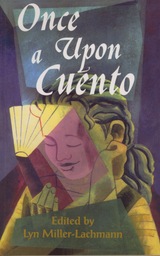 Once Upon a Cuento
Edited by Lyn Miller-Lachmann
Northwestern University Press, 2003 Once Upon a Cuento is an anthology of short stories by contemporary Latinx authors. The stories, written for young people, grade five and up, explore heritage and history, identity, language, and relationships from the perspective of Mexican-American, Cuban-American, Dominican-American, and Puerto Rican writers. In all, the collection features seventeen stories by well-known and emerging writers, most of which are original to this collection. Contributors include acclaimed Puerto Rican children's authors Nicholasa Mohr and Carmen T. Bernier-Grand; Cuban-American novelist, essayist, and poet Virgil Suárez; and Mexican-American short story writers and teachers Lorraine López and Sergio Troncoso. The stories are grouped by theme—heritage, holidays, and contemporary culture; family life; friends and other relationships; and dealing with differences. Individual stories explore additional themes such as the challenge of making do with little money, the process of moving to a new country and learning English, and young people's relationships to animals and to the natural world. Each story contains an introduction that offers historical, cultural, and biographical information. A general introduction and list of works by the thirteen contributors offer further avenues for research and discussion.
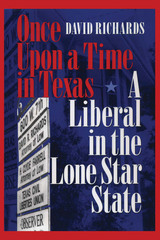 Once Upon a Time in Texas: A Liberal in the Lone Star State
By David Richards
University of Texas Press, 2002 Once upon a time in Texas...there were liberal activists of various stripes who sought to make the state more tolerant and more tolerable. David Richards was one of them. In this fast-paced, often humorous memoir, he remembers the players, the strategy sessions, the legal and political battles, and the wins and losses that brought significant gains in civil rights, voter rights, labor law, and civil liberties to the people of Texas from the 1950s to the 1990s. In his work as a lawyer, Richards was involved in cases covering voters' rights, school finance reform, and a myriad of civil liberties and free speech cases. In telling these stories, he vividly evokes the "glory days" of Austin liberalism, when a who's who of Texas activists plotted strategy at watering holes such as Scholz Garden and the Armadillo World Headquarters. Likewise, he offers vivid portraits of liberal politicians from Ralph Yarborough to Ann Richards (his former wife), progressive journalists such as Molly Ivins and the Texas Observer staff, and the hippies, hellraisers, and musicians who all challenged Texas's conservative status quo.
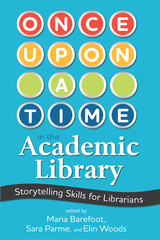 Once Upon a Time in the Academic Library: Storytelling Skills for Librarians
Maria Barefoot
American Library Association, 2022 It could be argued that to tell stories is to be human. Storytelling evolved alongside us to provide entertainment via literature, plays, and visual arts. It helps shape society through parables, moral tales, and religion. Storytelling plays a role in business, law, medicine, and education in modern society. Academic librarians can apply storytelling in the same way that teachers, entertainers, lawyers, and businesspeople have done for centuries, as education within information literacy instruction and as communication in the areas of reference, outreach, management, assessment, and more. Once Upon a Time in the Academic Library explores applications of storytelling across academic librarianship in three sections: - The Information Literacy Classroom
- The Stacks
- Physical and Virtual Library Spaces
A thorough introduction discusses the historical and theoretical roots of storytelling, as well as the mechanics and social justice applications. Chapter authors demonstrate using storytelling to share diverse viewpoints that connect with their users, and each chapter contains practical examples of how storytelling can be used within the library and cultural considerations for the audience. The first section focuses on storytelling as a pedagogical tool; the others include examples of how storytelling has been used as a communication method in sharing and developing collections, at service points, and in online spaces. Once Upon a Time in the Academic Library can provide ideas and inspiration for incorporating storytelling into your teaching and communication, and inspire you to invent new ways of using it in your work.
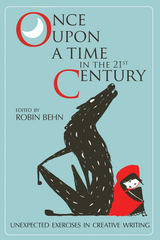 Once Upon a Time in the Twenty-First Century: Unexpected Exercises in Creative Writing
Edited by Robin Behn
University of Alabama Press, 2020 Fun and innovative exercises and prompts for creative writing students
Once Upon a Time in the Twenty-First Century: Unexpected Exercises in Creative Writing is a unique creative writing text that will appeal to a wide range of readers and writers—from grade nine through college and beyond. Successful creative writers from numerous genres constructed these exercises, including poetry, fiction, and creative nonfiction to one-act plays, song lyrics, genre fiction, travel guides, comics and beyond. The exercises use a broad range of creative approaches, aesthetics, and voices, all with an emphasis on demystifying the writing process and having fun.
Editor Robin Behn has divided the book into three writing sections: Genres and Forms, Sources and Methods, and Style and Subject. In each section, Behn offers a brief introduction which explains how to get started and specific ways to develop one’s writing. Each introduction is followed by extensive exercises that draw on literature from classic to contemporary, as well as other art forms and popular culture. Examples range from Flannery O’Connor and Langston Hughes to Allen Ginsberg and Gertrude Stein, from Jamaica Kincaid and James Joyce to Arlo Guthrie and Harryette Mullen. Integrated within the exercises are apt examples of student writings that have emerged from actual use of the exercises in both the classroom and in writing groups. The book concludes with general advice and direction on how to get published.
Based on years of hands-on experiences in the teaching of creative writing in high schools, colleges, and after-school writing clubs, this volume of exercises offers inestimable value to students and teachers in the traditional classroom, as well as a growing number of homeschoolers, those who are part of a writing club or group, and independent writers and learners of all ages.
once upon a twin: poems
Raymond Luczak
Gallaudet University Press, 2021 When Raymond Luczak was growing up deaf in a hearing Catholic family of nine children, his mother shared conflicting stories about having had a miscarriage after—or possibly around—the time he was conceived. As an elegy to his lost twin, this book asks: If he had a twin, just how different would his life have been?
Once Upon A Virus
Diane E. Goldstein
Utah State University Press, 2004 Once Upon a Virus explores how contemporary, or "urban," legends are indicators of culturally complex attitudes toward health and illness. Tracing the rich tradition of AIDS legends in relation to current scholarship on belief, Diane Goldstein shows how such stories not only articulate widespread perceptions of risk, health care, and health policy, they also influence official and scientific approaches to the disease and its management. Notions that appear in narratives of who gets AIDS, how and why, are indicators of broad issues involving health beliefs, concerns, and needs.
 Once Upon A Wilderness
Calvin Rutstrum
University of Minnesota Press, 2002 The complete outdoorsman looks back on fifty years of wilderness adventures to find answers to today’s questions. Though he began his life as a Twin Cities resident, Calvin Rutstrum came to see noise, material wealth, and perpetual frenzy as the narcotics of the city dweller. Like Henry David Thoreau, he set out to live a simpler, more meaningful life. In his pursuit, Rutstrum came to appreciate the natural world and the skills necessary to survive in it. Part memoir, part guidebook, and part environmental treatise, Once upon a Wilderness is a treasury of wilderness wisdom. Rutstrum reminisces about lessons that his time in the wilderness has taught him. He writes about a range of backcountry issues, including environmental preservation, cultural sensitivity toward Native Americans, the urban versus the rural, and the artistic value of practical skills. Through his thoughtful consideration of the pleasure and value of wilderness, Rutstrum offers a clarion call for a saner, more socially responsible and environmentally sensitive way of living.
Once Upon an Eskimo Time
Edna Wilder
University of Alaska Press, 2009 Continuing the sacred tradition of her ancestors, in Once Upon an Eskimo Time Edna Wilder retells a year in her Eskimo mother’s life. Wilder eloquently captures the oral storytelling traditions of her people, and she employs descriptions of the weather and harsh climates of Alaska’s Norton Sound to illustrate the hardiness of her mother’s spirit. Family values, subsistence living, and the cycle’s of life form a narrative that captures the now-vanished lifestyle along the Bering Sea. “Readers of whatever age will enjoy Nedercook’s delightful account of the day-to-day, legends, and beliefs of the ancient Eskimo village of Rocky Point.”—Ames Tribune
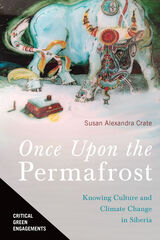 Once Upon the Permafrost: Knowing Culture and Climate Change in Siberia
Susan Alexandra Crate
University of Arizona Press, 2021 Once Upon the Permafrost is a longitudinal climate ethnography about “knowing” a specific culture and the ecosystem that culture physically and spiritually depends on in the twenty-first-century context of climate change.
The author, anthropologist Susan Alexandra Crate, has spent three decades working with Sakha, the Turkic-speaking horse and cattle agropastoralists of northeastern Siberia, Russia. Crate reveals Sakha’s essential relationship with alaas, the foundational permafrost ecosystem of both their subsistence and cultural identity. Sakha know alaas via an Indigenous knowledge system imbued with spiritual qualities. This counters the scientific definition of alaas as geophysical phenomena of limited range. Climate change now threatens alaas due to thawing permafrost, which, entangled with the rural changes of economic globalization, youth out-migration, and language loss, make prescient the issues of ethnic sovereignty and cultural survival.
Through careful integration of contemporary narratives, on-site observations, and document analysis, Crate argues that local understandings of change and the vernacular knowledge systems they are founded on provide critical information for interdisciplinary collaboration and effective policy prescriptions. Furthermore, she makes her message relevant to a wider audience by clarifying linkages to the global permafrost system found in her comparative research in Mongolia, Arctic Canada, Kiribati, Peru, and Chesapeake Bay, Virginia. This reveals how permafrost provides one of the main structural foundations for Arctic ecosystems, which, in turn, work with the planet’s other ecosystems to maintain planetary balance.
Metaphorically speaking, we all live on permafrost.
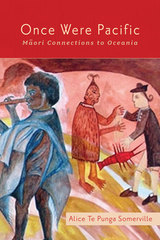 Once Were Pacific: Maori Connections to Oceania
Alice Te Punga Somerville
University of Minnesota Press, 2012 Native identity is usually associated with a particular place. But what if that place is the ocean? Once Were Pacific explores this question as it considers how Māori and other Pacific peoples frame their connection to the ocean, to New Zealand, and to each other through various creative works. Māori scholar Alice Te Punga Somerville shows how and when Māori and other Pacific peoples articulate their ancestral history as migratory seafarers, drawing their identity not only from land but also from water. Although Māori are ethnically Polynesian, and Aotearoa New Zealand is clearly a part of the Pacific region, in New Zealand the terms “Māori” and “Pacific” are colloquially applied to two distinct communities: Māori are Indigenous, and “Pacific” refers to migrant communities from elsewhere in the region. Asking how this distinction might blur historical and contemporary connections, Te Punga Somerville interrogates the relationship between indigeneity, migration, and diaspora, focusing on texts: poetry, fiction, theater, film, and music, viewed alongside historical instances of performance, journalism, and scholarship. In this sustained treatment of the Māori diaspora, Te Punga Somerville provides the first critical analysis of relationships between Indigenous and migrant communities in New Zealand.
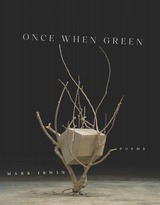 Once When Green: Poems
Mark Irwin
University of Massachusetts Press, 2025 “We breathe, and then / vanish,” proclaims a speaker in Once When Green, a new collection by accomplished poet Mark Irwin. While deeply personal, the book engages the earth, “gulls, / gray, quarreling air, their ha-ha-ha-ing at our trace / of garbage and carbon,” and addresses mortality as well as the consequences of global warming—how it impacts humans, animals, and the plant life that sustains us all. Poems here accent the lateness of our attempt to control pollution, while interrogating the natural world through myth and the voicings of different creatures, beings displaced or relegated to other spaces, including apes, birds, and an arcade bear that reflects: “I once thought that was freedom— / but how in a receding wilderness no longer mine?” Sighting those areas where metropolis and wilderness collide, Irwin conveys the tension between the natural and digital world as a speaker laments: “I am so lonely for a river’s one rushing / minute with scuttling crayfish, nymphs, and eddies blurring clouds, not its / imagined thousand pixels changing colors toward forms / on a screen.” These poems remind us how forms of the spirit cannot be bound by technology and capitalism, imploring “how to become explorers, cartographers / again.”
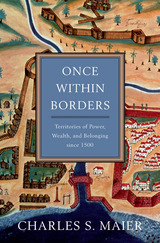 Once Within Borders: Territories of Power, Wealth, and Belonging since 1500
Charles S. Maier
Harvard University Press, 2016 Throughout history, human societies have been organized preeminently as territories—politically bounded regions whose borders define the jurisdiction of laws and the movement of peoples. At a time when the technologies of globalization are eroding barriers to communication, transportation, and trade, Once Within Borders explores the fitful evolution of territorial organization as a worldwide practice of human societies. Master historian Charles S. Maier tracks the epochal changes that have defined territories over five centuries and draws attention to ideas and technologies that contribute to territoriality’s remarkable resilience.
Territorial boundaries transform geography into history by providing a framework for organizing political and economic life. But properties of territory—their meanings and applications—have changed considerably across space and time. In the West, modern territoriality developed in tandem with ideas of sovereignty in the seventeenth century. Sovereign rulers took steps to fortify their borders, map and privatize the land, and centralize their sway over the populations and resources within their domain. The arrival of railroads and the telegraph enabled territorial expansion at home and abroad as well as the extension of control over large spaces. By the late nineteenth century, the extent of a nation’s territory had become an index of its power, with overseas colonial possessions augmenting prestige and wealth and redefining territoriality.
Turning to the geopolitical crises of the twentieth century, Maier pays close attention to our present moment, asking in what ways modern nations and economies still live within borders and to what degree our societies have moved toward a post-territiorial world.
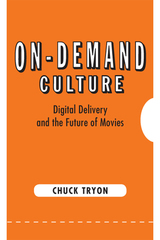 On-Demand Culture: Digital Delivery and the Future of Movies
Tryon, Chuck
Rutgers University Press, 2013 The movie industry is changing rapidly, due in part to the adoption of digital technologies. Distributors now send films to theaters electronically. Consumers can purchase or rent movies instantly online and then watch them on their high-definition televisions, their laptops, or even their cell phones. Meanwhile, social media technologies allow independent filmmakers to raise money and sell their movies directly to the public. All of these changes contribute to an “on-demand culture,” a shift that is radically altering film culture and contributing to a much more personalized viewing experience.
Chuck Tryon offers a compelling introduction to a world in which movies have become digital files. He navigates the complexities of digital delivery to show how new modes of access—online streaming services like YouTube or Netflix, digital downloads at iTunes, the popular Redbox DVD kiosks in grocery stores, and movie theaters offering digital projection of such 3-D movies as Avatar—are redefining how audiences obtain and consume motion picture entertainment. Tryon also tracks the reinvention of independent movies and film festivals by enterprising artists who have built their own fundraising and distribution models online.
Unique in its focus on the effects of digital technologies on movie distribution, On-Demand Culture offers a corrective to address the rapid changes in the film industry now that movies are available at the click of a button.
 One America?: Political Leadership, National Identity, and the Dilemmas of Diversity
Stanley A. Renshon, Editor
Georgetown University Press, 2001 With enormous numbers of new immigrants, America is becoming dramatically more diverse racially, culturally, and ethnically. As a result, the United States faces questions that have profound consequences for its future. What does it mean to be an American? Is a new American identity developing? At the same time, the coherence of national culture has been challenged by the expansion of—and attacks on—individual and group rights, and by political leaders who prefer to finesse rather than engage cultural controversies. Many of the ideals on which the country was founded are under intense, often angry, debate, and the historic tension between individuality and community has never been felt so keenly. In One America?, distinguished contributors discuss the role of national leadership, especially the presidency, at a time when a fragmented and dysfunctional national identity has become a real possibility. Holding political views that encompass the thoughtful left and right of center, they address fundamental issues such as affirmative action, presidential engagement in questions of race, dual citizenship, interracial relationships, and English as the basic language. This book is the first examination of the role of national political leaders in maintaining or dissipating America’s national identity. It will be vital reading for political scientists, historians, policymakers, students, and anyone concerned with the future of American politics and society.
One and Five Ideas: On Conceptual Art and Conceptualism
Terry Smith
Duke University Press, 2017 In One and Five Ideas eminent critic, historian, and former member of the Art & Language collective Terry Smith explores the artistic, philosophical, political, and geographical dimensions of Conceptual Art and conceptualism. These four essays and a conversation with Mary Kelly—published between 1974 and 2012—contain Smith's most essential work on Conceptual Art and his argument that conceptualism was key to the historical transition from modern to contemporary art. Nothing less than a distinctive theory of Conceptual and contemporary art, One and Five Ideas showcases the critical voice of one of the major art theorists of our time.
 One and Inseparable: Daniel Webster and the Union
Maurice G. Baxter
Harvard University Press, 1984 From the ratification of the Constitution to the outbreak of the Civil War, few persons played a greater role in American history than Daniel Webster. He was a spokesman of New England commercial interests in the War of 1812, approving the threat of state interposition by the Hartford Convention; later an apostle of the industrial system and advocate of protective tariffs; a brilliant expositor of the Constitution as an instrument for national economic growth and strong central government; the architect of a foreign policy that brought permanent peace between the United States and England; the Great Compromiser who, as much as any other public man, tried to reconcile the clashing interests of North and South.
Despite his importance Webster has never been the subject of a full-scale, scholarly biography. Maurice G. Baxter’s One and Inseparable traces the interrelated evolution of the public career and the private life of this imposing and controversial Yankee. He portrays Webster as an unswerving patriot, an advocate of nationality, and a champion of peace and the Union—but also reveals him as a self-promoting politician who varied his positions to suit the interests of his constituents and was sometimes insensitive to the great moral issues of his day. This devoted family man, enterprising if not altogether successful farmer, and genial companion could he egotistical, immoderate in his drinking habits, and careless about personal finances. Reading Baxter’s lucid, moving biography it is possible to understand why Ralph Waldo Emerson so detested Daniel Webster but also called him “the completest man” produced by America, adding: “Nature had not in our days, or not since Napoleon, cut out such a masterpiece.”
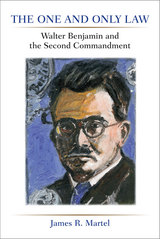 The One and Only Law: Walter Benjamin and the Second Commandment
James R. Martel
University of Michigan Press, 2014 Walter Benjamin’s “Critique of Violence,” widely considered his final word on law, proposes that all manifestations of law are false stand-ins for divine principles of truth and justice that are no longer available to human beings. However, he also suggests that we must have law—we are held under a divine sanction that does not allow us to escape our responsibilities. James R. Martel argues that this paradox is resolved by considering that, for Benjamin, there is only one law that we must obey absolutely—the Second Commandment against idolatry. What remains of law when its false bases of authority are undermined would be a form of legal and political anarchism, quite unlike the current system of law based on consistency and precedent. Martel engages with the ideas of key authors including Alain Badiou, Immanuel Kant, and H.L.A. Hart in order to revisit common contemporary assumptions about law. He reveals how, when treated in constellation with these authors, Benjamin offers a way for human beings to become responsible for their own law, thereby avoiding the false appearance of a secular legal practice that remains bound by occult theologies and fetishisms.
The One and the Many: A Contemporary Thomistic Metaphysics
W. Norris Clarke, S.J.
University of Notre Dame Press, 2001 When it is taught today, metaphysics is often presented as a fragmented view of philosophy that ignores the fundamental issues of its classical precedents. Eschewing these postmodern approaches, W. Norris Clarke finds an integrated vision of reality in the wisdom of Aquinas and here offers a contemporary version of systematic metaphysics in the Thomistic tradition.
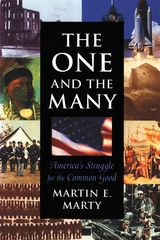 The One and the Many: America’s Struggle for the Common Good
Martin E. Marty
Harvard University Press, 1997 E pluribus unum no longer holds. Out of the many have come as many claims and grievances, all at war with the idea of one nation undivided. The damage thus done to our national life, as too few Americans seek a common good, is Martin Marty's concern. His book is an urgent call for repair and a personal testament toward resolution.
A world-renowned authority on religion and ethics in America, Marty gives a judicious account (itself a rarity and a relief in our day of uncivil discourse) of how the body politic has been torn between the imperative of one people, one voice, and the separate urgings of distinct identities--racial, ethnic, religious, gendered, ideological, economic. Foreseeing an utter deadlock in public life, with devastating consequences, if this continues, he envisions steps we might take to carry America past the new turbulence.
While the grand story of oneness eludes us (and probably always will), Marty reminds us that we do have a rich, ever-growing, and ever more inclusive repertory of myths, symbols, histories, and, most of all, stories on which to draw. He pictures these stories, with their diverse interpretations, as part of a conversation that crosses the boundaries of groups. Where argument polarizes and deafens, conversation is open ended, guided by questions, allowing for inventiveness, fair play, and dignity for all. It serves as a medium in Marty's broader vision, which replaces the restrictive, difficult, and perhaps unattainable ideal of "community" with the looser, more workable idea of "association."
An "association of associations" is what Marty contemplates, and for the spirit and will to promote it he looks to eighteenth-century motifs of sentiment and affection, convergences of intellect and emotion that develop from shared experience. And as this book so eloquently reminds us, America, however diverse, is an experience we all share.
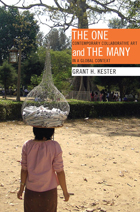 The One and the Many: Contemporary Collaborative Art in a Global Context
Grant H. Kester
Duke University Press, 2011 Collaborative and collective art practices have proliferated around the world over the past fifteen years. In The One and the Many, Grant H. Kester provides an overview of the broader continuum of collaborative art, ranging from the work of artists and groups widely celebrated in the mainstream art world, such as Thomas Hirschhorn, Superflex, Francis Alÿs, and Santiago Sierra, to the less-publicized projects of groups, such as Park Fiction in Hamburg, Networking and Initiatives for Culture and the Arts in Myanmar, Ala Plastica in Argentina, Huit Facettes in Senegal, and Dialogue in central India. The work of these groups often overlaps with the activities of NGOs, activists, and urban planners. Kester argues that these parallels are symptomatic of an important transition in contemporary art practice, as conventional notions of aesthetic autonomy are being redefined and renegotiated. He describes a shift from a concept of art as something envisioned beforehand by the artist and placed before the viewer, to the concept of art as a process of reciprocal creative labor. The One and the Many presents a critical framework that addresses the new forms of agency and identity mobilized by the process of collaborative production.
The One and the Others: Metaphysics, Poetry, and the Antinomies of Plato’s "Parmenides"
Andrew Cutrofello
Northwestern University Press, 2026 An original account of Western metaphysics based on Plato’s Parmenides
At the end of Plato’s Parmenides, Parmenides concludes that “whether ‘the One’ is or is not, it and ‘the Others’ both are and are not, and both appear and do not appear, all things in all ways.” Throughout the history of philosophy various attempts have been made to make sense of Plato’s puzzling dialectical exercise. In this ambitious book Andrew Cutrofello shows how Kant and Hegel extended it, how contemporary philosophers, including Graham Priest and Alain Badiou, have reinterpreted it, and how poets such as Dante, Shakespeare, Blake, Wordsworth, and Susan Howe have channeled it. What emerges is an original conception of the history of metaphysics as a series of antinomies, and of metaphysical poetry as a type of antinomianism.
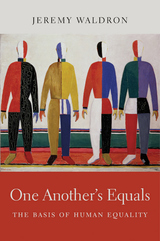 One Another’s Equals: The Basis of Human Equality
Jeremy Waldron
Harvard University Press, 2017 An enduring theme of Western philosophy is that we are all one another’s equals. Yet the principle of basic equality is woefully under-explored in modern moral and political philosophy. In a major new work, Jeremy Waldron attempts to remedy that shortfall with a subtle and multifaceted account of the basis for the West’s commitment to human equality.
What does it mean to say we are all one another’s equals? Is this supposed to distinguish humans from other animals? What is human equality based on? Is it a religious idea, or a matter of human rights? Is there some essential feature that all human beings have in common? Waldron argues that there is no single characteristic that serves as the basis of equality. He says the case for moral equality rests on four capacities that all humans have the potential to possess in some degree: reason, autonomy, moral agency, and the ability to love. But how should we regard the differences that people display on these various dimensions? And what are we to say about those who suffer from profound disability—people whose claim to humanity seems to outstrip any particular capacities they have along these lines?
Waldron, who has worked on the nature of equality for many years, confronts these questions and others fully and unflinchingly. Based on the Gifford Lectures that he delivered at the University of Edinburgh in 2015, One Another’s Equals takes Waldron’s thinking further and deeper than ever before.
 One Belt One Road: Chinese Power Meets the World
Eyck Freymann
Harvard University Press, 2021 In 2013, Chinese leader Xi Jinping announced a campaign for national rejuvenation. The One Belt One Road initiative, or OBOR, has become the largest infrastructure program in history. Nearly every Chinese province, city, major business, bank, and university have been mobilized to serve it, spending hundreds of billions of dollars overseas building ports and railroads, laying fiber cables, and launching satellites. Using a trove of Chinese sources, author Eyck Freymann argues these infrastructure projects are a sideshow. OBOR is primarily a campaign to restore an ancient model in which foreign emissaries paid tribute to the Chinese emperor, offering gifts in exchange for political patronage. Xi sees himself as a sort of modern-day emperor, determined to restore China’s past greatness.
Many experts assume that Xi’s nakedly neo-imperial scheme couldn’t possibly work. Freymann shows how wrong they are. China isn’t preying on victims, Freymann argues. It’s attracting willing partners—including Western allies—from Latin America to Southeast Asia to the Persian Gulf. Even in countries where OBOR megaprojects fail, Freymann finds that political leaders still want closer ties with China.
Freymann tells the monumental story of Xi’s project on the global stage. Drawing on primary documents in five languages, interviews with senior officials, and on-the-ground case studies from Malaysia to Greece, Russia to Iran, Freymann pulls back the veil of propaganda about OBOR, giving readers a page-turning world tour of the burgeoning Chinese empire, a guide for understanding China’s motives and tactics, and clear recommendations for how the West can compete.
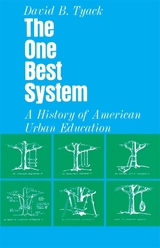 The One Best System: A History of American Urban Education
David Tyack
Harvard University Press, 1974 The One Best System presents a major new interpretation of what actually happened in the development of one of America's most influential institutions. At the same time it is a narrative in which the participants themselves speak out: farm children and factory workers, frontier teachers and city superintendents, black parents and elite reformers. And it encompasses both the achievements and the failures of the system: the successful assimilation of immigrants, racism and class bias; the opportunities offered to some, the injustices perpetuated for others.
David Tyack has placed his colorful, wide-ranging view of history within a broad new framework drawn from the most recent work in history, sociology, and political science. He looks at the politics and inertia, the ideologies and power struggles that formed the basis of our present educational system. Using a variety of social perspectives and methods of analysis, Tyack illuminates for all readers the change from village to urban ways of thinking and acting over the course of more than one hundred years.
 One Body: An Essay in Christian Sexual Ethics
Alexander R. Pruss
University of Notre Dame Press, 2013
This important philosophical reflection on love and sexuality from a broadly Christian perspective is aimed at philosophers, theologians, and educated Christian readers. Alexander R. Pruss focuses on foundational questions on the nature of romantic love and on controversial questions in sexual ethics on the basis of the fundamental idea that romantic love pursues union of two persons as one body.
One Body begins with an account, inspired by St. Thomas Aquinas, of the general nature of love as constituted by components of goodwill, appreciation, and unitiveness. Different forms of love, such as parental, collegial, filial, friendly, fraternal, or romantic, Pruss argues, differ primarily not in terms of goodwill or appreciation but in terms of the kind of union that is sought. Pruss examines romantic love as distinguished from other kinds of love by a focus on a particular kind of union, a deep union as one body achieved through the joint biological striving of the sort involved in reproduction. Taking the account of the union that romantic love seeks as a foundation, the book considers the nature of marriage and applies its account to controversial ethical questions, such as the connection between love, sex, and commitment and the moral issues involving contraception, same-sex activity, and reproductive technology. With philosophical rigor and sophistication, Pruss provides carefully argued answers to controversial questions in Christian sexual ethics.
"This is a terrific—really quite extraordinary—work of scholarship. It is quite simply the best work on Christian sexual ethics that I have seen. It will become the text that anyone who ventures into the field will have to grapple with—a kind of touchstone. Moreover, it is filled with arguments with which even secular writers on sexual morality will have to engage and come to terms." — Robert P. George, Princeton University
"One Body is an excellent piece of philosophical-theological reflection on the nature of sexuality and marriage. This book has the potential to become a standard go-to text for professors and students working on sex ethics issues, whether in philosophy or theology, both for the richness of its arguments, and the scope of its coverage of cases. " —Christopher Tollefsen, University of South Carolina
"Alexander Pruss here develops sound and humane answers to the whole range of main questions about human sexual and reproductive choices. His principal argument for the key answers is very different from the one I have articulated over the past fifteen years. But his argumentation is at every point attractively direct, careful, energetic in framing and responding to objections, and admirably attentive to realities and the human goods at stake." —John Finnis, University of Oxford
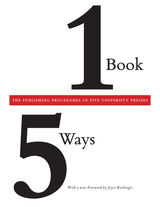 One Book/Five Ways: The Publishing Procedures of Five University Presses
Edited by the Association of American University Presses and Joyce Kachergis
University of Chicago Press, 1994 A testament to the ingenuity of scholarly presses, One Book/Five Ways is a fascinating experiment in comparative publishing. This book records the history of a single manuscript, entitled No Time for Houseplants, submitted to five different university presses—Chicago, MIT, North Carolina, Texas, and Toronto—and then actually published by the University of Oklahoma Press. Each of the five model publishers agreed to treat the book as a real project accepted for publication and to compile a log of procedures they followed. These logs include correspondence, budgets, forms, layouts, and specifications, providing an insider's look at the path a manuscript takes through the various departments of each press, from editorial to marketing.
With a new Foreword discussing changes in publishing since 1978 and an Afterword commenting on the actual publication of No Time for Houseplants, One Book/Five Ways is a unique educational tool for anyone interested in the publishing process.
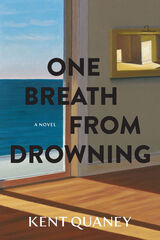 One Breath from Drowning
Kent Quaney
University of Wisconsin Press, 2022 One Breath from Drowning tracks the foundering relationship between Ryan Jensen, a lapsed Mormon from Utah and heretofore closeted aspiring actor, and Sam Carter, a cocky party- and surf-loving Australian realtor whose family connections and wealth have buffered him from the most severe consequences of his impulsive nature and poor decision-making. Their genuine yet tumultuous love is strained by their tendencies for self-deception and avoidance, their secrets and their baggage, and the ways their past choices haunt their present.
The two men find moments of joy and humor together in Sydney, but arrests, infidelities, and addictions force them to finally face the issues holding them back. Though it initially presents as a love story, One Breath from Drowning is a tale of spiritual bildungsroman told in parallel. Ryan and Sam’s conflict and love ultimately push each of them to evolve, their transformation not the result of reckless acts of escape but the product of the fitful and difficult work of grappling with their complex realities.
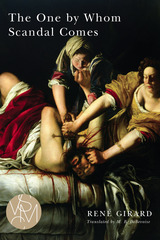 The One by Whom Scandal Comes
René Girard (Translated by M. B. DeBevoise)
Michigan State University Press, 2014 “Why is there so much violence in our midst?” René Girard asks. “No question is more debated today. And none produces more disappointing answers.” In Girard’s mimetic theory it is the imitation of someone else’s desire that gives rise to conflict whenever the desired object cannot be shared. This mimetic rivalry, Girard argues, is responsible for the frequency and escalating intensity of human conflict. For Girard, human conflict comes not from the loss of reciprocity between humans but from the transition, imperceptible at first but then ever more rapid, from good to bad reciprocity. In this landmark text, Girard continues his study of violence in light of geopolitical competition, focusing on the roots and outcomes of violence across societies latent in the process of globalization. The volume concludes in a wide-ranging interview with the Sicilian cultural theorist Maria Stella Barberi, where Girard’s twenty-first century emphases on the continuity of all religions, global conflict, and the necessity of apocalyptic thinking emerge.
 One Case at a Time: Judicial Minimalism on the Supreme Court
Cass R. Sunstein
Harvard University Press, 1999 Abortion, affirmative action, the "right to die," pornography and free speech, homosexuality and sex discrimination: as eagerly as the Supreme Court's rulings on these hot issues are awaited and as intently as they're studied, they never seem to settle anything once and for all. But something is settled in the process--in the incremental approach--as Cass Sunstein shows us in this instructive book.
One of America's preeminent constitutional scholars, Sunstein mounts a defense of the most striking characteristic of modern constitutional law: the inclination to decide one case at a time. Examining various controversies, he shows how--and why--the Court has avoided broad rulings on issues from the legitimacy of affirmative action to the "right to die," and in doing so has fostered rather than foreclosed public debate on these difficult topics. He offers an original perspective on the right of free speech and the many novel questions raised by Congress's efforts to regulate violent and sexual materials on new media such as the Internet and cable television. And on the relationship between the Constitution and homosexuality and sex discrimination, he reveals how the Court has tried to ensure against second-class citizenship--and the public expression of contempt for anyone--while leaving a degree of flexibility to the political process.
One Case at a Time also lays out, and celebrates, the remarkable constellation of rights--involving both liberty and equality--that now commands a consensus in American law. An authoritative guide to the Supreme Court, the book offers a new understanding of the American Constitution, and of the relationship between democracy and constitutionalism, and between rights and self-government.
The One Christ
David Vincent Meconi
Catholic University of America Press, 2013 By treating Augustine's passages on deification both chronologically and constructively, Meconi situates Augustine in a long chorus of Christian pastors and theologians who understand the essence of Christianity as the human person's total and transformative union with God.
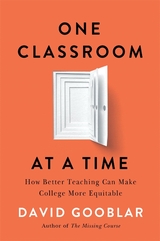 One Classroom at a Time: How Better Teaching Can Make College More Equitable
David Gooblar
Harvard University Press, 2025 From the author of The Missing Course, an essential guide to pedagogy that serves all members of an ever more diverse undergraduate population.
A century ago, a typical US college campus was a sanctuary of privilege, with white men of means constituting nearly the entire student population. Today, half of US undergraduates live at or near the poverty line, and universities are more diverse than ever. But teaching and curricula have not caught up, resulting in stark inequities. Black and Hispanic students graduate at lower rates than their white and Asian counterparts, economically insecure and disabled students face persistent disadvantages, and in STEM disciplines gender imbalances remain the norm.
One Classroom at a Time provides practical, research-based recommendations for teachers and administrators who want to narrow such academic gaps. David Gooblar explains the psychological hardships facing many marginalized students—including stereotype threat and belonging uncertainty—and provides detailed remedies. This wide-ranging guide also offers advice for mitigating burdens of financial insecurity and designing classes that work for all students regardless of disabilities. The emphasis throughout is on helping instructors and administrators understand not just the principles of equitable pedagogy but also the reasoning; not just what works, but why it works.
In the twenty-first century, college courses shouldn’t be built for imaginary students of yesteryear. One Classroom at a Time shows how we can tailor pedagogy to the students of today, so that all of them can secure the education and the success they deserve.
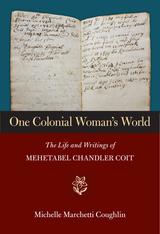 One Colonial Woman's World: The Life and Writings of Mehetabel Chandler Coit
Michelle Marchetti Coughlin
University of Massachusetts Press, 2012 This book reconstructs the life of Mehetabel Chandler Coit (1673–1758), the author of what may be the earliest surviving diary by an American woman. A native of Roxbury, Massachusetts, who later moved to Connecticut, she began her diary at the age of fifteen and kept it intermittently until she was well into her seventies. A previously overlooked resource, the diary contains entries on a broad range of topics as well as poems, recipes, folk and herbal medical remedies, religious meditations, and financial accounts. An extensive collection of letters by Coit and her female relatives has also survived, shedding further light on her experiences.
Michelle Marchetti Coughlin combs through these writings to create a vivid portrait of a colonial American woman and the world she inhabited. Coughlin documents the activities of daily life as well as dramas occasioned by war, epidemics, and political upheaval. Though Coit's opportunities were circumscribed by gender norms of the day, she led a rich and varied life, not only running a household and raising a family, but reading, writing, traveling, transacting business, and maintaining a widespread network of social and commercial connections. She also took a lively interest in the world around her and played an active role in her community.
Coit's long life covered an eventful period in American history, and this book explores the numerous—and sometimes surprising—ways in which her personal history was linked to broader social and political developments. It also provides insight into the lives of countless other colonial American women whose history remains largely untold.
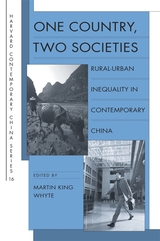 One Country, Two Societies: Rural-Urban Inequality in Contemporary China
Martin King Whyte
Harvard University Press, 2010 This timely and important collection of original essays analyzes China’s foremost social cleavage: the rural–urban gap. It is now clear that the Chinese communist revolution, though professing dedication to an egalitarian society, in practice created a rural order akin to serfdom, in which 80 percent of the population was effectively bound to the land. China is still struggling with that legacy. The reforms of 1978 changed basic aspects of economic and social life in China’s villages and cities and altered the nature of the rural-urban relationship. But some important institutions and practices have changed only marginally or not at all, and China is still sharply divided into rural and urban castes with different rights and opportunities in life, resulting in growing social tensions.
The contributors, many of whom conducted extensive fieldwork, examine the historical background of rural–urban relations; the size and trend in the income gap between rural and urban residents in recent years; aspects of inequality apart from income (access to education and medical care, the digital divide, housing quality and location); experiences of discrimination, particularly among urban migrants; and conceptual and policy debates in China regarding the status and treatment of rural residents and urban migrants.
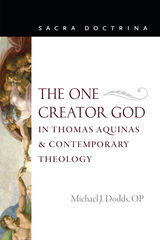 The One Creator God in Thomas Aquinas and Contemporary Theology
Michael J. Dodds, OP
Catholic University of America Press, 2020 This book provides a fundamental introduction to Aquinas's theology of the One Creator God. Aimed at making that thought accessible to contemporary audiences, it gives a basic explanation of his theology while showing its compatibility with contemporary science and its relevance to current theological issues. Opening with a brief account of Aquinas’s life, it then describes the purpose and nature of the Summa Theologica and gives a short review of current varieties of Thomism. Without neglecting other works, it then focuses primarily on the discussion of the One God in the first part of the Summa Theologica. God's transcendence and immanence is a recurrent theme in that discussion. Evidence of God's immanent causality in the natural world grounds Aquinas's five arguments for the existence of God (the Five Ways) which then open onto God's transcendence. The subsequent discussion of the divine attributes builds on the modes of God's causality established in the Five Ways. It also shows the need for a language of analogy to preserve God's transcendence and prevent us from reducing God to the level of creatures, even as qualities such as "goodness" and "love," which we first know from creatures, are applied to God. The discussion of God's providence and governance establishes that the transcendent Creator God is most intimately present in creation. God acts in all creatures in a way that does not diminish their proper causality, but is rather its source. As there is no contradiction between God's transcendence and immanence, so there is no competition between the primary causality of God and the secondary causality of creatures. Empirical science, which is limited by its method to the secondary causality of creatures, is shown to be compatible with the broader discipline of theology which also embraces the primary causality of the Creator.
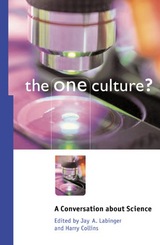 The One Culture?: A Conversation about Science
Edited by Jay A. Labinger and Harry Collins
University of Chicago Press, 2001 So far the "Science Wars" have generated far more heat than light. Combatants from one or the other of what C. P. Snow famously called "the two cultures" (science versus the arts and humanities) have launched bitter attacks but have seldom engaged in constructive dialogue about the central issues. In The One Culture?, Jay A. Labinger and Harry Collins have gathered together some of the world's foremost scientists and sociologists of science to exchange opinions and ideas rather than insults. The contributors find surprising areas of broad agreement in a genuine conversation about science, its legitimacy and authority as a means of understanding the world, and whether science studies undermines the practice and findings of science and scientists.
The One Culture? is organized into three parts. The first consists of position papers written by scientists and sociologists of science, which were distributed to all the participants. The second presents commentaries on these papers, drawing out and discussing their central themes and arguments. In the third section, participants respond to these critiques, offering defenses, clarifications, and modifications of their positions.
Who can legitimately speak about science? What is the proper role of scientific knowledge? How should scientists interact with the rest of society in decision making? Because science occupies such a central position in the world today, such questions are vitally important. Although there are no simple solutions, The One Culture? does show the reader exactly what is at stake in the Science Wars, and provides a valuable framework for how to go about seeking the answers we so urgently need.
Contributors include:
Constance K. Barsky, Jean Bricmont, Harry Collins, Peter Dear, Jane
Gregory, Jay A. Labinger, Michael Lynch, N. David Mermin, Steve
Miller, Trevor Pinch, Peter R. Saulson, Steven Shapin, Alan Sokal,
Steven Weinberg, Kenneth G. Wilson
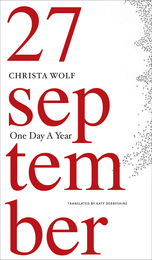 One Day a Year: 2001–2011
Christa Wolf
Seagull Books, 2017 During a 1960 interview, East German writer Christa Wolf was asked a curious question: would she describe in detail what she did on September 27th? Fascinated by considering the significance of a single day over many years, Wolf began keeping a detailed diary of September 27th, a practice which she carried on for more than fifty years until her death in 2011. The first volume of these notes covered 1960 through 2000 was published to great acclaim more than a decade ago. Now translator Katy Derbyshire is bringing the September 27th collection up to date with One Day a Year—a collection of Wolf’s notes from the last decade of her life.
The book is both a personal record and a unique document of our times. With her characteristic precision and transparency, Wolf examines the interplay of the private, subjective, and major contemporary historical events. She writes about Germany after 9/11, about her work on her last great book City of Angels, and also about her exhausting confrontation with old age. One Day a Year is a compelling and personal glimpse into the life of one of the world’s greatest writers.
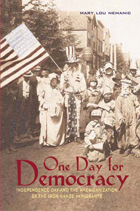 One Day for Democracy: Independence Day and the Americanization of Iron Range Immigrants
Mary Lou Nemanic
Ohio University Press, 2007 Just before the turn of the twentieth century, immigrants from eastern and southern Europe who had settled in mining regions of Minnesota formed a subculture that combined elements of Old World traditions and American culture. Their unique pluralistic version of Americanism was expressed in Fourth of July celebrations rooted in European carnival traditions that included rough games, cross-dressing, and rowdiness.In One Day for Democracy, Mary Lou Nemanic traces the festive history of Independence Day from 1776 to the twentieth century. The author shows howthese diverse immigrant groups on the Minnesota Iron Range created their own version of the celebration, the Iron Range Fourth of July.As mass-mediated popular culture emerged in the twentieth century, Fourth of July celebrations in the Iron Range began to include such popular cultureelements as beauty queens and marching bands. Nemanic documents the enormous influence of these changes on this isolated region and highlights the complex interplay between popular culture and identity construction.But this is not a typical story of assimilation or ethnic separation. Instead, One Day for Democracy reveals how more than thirty different ethnic groupswho shared identities as both workers and new Americans came together in a remote mining region to create their own subculture.
One Day in the Life of Ivan Denisovich: A Critical Companion
Alexis Klimoff
Northwestern University Press, 1996 This companion to Aleksandr Solzhenitsyn's enduring classic about a day in the life of a Soviet gulag work camp includes a general introduction discussing the work in the context of the author's oeuvre as well as its place within the Russian literary tradition. Also included are fascinating primary sources and background materials, an annotated bibliography, and discussions of the work by leading scholars Robert Louis Jackson, Richard Tempest, and Dariusz Tolczyk. Combining scholarship with accessibility, this critical companion--part of the acclaimed AATSEEL series--illuminates a great work of literature and will enhance its appreciation by students and teachers.
One Day of Life is Life
Joan Maragall, Translated by Ronald Puppo
Fum d'Estampa Press, 2020 Winner of the 2021 Ramon Llull Prize for Literary Translation
This bilingual collection of both Maragall’s poetry and prose has been edited and translated by Ronald Puppo, a research fellow and translator at the University of Vic. His keen eye and expertise on Maragall comes across in droves as he takes what are arguably Catalan literature’s finest moments and turns them into eminently readable and enjoyable English language poems. Also included in this collection are some of Maragall’s pieces of prose work and personal letters that shed light onto the man himself. Accompanying all this are Puppo’s own in-depth comments and insights.
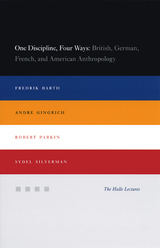 One Discipline, Four Ways: British, German, French, and American Anthropology
Fredrik Barth, Robert Parkin, Andre Gingrich, and Sydel Silverman
University of Chicago Press, 2005 One Discipline, Four Ways offers the first book-length introduction to the history of each of the four major traditions in anthropology—British, German, French, and American. The result of lectures given by distinguished anthropologists Fredrik Barth, Andre Gingrich, Robert Parkin, and Sydel Silverman to mark the foundation of the Max Planck Institute for Social Anthropology, this volume not only traces the development of each tradition but considers their impact on one another and assesses their future potentials.
Moving from E. B. Taylor all the way through the development of modern fieldwork, Barth reveals the repressive tendencies that prevented Britain from developing a variety of anthropological practices until the late 1960s. Gingrich, meanwhile, articulates the development of German anthropology, paying particular attention to the Nazi period, of which surprisingly little analysis has been offered until now. Parkin then assesses the French tradition and, in particular, its separation of theory and ethnographic practice. Finally, Silverman traces the formative influence of Franz Boas, the expansion of the discipline after World War II, and the "fault lines" and promises of contemporary anthropology in the United States.
 One Dog Happy
Molly McNett
University of Iowa Press, 2008
In this award-winning debut collection, Molly McNett couples laugh-out-loud dialogue and wry observation reminiscent of Flannery O’Connor with disquieting strains of dashed hope, troubled sexuality, and disillusionment.
The adults in these stories can seem as hapless and helpless as the younger characters. Two neglected daughters use the language of clothes to cope with their parents’ divorce and their father’s mail-order bride. A young girl’s bizarre sexual fantasies help her gain control over the chaos of her family life. A gang of teenagers accuse a farmer of bestiality. A divorced father tries to create a pony-filled world that might appeal to his daughters. In the title story, Mr. Bob, the minister’s housesitter, loses a dog but finds someone to believe in. And in “Helping,” the darkest story in this amazing collection, Ruthie’s anger conquers her religious faith when she takes care of a severely disabled child.
We meet McNett’s endearing, often foolish characters at a point when their minds are open to manipulation by the people and events around them, and the conclusions they draw are heartbreaking: I am not allowed weakness; life treats people unequally; perhaps there is no God. Yet throughout they find quiet moments of possibility, courage, and a return to faith and comfort.
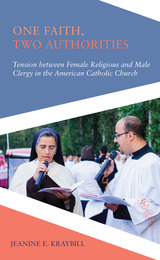 One Faith, Two Authorities: Tension between Female Religious and Male Clergy in the American Catholic Church
Jeanine E. Kraybill
Temple University Press, 2019 While female religious have grown to possess a sense of personal authority in issues impacting the laity, and have come to engage in social-issue-oriented activities, religious institutions have traditionally viewed men as the decision-makers. One Faith, Two Authorities examines the tensions of policy and authority within the gendered nature of the Catholic Church. Jeanine Kraybilllooks at the influence of Catholic elites—specifically within the U.S. Conference of Catholic Bishops and the Leadership Conference of Women Religious—and their opinions on public policy and relevant gender dynamics with regard to healthcare, homosexuality, immigration, and other issues. She considers the female religious’ inclusive positions as well as their opposition to ACA for bills that would be rooted in institutional positions on procreation, contraception, or abortion. Kraybill also systematically examines the claims of the 2012 Doctrinal Assessment against the Leadership Conference of Women Religious. One Faith, Two Authorities considerswhether the sisters and the male clergy are in fact in disagreement about social justice and healthcare issues and/or if women religious have influence.
 One First Love: The Letters of Ellen Louisa Tucker to Ralph Waldo Emerson
Ellen Louisa (Emerson) Tucker
Harvard University Press Letters, poems, and fragments of a journal are the only first-hand reflection we have of a personality of major importance in the life of Ralph Waldo Emerson, that of the beautiful and gifted Ellen Louisa Tucker, whom he married in 1829. Blithe, humorous, full of charm and candor, the engaging seventeen-year-old had captured wholly the heart of the serious young minister. The depth and transforming effect on him of their happy love is a universally acknowledged biographical fact, as is the tragic, shattering effect of her early death in 1831.Emerson's letters to Ellen Tucker have been destroyed, but several of his poems to her--two of them hitherto unpublished--are included with her letters in this volume. This romantic chronicle of two intelligent, active young people takes on a poignant significance as a monument to a love that affected Emerson profoundly during the years of his most critical personal decisions.The letters are owned by the Ralph Waldo Emerson Memorial Association. They are edited and presented here by Emerson's great-granddaughter, a trustee of the Association, as the most direct commemoration possible of a vital experience, intimate and central to the Emerson story.
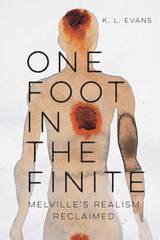 One Foot in the Finite: Melville's Realism Reclaimed
K. L. Evans
Northwestern University Press, 2018 One Foot in the Finite inspires a radical shift in our view of Melville’s project in Moby-Dick, for its guiding notion is that Melville uses his book to call into question the naturalism that distinguishes the early modern period in Europe. Naturalism is not only the idea that reality is exhausted by nature, or that there exists a domain of physical entities subject to autonomous laws and unaffected by human ingenuity; it also implies a counterpart, a world of pretense and deception, a domain of mental entities ontologically distinct from physical entities and therefore constituting a different realm. To naturalists, whales are part of the background of existing objects against which man assembles his various, subjective, rather arbitrary interpretations. But in Moby-Dick Melville casts upon the world a more ingenious eye, one free of the dualist veil. He confronts a basic misconception: that the contents of consciousness comprise a different order from physical life. He rubs out the dividing line modernity has drawn between the human world of names or concepts and the nonhuman world of plants, creatures, geological features, and natural forces. Melville’s philosophizing, carried by fiction, has dramatic consequence. It overturns our view of language as a system of mental representations that might turn out to represent falsely.
 One for the Girls!: The Pleasures and Practices of Reading Women's Porn
Clarissa Smith
Intellect Books, 2007 We usually think of women as the victims of pornography rather than its consumers. Whether appearing in films, peering provocatively from the pages of magazines, or posing on explicit Web-sites, women are considered the dehumanized objects of unseen lascivious male viewers. But in her controversial new book One for the Girls!, Clarissa Smith debunks this myth and challenges women to read, watch, and enjoy pornography on their own terms. Focusing on the British magazine For Women, Smith looks at its readers’ responses to male pinups and erotica and explores the intricacies of women’s unique reactions to pornography. “Clarissa Smith has achieved something special with her new proffering from her masculinities repertoire. Smith’s text is groundbreaking, multidisciplinary and—equally importantly—extremely readable. It is the last point perhaps that really sets this work apart, as One for the Girls has a great deal to offer both the specialist academic and the general reader. Clarissa Smith’s accessible style allows readers with little prior knowledge of critical theory, cultural studies or the 1980s pornography debate, to not only understand these discourses, but to develop a strong grasp of their impact in this context.”—Michelle Parsons, Transition Tradition
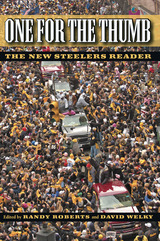 One for the Thumb: The New Steelers Reader
Roberts, Randy
University of Pittsburgh Press, 2006
On February 5, 2006, the Pittsburgh Steelers joined the ranks of the elite teams in National Football League history, celebrating their fifth Super Bowl victory. From an unspectacular 7-5 start, to completing the greatest playoff run ever, to the fairy tale ending of Jerome Bettis's Hall of Fame career and the vindication of Bill Cowher's coaching tenure, the 2005 season was not only one for the thumb, but “truly one for the ages.”
One for the Thumb is a collection of the best writing about the fabled franchise by local and national sportswriters, and former players. It covers the team's history from Art Rooney Sr.'s purchase of the NFL franchise in 1933 for $2,500 to their Super Bowl XL victory. From their frustrating early days as the Pirates, Steagles, and Card-Pitts, through their four Super Bowl wins in the 1970s, to the fateful day in 2004 when they selected Ben Roethlisberger as the eleventh overall pick in the draft, One for the Thumb captures the essence of the team whose identity is forever linked with the spirit of the hardworking, blue-collar city it represents.
From immortals Bobby Layne, Ernie Stautner, and John Henry Johnson, to Chuck Noll, Terry Bradshaw, Mean Joe Greene, Rocky Bleier, and Neil O'Donnell, to current greats Troy Polamalu, Jerome Bettis, Ben Roethlisberger, and Bill Cowher, One for the Thumb is the definitive anthology of the Pittsburgh Steelers--a must-read for all fans of the team and the game of football.
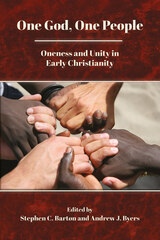 One God, One People: Oneness and Unity in Early Christianity
Stephen C. Barton
SBL Press, 2023 From ancient times to the present day, utopian social ideas have made the unity of humankind a central concern. In the face of the threats to civic peace and harmony caused by misrule, factions, inequality, and moral weakness, philosophical and religious traditions in antiquity gave considered attention to the attainment of oneness both as an ideal and as an embodied practice. In this volume, scholars of ancient history, early Judaism, and biblical studies come together to show that ideas of unity and practices of oneness were grounded in larger conceptions of worldview, cosmic order, and power, with theological ideas such as the oneness of God laying an important foundation. In particular, contributors focus on how early Christians, with their inherited Jewish, Greek, and Roman traditions, reinterpreted oneness in light of their new identity as “members of Christ” and how they put it into practice. Contributors are Stephen C. Barton, Anna Sieges-Beal, Max Botner, Andrew J. Byers, Carsten Claußen, Kylie Crabbe, Robbie Griggs, James R. Harrison, Walter J. Houston, T. J. Lang, Jutta Leonhardt-Balzer, John-Paul Lotz, Lynette Mitchell, Nicholas J. Moore, Elizabeth E. Shively, Julien C. H. Smith, and Alan Thompson.
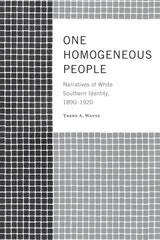 One Homogeneous People: Narratives of White Southern Identity, 1890–1920
Trent A. Watts
University of Tennessee Press, 2010
Southerners have a reputation as storytellers, as a people fond of telling about family, community, and the southern way of life. A compelling book about some of those stories and their consequences, One Homogeneous People examines the forging and the embracing of southern “pan-whiteness” as an ideal during the volatile years surrounding the turn of the twentieth century.
Trent Watts argues that despite real and signifcant divisions within the South along lines of religion, class, and ethnicity, white southerners—especially in moments of perceived danger—asserted that they were one people bound by a shared history, a love of family, home, and community, and an uncompromising belief in white supremacy. Watts explores how these southerners explained their region and its people to themselves and other Americans through narratives found in a variety of forms and contexts: political oratory, fiction, historiography, journalism, correspondence, literary criticism, and the built environment.
Watts examines the assertions of an ordered, homogeneous white South (and the threats to it) in the unsettling years following the end of Reconstruction through the early 1900s. In three extended essays on related themes of race and power, the book demonstrates the remarkable similarity of discourses of pan-whiteness across formal and generic lines. In an insightful concluding essay that focuses on an important but largely unexamined institution, Mississippi’s Neshoba County Fair, Watts shows how narratives of pan-white identity initiated in the late nineteenth century have persisted to the present day.
Written in a lively style, One Homogeneous People is a valuable addition to the scholarship on southern culture and post-Reconstruction southern history.
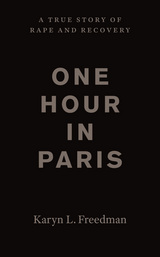 One Hour in Paris: A True Story of Rape and Recovery
Karyn L. Freedman
University of Chicago Press, 2014 In this powerful memoir, philosopher Karyn L. Freedman travels back to a Paris night in 1990 when she was twenty-two and, in one violent hour, her life was changed forever by a brutal rape. One Hour in Paris takes the reader on a harrowing yet inspirational journey through suffering and recovery both personal and global. We follow Freedman from an apartment in Paris to a French courtroom, then from a trauma center in Toronto to a rape clinic in Africa. At a time when as many as one in three women in the world have been victims of sexual assault and when many women are still ashamed to come forward, Freedman’s book is a moving and essential look at how survivors cope and persevere.
At once deeply intimate and terrifyingly universal, One Hour in Paris weaves together Freedman’s personal experience with the latest philosophical, neuroscientific, and psychological insights on what it means to live in a body that has been traumatized. Using her background as a philosopher, she looks at the history of psychological trauma and draws on recent theories of posttraumatic stress disorder and neuroplasticity to show how recovery from horrific experiences is possible. Through frank discussions of sex and intimacy, she explores the consequences of sexual violence for love and relationships, and she illustrates the steep personal cost of sexual violence and the obstacles faced by individual survivors in its aftermath. Freedman’s book is an urgent call to face this fundamental social problem head-on, arguing that we cannot continue to ignore the fact that sexual violence against women is rooted in gender inequalities that exist worldwide—and must be addressed.
One Hour in Paris is essential reading for survivors of sexual violence as well as an invaluable resource for therapists, mental health professionals, and family members and friends of victims.
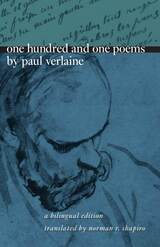 One Hundred and One Poems by Paul Verlaine: A Bilingual Edition
Paul Verlaine
University of Chicago Press, 1999 French poet Paul Verlaine, a major representative of the Symbolist Movement during the latter half of the nineteenth century, was one of the most gifted and prolific poets of his time. Norman Shapiro's superb translations display Verlaine's ability to transform into timeless verse the essence of everyday life and make evident the reasons for his renown in France and throughout the Western world.
"Shapiro's skillfully rhymed formal translations are outstanding." —St. Louis Post-Dispatch "Best Book of 1999"
"Paul Verlaine's rich, stylized, widely-variable oeuvre can now be traced through his thirty years of published volumes, from 1866 to 1896, in a set of luminous new translations by Norman Shapiro. . . . [His] unique translations of this whimsical, agonized music are more than adequate to bring the multifarious Verlaine to a new generation of English speakers." —Genevieve Abravanel, Harvard Review
"Shapiro demonstrates his phenomenal ability to find new rhymes and always follows Verlaine's rhyme schemes." —Carrol F. Coates, ATA Chronicle
One Hundred Birds Taught Me to Fly: The Art of Seeking God
Ashley Mae Hoiland
Neal A. Maxwell Institute for Religious Scholarship, 2016 One Hundred Birds Taught Me to Fly is for restless souls who desire to know God more deeply. Ashley Mae Hoiland bids us follow her down “the hallowed and well-trodden path between the heart and mind,” where glimpses of godliness are discovered in rainstorms, bus rides, temples, and mountains. As a Latter-day Saint, Hoiland explores the complexities of faith in everyday life where laughter and creativity matter as much as faith, hope, and charity.
One Hundred Bottles
By Ena Lucía Portela
University of Texas Press, 2010 One Hundred Bottles, with its intersecting characters and unresolved whodunits, can be read as a murder mystery. But it's really a survivor's story. In a voice that blends gossip, storytelling, and literature, Z—the vivacious heroine of Portela's award-winning novel—relates her rum-soaked encounters with the lesbian underground, the characters carving up her home, and the terrifying-but-irresistible Moisés. As entertaining as any detective drama, One Hundred Bottles is ultimately made real by very rough love, intense friendship, and something small that decides to live.
One Hundred Hungers
Lauren Camp
Tupelo Press, 2016 In her Dorset Prize-winning new collection, Lauren Camp explores the lives of a first-generation Arab-American girl and her Jewish-Iraqi parent. One Hundred Hungers tells overlapping stories of food and ritual, immigration and adaptation, evoking her father's boyhood in Baghdad in the 1940s at a time when tensions began to emerge along ethnic and religious lines. She also draws upon memories of Sabbath dinners in her grandparents' new home in America to reveal how family culture persists.
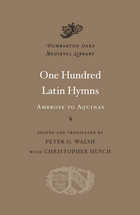 One Hundred Latin Hymns: Ambrose to Aquinas
Peter G. Walsh
Harvard University Press, 2012 “How I wept at your hymns and songs, keenly moved by the sweet-sounding voices of your church!” wrote the recently converted Augustine in his Confessions. Christians from the earliest period consecrated the hours of the day and the sacred calendar, liturgical seasons and festivals of saints. This volume collects one hundred of the most important and beloved Late Antique and Medieval Latin hymns from Western Europe.
These religious voices span a geographical range that stretches from Ireland through France to Spain and Italy. They meditate on the ineffable, from Passion to Paradise, in love and trembling and praise. The authors represented here range from Ambrose in the late fourth century ce down to Bonaventure in the thirteenth. The texts cover a broad gamut in their poetic forms and meters. Although often the music has not survived, most of them would have been sung. Some of them have continued to inspire composers, such as the great thirteenth-century hymns, the Stabat mater and Dies irae.
 One Hundred Mountains of Japan
Kyuya Fukada, translated by Martin Hood
University of Hawaii Press, 2014 “Nowhere in the world do people hold mountains in so much regard as in Japan,” writes Fukada Kyūya in the afterword to this book. “Mountains have played a part in Japanese history since the country's beginnings, and they manifest themselves in every form of art. For mountains have always formed the bedrock of the Japanese soul.”
In One Hundred Mountains of Japan (Nihon Hyakumeizan), Fukada pays tribute to his favourite mountains. Originating as a series of magazine articles about a personal selection of mountains, the work became an instant classic when it was first published in book form in 1964.
More recently, Japan’s national broadcasting company has turned the originalNihon Hyakumeizan into a memorable TV series. Consisting of one hundred short essays, each celebrating one notable mountain and its place in Japan’s traditions, the book is an elegantly written eulogy to the landscape, literature and history that define a people.
Fukada was bemused by his book’s success: “In the end, the one hundred mountains represent my personal choice and I make no claims for them beyond that.” Yet, half a century after he set down those words, his mountains have become an institution. Marked on every hiking map, his Hyakumeizan are today firmly embedded in the mountain traditions they grew out of.
Now available in English translation, One Hundred Mountains of Japan will serve as a vade mecum for a new cohort of hikers and mountaineers. It also opens up new territories for students of Japan’s literature, folklore, religions, and mountaineering history – in short, for mountain-lovers everywhere.
 One Hundred Thousand Hearts: A Surgeon’s Memoir
By Denton A. Cooley
University of Texas Press, 2012 The pioneering surgeon Dr. Denton Cooley performed his first human heart transplant in 1968 and astounded the world in 1969 by conducting the first successful implantation of a totally artificial heart in a human being. Over the course of his career, Cooley and his associates performed thousands of open-heart operations and pioneered the use of new surgical procedures. Of all his achievements, however, Cooley was most proud of the Texas Heart Institute, which he founded in 1962 with a mission to use education, research, and improved patient care to decrease the devastating effects of cardiovascular disease. In 100,000 Hearts, Cooley tells about his childhood in Houston, his education at the University of Texas, his medical-school training at the University of Texas Medical Branch in Galveston and Johns Hopkins, and his service in the Army Medical Corps. While at Johns Hopkins, Cooley assisted in a groundbreaking operation to correct an infant’s congenital heart defect, which inspired him to specialize in heart surgery. Cooley’s detailed descriptions of working in the operating room at crucial points in medical history offer a fascinating perspective on the distance medical science traveled in just a few decades.
 One Hundred Thousand Tractors: The MTS and the Development of Controls in Soviet Agriculture
Robert F. Miller
Harvard University Press, 1970 For nearly thirty years, from the late 1920s to the late 1950s, the keystone of the entire Soviet collective farm system was the network of MTS (machine-tractor stations) which owned, housed, operated, and repaired heavy farm machinery for the surrounding farms. The MTS played fundamental roles in the development of the political, administrative, and ideological, as well as the economic, foundations of Soviet agriculture. Now, years after the demise of the MTS system, its influence can still be discerned in the structural and operational patterns of the agricultural organization. The story of the MTS, of considerable historical interest in its own right, offers numerous vantage points for studying the evolution of Soviet rule in the countryside. In this exhaustive work Robert Miller analyzes the history of the MTS and relates his findings to the development of Soviet administrative policies.
Using data obtained from provincial Party newspapers, official Soviet documents, fictional literature on village life, and interviews with Soviet agricultural specialists familiar with the MTS, Miller explores the combination of economic and political pressures embodied in the MTS system and traces the growth of a characteristically Soviet approach to the problems of administration. In addition to these broad questions of the interaction of the economics and politics, the author examines several specific problem areas, including the function of ideology in the Soviet domestic decision-making process, the principles and practices of Soviet public administration as applied to agriculture, and the development of patterns of Party control in the countryside.
Miller’s study of the MTS reveals the method of Soviet policy-making and policy-implementation to be highly influenced by the leadership style of such men as Stalin and Khrushchev, though practical economic considerations certainly took precedence in important cases. The author observes that ideologically correct procedure was not always felt to be sufficiently effective in times of crises. Two basic modes of administrative control thus became apparent—one for critical periods and another for relatively “normal” periods. An exceptionally thorough work, One Hundred Thousand Tractors will interest students of comparative politics and comparative public administration as well as Soviet specialists.
 One Hundred Years of Anthropology
J. O. Brew
Harvard University Press In celebration of the centennial of the founding of the Peabody Museum of Archaeology and Ethnology at Harvard University, a series of lectures was delivered by five outstanding scholars. These lectures, presented here with an introduction by J. O. Brew, Peabody Professor of American Archaeology and Ethnology and Director of the Peabody Museum, are not simply tributes to the work of the museum, but are a substantial contribution to the history of anthropology over the past one hundred years. F. R. Eggan examines ethnology and social anthropology as they have developed in interaction with their sister disciplines, and with related disciplines in the social sciences and humanities. Gordon Willey sketches the highlights and main trends in the history of American archaeology and shows how, in little more than a hundred years, the primary approaches of the science have swung full circle. Glyn Daniel looks at the advances in old world prehistory—its techniques, and uses of other specialties such as geochronology—and touches upon future problems and possibilities. Floyd Lounsbury describes anthropological linguistics as it was a century ago and traces the progress since then toward answering basic questions. And in conclusion, Sherwood Washburn, discussing the development of biological anthropology, shows how the problems that Darwin raised are now being put into modern form, and considers some of the implications of this transformation.
 One Hundred Years of Communist Experiments
Vladimir Tismaneanu
Central European University Press, 2021 Why has communism’s humanist quest for freedom and social justice without exception resulted in the reign of terror and lies? The authors of this collective volume address this urgent question covering the one hundred years since Lenin’s coup brought the first communist regime to power in St. Petersburg, Russia in November 1917. The first part of the volume is dedicated to the varieties of communist fantasies of salvation, and the remaining three consider how communist experiments over many different times and regions attempted to manage economics, politics, as well as society and culture. Although each communist project was adapted to the situation of the country where it operated, the studies in this volume find that because of its ideological nature, communism had a consistent penchant for totalitarianism in all of its manifestations. This book is also concerned with the future. As the world witnesses a new wave of ideological authoritarianism and collectivistic projects, the authors of the nineteen essays suggest lessons from their analyses of communism’s past to help better resist totalitarian projects in the future.
One Hundred Years of Futurism: Aesthetics, Politics and Performance
Edited by John London
Intellect Books, 2017 More than one hundred years after Futurism exploded onto the European stage with its unique brand of art and literature, there is a need to reassess the whole movement, from its Italian roots to its international ramifications. In wide-ranging essays based on fresh research, the contributors to this collection examine both the original context and the cultural legacy of Futurism. Chapters touch on topics such as Futurism and fascism, the geopolitics of Futurism, the Futurist woman, and translating Futurist texts. A large portion of the book is devoted to the practical aspects of performing Futurist theatrical ideas in the twenty-first century.
One Hundred Years of Futurism: Aesthetics, Politics and Performance
Edited by John London
Intellect Books, 2017 More than one hundred years after Futurism exploded onto the European stage with its unique brand of art and literature, there is a need to reassess the whole movement, from its Italian roots to its international ramifications. In wide-ranging essays based on fresh research, the contributors to this collection examine both the original context and the cultural legacy of Futurism. Chapters touch on topics such as Futurism and fascism, the geopolitics of Futurism, the Futurist woman, and translating Futurist texts. A large portion of the book is devoted to the practical aspects of performing Futurist theatrical ideas in the twenty-first century.
One Hundred Years of Philosophy
Brian Shanley
Catholic University of America Press, 2019 This collection originated in the centenary celebration of the School of Philosophy at The Catholic University of America. Written by acknowledged experts in their fields, the essays provide a unique overview of philosophical developments in the twentieth century. The broad range of topics considered makes the book an invaluable reference work.
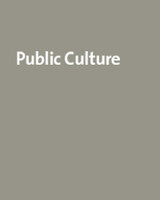 One Hundred Years of The Souls of Black Folk: A Celebration of W. E. B. Du Bois, Volume 17
Robert Gooding-Williams and Dwight A. McBride, eds.
Duke University Press Originally published in 1903, The Souls of Black Folk is W. E. B. Du Bois’s biting critique of the racist and nationalist ideologies that animated the political culture of post-Reconstruction, Jim Crow America. This special issue of Public Culture celebrates and considers the influence of Souls during the last one hundred years. Featuring the work of a new generation of Du Bois scholars, it suggests that a full appreciation of Souls requires reading it as both literary art and political theory. This collection relies on the language of literary aesthetics to examine Du Bois’s political agenda and, conversely, on varying accounts of that political agenda to assess his aesthetic choices. It also helps us understand why Souls became a literary and political classic and has played such a decisive role in the formation of twentieth-century African American literature and political thought. The essays explore a variety of topics, including the possibility that Souls was modeled on Richard Wagner’s idea of a total artwork, Du Bois’s thinking about the political significance of homosociality, and the interplay of racialism, nationalism, and globalism in Souls.
Contributors. Anne E. Carroll, Vilashini Cooppan, Robert Gooding-Williams, Sheila Lloyd, Dwight A. McBride, Charles I. Nero, Cheryl A. Wall, Alexander G. Weheliye
 The One King Lear
Sir Brian Vickers
Harvard University Press, 2016 King Lear exists in two different texts: the Quarto (1608) and the Folio (1623). Because each supplies passages missing in the other, for over 200 years editors combined the two to form a single text, the basis for all modern productions. Then in the 1980s a group of influential scholars argued that the two texts represent different versions of King Lear, that Shakespeare revised his play in light of theatrical performance. The two-text theory has since hardened into orthodoxy. Now for the first time in a book-length argument, one of the world’s most eminent Shakespeare scholars challenges the two-text theory. At stake is the way Shakespeare’s greatest play is read and performed.
Sir Brian Vickers demonstrates that the cuts in the Quarto were in fact carried out by the printer because he had underestimated the amount of paper he would need. Paper was an expensive commodity in the early modern period, and printers counted the number of lines or words in a manuscript before ordering their supply. As for the Folio, whereas the revisionists claim that Shakespeare cut the text in order to alter the balance between characters, Vickers sees no evidence of his agency. These cuts were likely made by the theater company to speed up the action. Vickers includes responses to the revisionist theory made by leading literary scholars, who show that the Folio cuts damage the play’s moral and emotional structure and are impracticable on the stage.
One in Spirit
The University of Chicago Archives
University of Chicago Press, 1991
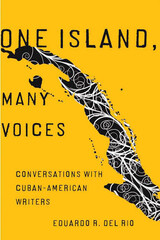 One Island, Many Voices: Conversations with Cuban-American Writers
Eduardo R. del Rio
University of Arizona Press, 2008 Cuban-American writers have been studied primarily within the context of Latino literature as a whole. Seeing a need to distinguish and define this unique literary perspective, Eduardo del Rio selected twelve important well-known authors and conducted interviews. He chose writers who were born in Cuba but have lived in the United States for a significant amount of time and whose works include themes he considers elemental to Cuban-American literature: identity, duality, memory, and exile. But rather than a cohesive, homogeneous group, these conversations unveiled a kaleidoscope of individuality, style, and motive. The authors’ bonds to Cuba inform their creative work in vastly different ways, and attempts to categorize their similarities only highlight the range of character and experience within this assemblage of talented writers.
From playwright Dolores Prida to author and literary critic Gustavo Pérez Firmat, these voices run the gamut of both genre and personality. In addition to the essential facts of literary accomplishment, the interviews include a wealth of insight into each writer’s history, motivations, concerns, and relationship to language. These personal details serve to humanize and illuminate the unique circumstances and realities that have shaped both the authors and their work.
What del Rio has ultimately brought together is a series of intimate sketches that will not only serve as an important reference for any discussion of the literature but will also help readers to develop for themselves a sense of what Cuban-American writing is, and what it is not.
CONTENTS
Preface
Acknowledgments
Introduction
Nilo Cruz
Roberto Fernández
Cristina García
Carolina Hospital
Eduardo Machado
Dionisio Martínez
Pablo Medina
Achy Obejas
Ricardo Pau-Llosa
Gustavo Pérez Firmat
Dolores Prida
Virgil Suárez
Epilogue
Notes
Bibliography
Index
One Kind of Everything: Poem and Person in Contemporary America
Dan Chiasson
University of Chicago Press, 2007 One Kind of Everything elucidates the uses of autobiography and constructions of personhood in American poetry since World War II, with helpful reference to American literature in general since Emerson. Taking on one of the most crucial issues in American poetry of the last fifty years, celebrated poet Dan Chiasson explores what is lost or gained when real-life experiences are made part of the subject matter and source material for poetry. In five extended, scholarly essays—on Robert Lowell, Elizabeth Bishop, Frank Bidart, Frank O’Hara, and Louise Glück—Chiasson looks specifically to bridge the chasm between formal and experimental poetry in the United States. Regardless of form, Chiasson argues that recent American poetry is most thoughtful when it engages most forcefully with autobiographical material, either in an effort to embrace it or denounce it.
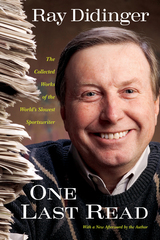 One Last Read: The Collected Works of the World's Slowest Sportswriter
Ray Didinger
Temple University Press, 2023 Ray Didinger is one of the best sportswriters Philadelphia has ever read. A sports journalist, first for the Bulletin and then for the Daily News, he never missed a deadline in over 25 years. But as he admits, there have been close calls, much to his editors' chagrin. He was widely known as "the World's Slowest Sportswriter."
Of the thousands of articles, columns, and profiles he has penned over the years, Didinger has selected his finest work to be included in this book. One Last Read contains entire chapters for each of the professional Philadelphia teams -- the Phillies, the Flyers, the Sixers and of course, the Eagles. But that is only half of the story. Included here is his coverage of college sports and the Olympics as well as the ful text of the speech he delivered in Canton, Ohio when he presented his boyhood idol, Tommy McDonald, for induction into the Pro Football Hall of Fame.
There are also some strongly-worded opinion pieces -- about former Eagles owner (and legendary high-roller) Leonard Tose, the career of Woody Hayes, and much, much more.
Didinger's introduction -- engaging, warm, whitty, and insightful -- is among his finest writing. For longtime readers, this essential collection of Didinger's work was worth the wait.
One Law for All?: Western Models and Local Practices in (Post-) Imperial Contexts
Edited by Stefan B. Kirmse
Campus Verlag, 2012 Examining new archival material from the nineteenth and early twentieth centuries, One Law for All? discusses legal transfer and practice in imperial and post-imperial societies, including Russia, Latin America, Africa, and East Asia. The essays collected here analyze the legal sphere as a site of struggle, both in debate and in everyday life, from the level of universal aspirations to particular local practices. The contributors explore the ways in which both lawmakers and ordinary people talk about and actively use the law, thereby telling a story of contested European hegemony, local assertions, and multiple legal borrowings.
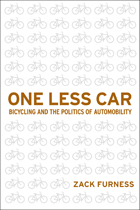 One Less Car: Bicycling and the Politics of Automobility
Authored by Zack Furness
Temple University Press, 2010 Although millions of people in the United States love to ride bicycles for exercise or leisure, statistics show that only 1% of the total U.S. population ride bicycles for transportation—and barely half as many use bikes to commute to work. In his original and exciting book, One Less Car, Zack Furness examines what it means historically, culturally, socioeconomically, and politically to be a bicycle transportation advocate/activist. Presenting an underground subculture of bike enthusiasts who aggressively resist car culture, Furness maps out the cultural trajectories between mobility, technology, urban space and everyday life. He connects bicycling to radical politics, public demonstrations, alternative media production (e.g., ‘zines), as well as to the development of community programs throughout the world. One Less Car also positions the bicycle as an object with which to analyze and critique some of the dominant cultural and political formations in the U.S.—and even breaks down barriers of race, class and gender privilege that are interconnected to mobility. For Furness, bicycles not only liberate people from technology, they also support social and environmental justice. So, he asks, Why aren’t more Americans adopting them for their transportation needs?
 One Long Argument: Charles Darwin and the Genesis of Modern Evolutionary Thought
Ernst Mayr
Harvard University Press, 1993 Evolutionary theory ranks as one of the most powerful concepts of modern civilization. Its effects on our view of life have been wide and deep. One of the most world-shaking books ever published, Charles Darwin’s On the Origin of Species, first appeared in print over 130 years ago, and it touched off a debate that rages to this day.
Every modern evolutionist turns to Darwin’s work again and again. Current controversies in the life sciences very often have as their starting point some vagueness in Darwin’s writings or some question Darwin was unable to answer owing to the insufficient biological knowledge available during his time. Despite the intense study of Darwin’s life and work, however, many of us cannot explain his theories (he had several separate ones) and the evidence and reasoning behind them, nor do we appreciate the modifications of the Darwinian paradigm that have kept it viable throughout the twentieth century.
Who could elucidate the subtleties of Darwin’s thought and that of his contemporaries and intellectual heirs—A. R. Wallace, T. H. Huxley, August Weismann, Asa Gray—better than Ernst Mayr, a man considered by many to be the greatest evolutionist of the century? In this gem of historical scholarship, Mayr has achieved a remarkable distillation of Charles Darwin’s scientific thought and his enormous legacy to twentieth-century biology. Here we have an accessible account of the revolutionary ideas that Darwin thrust upon the world. Describing his treatise as “one long argument,” Darwin definitively refuted the belief in the divine creation of each individual species, establishing in its place the concept that all of life descended from a common ancestor. He proposed the idea that humans were not the special products of creation but evolved according to principles that operate everywhere else in the living world; he upset current notions of a perfectly designed, benign natural world and substituted in their place the concept of a struggle for survival; and he introduced probability, chance, and uniqueness into scientific discourse.
This is an important book for students, biologists, and general readers interested in the history of ideas—especially ideas that have radically altered our worldview. Here is a book by a grand master that spells out in simple terms the historical issues and presents the controversies in a manner that makes them understandable from a modern perspective.
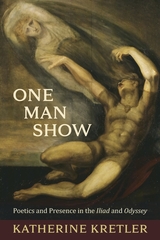 One Man Show: Poetics and Presence in the Iliad and Odyssey
Katherine Kretler
Harvard University Press, 2019 This book plumbs the virtues of the Homeric poems as scripts for solo performance. Despite academic focus on orality and on composition in performance, we have yet to fully appreciate the Iliad and Odyssey as the sophisticated scripts that they are. What is lost in the journey from the stage to the page?
Readers may be readily impressed by the vividness of the poems, but they may miss out on the strange presence or uncanniness that the performer evoked in ancient audience members such as Plato and Aristotle. This book focuses on the performer not simply as transparent mediator, but as one haunted by multiple stories and presences, who brings suppressed voices to the surface.
Performance is inextricable from all aspects of the poems, from image to structure to background story. Background stories previously neglected, even in some of the most familiar passages (such as Phoenix’s speech in Iliad 9) are brought to the surface, and passages readers tend to rush through (such as Odysseus’s encounter with Eumaeus) are shown to have some of the richest dramatic potential. Attending to performance enlivens isolated features in a given passage by showing how they work together.
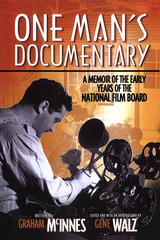 One Man’s Documentary: A Memoir of the Early Years of the National Film Board
Graham McInnes
University of Manitoba Press, 2004 Graham McInnes was one of many talented young people recruited by the charismatic John Grierson to build the National Film Board of Canada during the heady days of WWII. McInnes’s memoir of these “days of high excitement” is an insider’s look at the NFB from 1939 to 1945, a vivid “origin” story of Canada’s emerging world-class film studio that provides the NFB with the kind of full-bodied vitality usually associated with the great Hollywood studios in their golden years.An art critic and CBC radio commentator when he joined the NFB in 1939 as a scriptwriter, McInnes worked on many film classics with filmmakers such as Tom Daly, Norman McLaren, Gudrun Parker, and Budge Crawley. McInnes portrays these legends as well as many other players in that dynamic world, such as Lorne Green, Morley Callaghan, and Mavis Gallant, in this stylish, witty, and affectionate recreation of the early day-to-day frenzy.One Man’s Documentary is a lively account of one of the most exciting periods in Canadian filmmaking. With style and verve, McInnes paints vivid portraits of Grierson and the others who helped make the NFB an international institution. Film historian Gene Walz’s introduction gives a full picture of the early history of the NFB as well as an account of McInnes’s fascinating life.
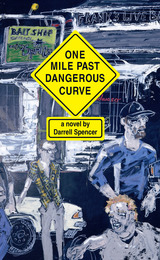 One Mile Past Dangerous Curve: A Novel
Darrell Spencer
University of Michigan Press, 2005 Praise for One Mile Past Dangerous Curve:
"This book aims to be about the best of us as it shows us at our least. Thank goodness for Darrell Spencer, the only writer in America to be trusted on the subjects of faith, love, weal and woe."
---Lee K. Abbott
" . . . absolutely dire and dear, his best book, a novel about American life right now. . . . this book is accurate, acerbic, and heartfelt at once."
---Ron Carlson
Praise for Darrell Spencer:
"Mr. Spencer's writing crackles with freshness and lucidity, featuring characters who slide into one another in random encounters and relationships."
---New York Times Book Review
"[Spencer] possesses a remarkable ear for the cadence of everyday speech."
---Michael Chabon
From the acclaimed author of Caution: Men in Trees and A Woman Packing a Pistol comes a tale of kinship, love, and lawlessness.
One Mile Past Dangerous Curve is the story of the Dancers---a family on the verge of collapse. Glen Dancer has come to Ohio to set up another in a series of Snapper franchises. But in the midst of construction, Glen finds himself fighting a painful and futile battle with cancer.
His son Eddie, recently divorced, moves from Las Vegas to help. A sign painter by trade, Eddie finds only intermittent work in town until the day a mysterious and wealthy businessman commissions a series of twenty road signs, each different, all featuring odd, cryptic messages. It is on a back-country road, where Eddie has gone to assemble one of the signs, that some previously vague threats become concrete.
Though Eddie doesn't know it, the neighboring woods hide a secret, a secret that a gun-toting rural gang wants to keep at any cost.
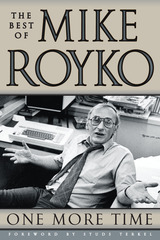 One More Time: The Best of Mike Royko
Mike Royko
University of Chicago Press, 1999 With the incisive pen of a newspaperman and the compassionate soul of a poet, Mike Royko was a Chicago institution who became, in Jimmy Breslin's words, "the best journalist of his time." Culled from 7500 columns and spanning four decades, from his early days to his last dispatch, the writings in this collection reflect a radically changing America as seen by a man whose keen sense of justice and humor never faltered. Faithful readers will find their old favorites and develop new ones, while the uninitiated have the enviable good fortune of experiencing this true American voice for the first time.
"A treasure trove lies between these covers. Royko was in a class by himself. He was a true original."—Ann Landers
"The joy of One More Time is Royko in his own words."—Mary Eileen O'Connell, New York Times Book Review
"Reading a collection of Royko's columns is even more of a pleasure than encountering them one by one, and that is a large remark for he rarely wrote a piece that failed to wake you up with his hard-earned moral wit. Three cheers for Royko!"—Norman Mailer
"Powerful, punchy, amazingly contemporary."—Neil A. Grauer, Cleveland Plain Dealer
"This crackling collection of his own favorite columns as well as those beloved by his fans reminds us just how much we miss the gruff, compassionate voice of Mike Royko."—Jane Sumner, Dallas Morning News
"A marvelous road map through four decades of America."—Elizabeth Taylor, Chicago Tribune Books
"Royko was an expert at finding universal truths in parochial situations, as well as in the larger issues—war and peace, justice and injustice, wealth and poverty—he examined. Think of One More Time as one man's pungent commentary on life in these United States over the last few decades."—Booklist
"Royko was one of the most respected and admired people in the business, by readers and colleagues alike. . . . Savor [his sketches] while you can."—Jonathan Yardley, Washington Post Book World
"Book collections of columns aren't presumed to be worth reading. This one is, whether or not you care about newspapering or Chicago."—Neil Morgan, San Diego Union-Tribune
"A treasure house for journalism students, for would-be writers, for students of writing styles, for people who just like to laugh at the absurdity of the human condition or, as Studs Terkel said, for those who will later seek to learn what it was really like in the 20th century."—Georgie Anne Geyer, Washington Times
"Full of astonishments, and the greatest of these is Royko's technical mastery as a writer."—Hendrik Hertzberg, New Yorker
"A great tribute to an American original, a contrarian blessed with a sense of irony and a way with words."—Bob Minzesheimer, USA Today
"In this posthumous collection of his columns, journalist Royko displays the breezy wit that made him so beloved in the Windy City."—People
 One More Warbler: A Life with Birds
By Victor Emanuel, with S. Kirk Walsh
University of Texas Press, 2017 Victor Emanuel is widely considered one of America’s leading birders. He has observed more than six thousand species during travels that have taken him to every continent. He founded the largest company in the world specializing in birding tours and one of the most respected ones in ecotourism. Emanuel has received some of birding’s highest honors, including the Roger Tory Peterson Award from the American Birding Association and the Arthur A. Allen Award from the Cornell Laboratory of Ornithology. He also started the first birding camps for young people, which he considers one of his greatest achievements. In One More Warbler, Emanuel recalls a lifetime of birding adventures—from his childhood sighting of a male Cardinal that ignited his passion for birds to a once-in-a-lifetime journey to Asia to observe all eight species of cranes of that continent. He tells fascinating stories of meeting his mentors who taught him about birds, nature, and conservation, and later, his close circle of friends—Ted Parker, Peter Matthiessen, George Plimpton, Roger Tory Peterson, and others—who he frequently birded and traveled with around the world. Emanuel writes about the sighting of an Eskimo Curlew, thought to be extinct, on Galveston Island; setting an all-time national record during the annual Audubon Christmas Bird Count; attempting to see the Imperial Woodpecker in northwestern Mexico; and birding on the far-flung island of Attu on the Aleutian chain. Over the years, Emanuel became a dedicated mentor himself, teaching hundreds of young people the joys and enrichment of birding. “Birds changed my life,” says Emanuel, and his stories make clear how a deep connection to the natural world can change everyone’s life.
 One More World Like This World
Carlie Hoffman
Four Way Books, 2025 Following When There Was Light (Winner of the 2023 National Jewish Book Award in Poetry), Carlie Hoffman’s third collection of poetry, One More World like This World, is a lyrical study of contemporary life—its lines echo amidst the imbalanced interdependence of globalization, in the wake of third-wave feminism, and from the active collapse of our American empire. Hoffman’s poems brilliantly survey both how women have been flattened, misunderstood, and displaced throughout time and across disciplines, and how women have made themselves at home in their minds and within their specific histories.
Approaching adaptation as a coping mechanism against perpetual exile, Hoffman recasts female archetypes as contemporary women, drawing a throughline between the narrative past and present circumstances. Persephone follows her captor “deeper inside the replica of girlhood,” and Eurydice in New Jersey “knew where she was going” as she made her way to death across “the parking lot and graveyard’s / fertile grass.” Rather than simply retelling a familiar tale, Hoffman’s poems illuminate mythology as a discourse with time and recognize solidarity between women as a conversation that continues beyond the grave.
The timeless wisdom of this collection is how it unveils the constant and concurrent tragedies taking place everywhere around us while salvaging the irreducible pleasure of living from the wrecks of perception. Despite it all, we want to live. Perhaps, Hoffman seems to say, we were expelled from the garden not once but again and again, and, each time we exit, we go out searching for one more world like this world. “The apple’s a for-sale sign swaying from the tree,” she writes in the collection’s final poem “Borges Sells Me the Apple, Sells Me the World.” Or, to revisit the stage set in “Teaching the Persona Poem at Ramapo College of New Jersey,” “Outside the classroom window, snow falls, unencumbered / by a wind from nowhere the night Eurydice chooses to stay.”
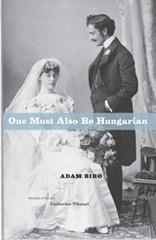 One Must Also Be Hungarian
Adam Biro
University of Chicago Press, 2006 The only country in the world with a line in its national anthem as desperate as “this people has already suffered for its past and its future,” Hungary is a nation defined by poverty, despair, and conflict. Its history, of course, took an even darker and more tragic turn during the Holocaust. But the story of the Jews in Hungary is also one of survival, heroism, and even humor—and that is the one acclaimed author Adam Biro sets out to recover in One Must Also Be Hungarian, an inspiring and altogether poignant look back at the lives of his family members over the past two hundred years.
A Hungarian refugee and celebrated novelist working in Paris, Biro recognizes the enormous sacrifices that his ancestors made to pave the way for his successes and the envious position he occupies as a writer in postwar Europe. Inspired, therefore, to share the story of his family members with his grandson, Biro draws some moving pictures of them here: witty and whimsical vignettes that convey not only their courageous sides, but also their inner fears, angers, jealousies, and weaknesses—traits that lend an indelible humanity to their portraiture. Spanning the turn of the nineteenth century, two destructive world wars, the dramatic rise of communism, and its equally astonishing fall, the stories here convey a particularly Jewish sense of humor and irony throughout—one that made possible their survival amid such enormous adversity possible.
Already published to much acclaim in France, One Must Also Be Hungarian is a wry and compulsively readable book that rescues from oblivion the stories of a long-suffering but likewise remarkable and deservedly proud people.
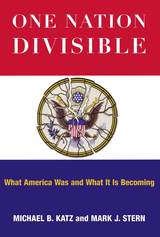 One Nation Divisible: What America Was and What It Is Becoming
Michael B. Katz
Russell Sage Foundation, 2006 American society today is hardly recognizable from what it was a century ago. Integrated schools, an information economy, and independently successful women are just a few of the remarkable changes that have occurred over just a few generations. Still, the country today is influenced by many of the same factors that revolutionized life in the late nineteenth century—immigration, globalization, technology, and shifting social norms—and is plagued by many of the same problems—economic, social, and racial inequality. One Nation Divisible, a sweeping history of twentieth-century American life by Michael B. Katz and Mark J. Stern, weaves together information from the latest census with a century's worth of data to show how trends in American life have changed while inequality and diversity have endured. One Nation Divisible examines all aspects of work, family, and social life to paint a broad picture of the American experience over the long arc of the twentieth century. Katz and Stern track the transformations of the U.S. workforce, from the farm to the factory to the office tower. Technological advances at the beginning and end of the twentieth century altered the demand for work, causing large population movements between regions. These labor market shifts fed both the explosive growth of cities at the dawn of the industrial age and the sprawling suburbanization of today. One Nation Divisible also discusses how the norms of growing up and growing old have shifted. Whereas the typical life course once involved early marriage and living with large, extended families, Americans today commonly take years before marrying or settling on a career path, and often live in non-traditional households. Katz and Stern examine the growing influence of government on trends in American life, showing how new laws have contributed to more diverse neighborhoods and schools, and increased opportunities for minorities, women, and the elderly. One Nation Divisible also explores the abiding economic paradox in American life: while many individuals are able to climb the financial ladder, inequality of income and wealth remains pervasive throughout society. The last hundred years have been marked by incredible transformations in American society. Great advances in civil rights have been tempered significantly by rising economic inequality. One Nation Divisible provides a compelling new analysis of the issues that continue to divide this country and the powerful role of government in both mitigating and exacerbating them. A Volume in the Russell Sage Foundation Census Series
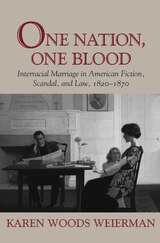 One Nation, One Blood: Interracial Marriage in American Fiction, Scandal, and Law, 1820-1870
Karen Woods Weierman
University of Massachusetts Press, 2005 The proscription against interracial marriage was for many years a flashpoint in American culture. In One Nation, One Blood, Karen Woods Weierman explores this taboo by investigating the traditional link between marriage and property. Her research reveals that the opposition to intermarriage originated in large measure in the nineteenth-century desire for Indian land and African labor. Yet despite the white majority's overwhelming rejection of nonwhite peoples as marriage partners, citizens, and social equals, nineteenth-century reformers challenged the rule against intermarriage. Dismissing the new "race science" that purported to prove white superiority, reformers held fast to the religious notion of a common humanity and the republican rhetoric of freedom and equality, arguing that God made all people "of one blood."
The years from 1820 to 1870 marked a crucial period in the history of this prejudice. Tales of interracial marriage recounted in fiction, real-life scandals, and legal statutes figured prominently in public discussion of both slavery and the fate of Native Americans. In Part One of this book, Weierman focuses on Indian-white marriages during the 1820s, when Indian removal became a rallying cry for New England intellectuals.
In Part Two she shifts her attention to black-white marriages from the antebellum period through the early years of Reconstruction. In both cases she finds that the combination of a highly publicized intermarriage scandal, new legislation prohibiting interracial marriage, and fictional portrayals of the ills associated with such unions served to reinforce popular prejudice, justifying the displacement of Indians from their lands and upholding the system of slavery. Even after the demise of slavery, restrictions against intermarriage remained in place in many parts of the country long into the twentieth century. Not until the 1967 Loving v. Virginia decision did the Supreme Court finally rule that such laws were unconstitutional.
Finishing on a contemporary note, Weierman suggests that the stories Americans tell about intermarriage today—stories defining family, racial identity, and citizenship—still reflect a struggle for resources and power.
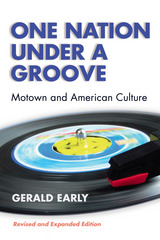 One Nation Under A Groove: Motown and American Culture
Gerald Early
University of Michigan Press, 2004 In its heyday Motown Records was a household word, one of the most famous and successful black-owned businesses in American history, and, arguably, the most significant of all American independent record labels.
How it got to be that way and how it changed the face of American popular culture are the subjects of this concise study of Berry Gordy's phenomenal creation. Author Gerald Early tells the story of the cultural and historical conditions that made Motown Records possible, including the dramatic shifts in American popular music of the time, changes in race relations and racial attitudes, and the rise of a black urban population. Early concentrates in particular on the 1960s and 70s, when Motown had its biggest impact on American musical tastes and styles.
With this revised and expanded edition, the author provides an up-to-date bibliography of the major books that have been written about Motown Records specifically, and black American music generally. Plus, new appendices feature interviews with four of the major creators of the Motown Sound: Berry Gordy, Stevie Wonder, Diana Ross, and Marvin Gaye.
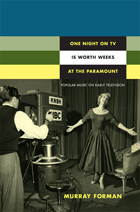 One Night on TV Is Worth Weeks at the Paramount: Popular Music on Early Television
Murray Forman
Duke University Press, 2012 Elvis Presley's television debut in January 1956 is often cited as the moment when popular music and television came together. Murray Forman challenges that contention, revealing popular music as crucial to television years before Presley's sensational small-screen performances. Drawing on trade and popular journalism, internal television and music industry documents, and records of audience feedback, Forman provides a detailed history of the incorporation of musical performances into TV programming during the medium's formative years, from 1948 to 1955. He examines how executives in the music and television industries understood and responded to the convergence of the two media; how celebrity musicians such as Vaughn Monroe, Frank Sinatra, and Fred Waring struggled to adjust to television; and how relative unknowns with an intuitive feel for the medium were sometimes catapulted to stardom. Forman argues that early television production influenced the aesthetics of musical performance in the 1940s and 1950s, particularly those of emerging musical styles such as rock and roll. At the same time, popular music helped to shape the nascent medium of television—its technologies, program formats, and industry structures. Popular music performances were essential to the allure and success of TV in its early years.
One North Star: A Counting Book
Phyllis Root
University of Minnesota Press, 2016 Five toads hop, four brook trout swim, three elk graze, two loons call, and one beaver gnaws on a paper birch tree, all under one North Star. Through bog and marsh, along river and lake, across prairie and into the woods, children learn what lives where by counting the creatures on foot or in flight, swimming or perching in exquisite woodcut and watercolor illustrations created by Beckie Prange and Betsy Bowen in an artistic collaboration. For those looking for more about the pictured wildlife, Phyllis Root includes fascinating facts and information on the state’s ecosystems and the plants and animals that make their homes there.
 One of Us: A Family's Life with Autism
Mark Osteen
University of Missouri Press, 2010 In 1991, Mark Osteen and his wife, Leslie, were struggling to understand why their son, Cameron, was so different from other kids. At age one, Cam had little interest in toys and was surprisingly fixated on books. He didn’t make baby sounds; he ignored other children. As he grew older, he failed to grasp language, remaining unresponsive even when his parents called his name. When Cam started having screaming anxiety attacks, Mark and Leslie began to grasp that Cam was developmentally delayed. But when Leslie raised the possibility of an autism diagnosis, Mark balked. Autism is so rare, he thought. Might as well worry about being struck by lightning. Since that time, awareness of autism has grown monumentally. Autism has received extensive coverage in the news media, and it has become a popular subject for film, television, and literature, but the disorder is frequently portrayed and perceived as a set of eccentricities that can be corrected with proper treatment. In reality, autism permanently wrecks many children’s chances for typical lives. Plenty of recent bestsellers have described the hardships of autism, but those memoirs usually focus on the recovery of people who overcome some or all of the challenges of the disorder. And while that plot is uplifting, it’s rare in real life, as few autistic children fully recover. The territory of severe autism—of the child who is debilitated by the condition, who will never be cured—has been largely neglected. One of Us: A Family’s Life with Autism tells that story. In this book, Mark Osteen chronicles the experience of raising Cam, whose autism causes him aggression, insomnia, compulsions, and physical sickness. In a powerful, deeply personal narrative, Osteen recounts the struggles he and his wife endured in diagnosing, treating, and understanding Cam’s disability, following the family through the years of medical difficulties and emotional wrangling. One of Us thrusts the reader into the life of a child who exists in his own world and describes the immense hardships faced by those who love and care for him. Leslie and Mark's marriage is sorely tested by their son's condition, and the book follows their progress from denial to acceptance while they fight to save their own relationship. By embracing the little victories of their life with Cam and by learning to love him as he is, Mark takes the reader down a road just as gratifying, and perhaps more moving, than one to recovery. One of Us is not a book about a child who overcomes autism. Instead, it’s the story of a different but equally rare sort of victory—the triumph of love over tremendous adversity.
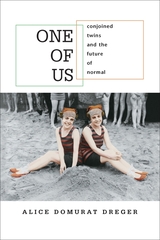 One of Us: Conjoined Twins and the Future of Normal
Alice Domurat Dreger
Harvard University Press, 2005 Must children born with socially challenging anatomies have their bodies changed because others cannot be expected to change their minds? One of Us views conjoined twinning and other “abnormalities” from the point of view of people living with such anatomies, and considers these issues within the larger historical context of anatomical politics.
Anatomy matters, Alice Domurat Dreger tells us, because the senses we possess, the muscles we control, and the resources we require to keep our bodies alive limit and guide what we experience in any given context. Her deeply thought-provoking and compassionate work exposes the breadth and depth of that context—the extent of the social frame upon which we construct the “normal.” In doing so, the book calls into question assumptions about anatomy and normality, and transforms our understanding of how we are all intricately and inextricably joined.
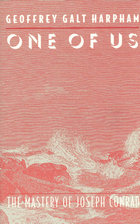 One of Us: The Mastery of Joseph Conrad
Geoffrey Galt Harpham
University of Chicago Press, 1996 The concept of mastery straddles a largely unexamined seam in contemporary thought dividing admirable self-control from a reprehensible will to power. Although Joseph Conrad has traditionally been viewed as an admirable master—master mariner, storyteller, and writer—his reputation has been linked in recent years to the negative masteries of racism, imperialism, and patriarchy.
In this book, Geoffrey Galt Harpham delves not only into Conrad's literary work and reputation but also into the concept of mastery. Outlining a psychology of composition that embraces Conrad's personal as well as historical circumstances, Harpham sheds new light on traditional issues in Conrad criticism, such as his Polish background and his preoccupation with the sea, by linking them to less frequently discussed subjects, including his elusive sexuality and his idiosyncratic relation to the English language.
One of Us represents both a methodological innovation in the practice of literary criticism and an important contribution to our understanding of how masters—and canons based on them—are made.
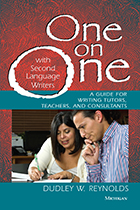 One on One with Second Language Writers: A Guide for Writing Tutors, Teachers, and Consultants
Dudley W. Reynolds
University of Michigan Press, 2009 One-on-one encounters with writers often contribute more to the development of student writing abilities than any classroom activity because they are personalized and responsive to individual needs. For the encounters to be successful, the writing tutor, teacher, or consultant must be prepared, must be knowledgeable of what it means to write and the factors that make writing more and less effective, and must also know the students. This guide focuses on what those who conference with second language writers need to know to respond best to students, recognize their needs, and steer conversations in productive directions. One on One with Second Language Writers provides tips about activities that can be adapted to individual contexts, student writing samples that can be analyzed for practice, a glossary, a list of useful resources, and a checklist for conferencing sessions. The book is appropriate for use in university and secondary school writing or learning centers, teacher training programs for both general composition and ESOL instructors, and as an individual reference tool. The book uses non-technical language where possible, but terminology is introduced where it might be useful when conferencing with students.
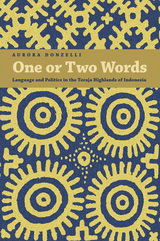 One or Two Words: Language and Politics in the Toraja Highlands of Indonesia
Aurora Donzelli
National University of Singapore Press, 2020 The Toraja highlanders of Indonesia use the expression “one or two words” to refer euphemistically to their highly elaborate form of political speechmaking. Taking off from this understatement, which signals the meaningfulness of transient acts of speech, One or Two Words offers an analysis of the shifting power relations between centers and peripheries in one of the world’s most linguistically diverse countries. Drawing on long-term fieldwork, Aurora Donzelli explores how people forge forms of collective belonging to a distinctive locality through the exchange of spoken words, WhatsApp messages, ritual gifts of pigs and buffaloes, and the performance of elaborate political speeches and ritual chants. Donzelli describes the complex forms of cosmopolitan indigeneity that have emerged in the Toraja highlands during several decades of encounters with a variety of local and international interlocutors, and by engaging wider debates on the dynamics of cultural and linguistic change in relationship to globalizing influences, the book sheds light on a neglected dimension of post-Suharto Indonesia: the recalibration of power relations between national and local languages. One or Two Words will be of interest to scholars of language, politics, power relationships, identity, social change, and local responses to globalizing influences.
One Parent or Five: A Global Look at Today’s New Intentional Families
Elizabeth Marquardt
American Philanthropic, 2011
My Daddy's Name Is Donor reveals stunning findings about the lives of adult offspring of sperm donation, one of the most common reproductive technologies and one that has been practiced widely in the United States and around the world for decades. Based on first-ever representative, comparative study of adults conceived via sperm donation, it discusses how they struggle with the implications of their conception and how they fare worse than their peers raised by biological parents on important outcomes such as depression, delinquency, and substance abuse. My Daddy's Name Is Donor aims to launch an international debate on ethics, meaning, and practice of donor conception.
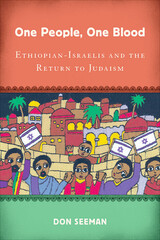 One People, One Blood: Ethiopian-Israelis and the Return to Judaism
Seeman, Don
Rutgers University Press, 2010 "Little by little, an egg will come to walk upon its own leg." Ethiopian-Israelis fondly quote this bit of Amharic folk wisdom, reflecting upon the slow, difficult history that allowed them to fulfill their destiny far from the Horn of Africa where they were born. But today, along with those Ethiopians who have been recognized as Jews by the State of Israel, many who are called "Feres Mura," the descendants of Ethiopian Jews whose families converted to Christianity but have now reasserted their Jewish identity, still await full acceptance in Israel. Since the 1990s, they have sought homecoming through Israel's "Law of Return," but have been met with reticence and suspicion on a variety of fronts. One People, One Blood expertly documents this tenuous relationship and the challenges facing the Feres Mura. Distilling more than ten years of ethnographic research, Don Seeman depicts the rich culture of the group, as well as their social and cultural vulnerability, and addresses the problems that arise when immigration officials, religious leaders, or academic scholars try to determine the legitimacy of Jewish identity or Jewish religious experience.
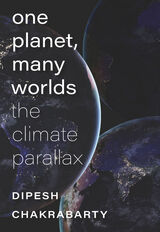 One Planet, Many Worlds: The Climate Parallax
Dipesh Chakrabarty
Brandeis University Press, 2023 A historian offers a unique look at the pandemic, climate change, and the human versus nonhuman.
Climate change represents a deep conundrum for humans. It is difficult for humans to give up the unequal and yet accelerating pursuit of a good life based on an insatiable appetite for energy sourced mainly from fossil fuel. But the same pursuit, scientists insist, damages the geobiological system that supports the existence of interrelated forms of life, including ours, on this planet. The planet, seen thus, is one. The global sway of financial and extractive capital connects humans technologically, but they remain divided along multiple axes of inequality. Their worlds are many and their politics still global rather than planetary. In the narrative presented here, Chakrabarty continues to explore the temporal and intellectual fault lines that mark the collapse of the global and the planetary in human history.
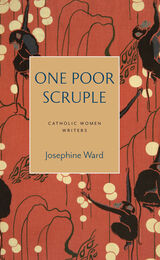 One Poor Scruple
Josephine Ward
Catholic University of America Press, 2022 The Catholic University of America Press is pleased to continue to present new volumes in our Catholic Women Writers series, which will shed new light on prose work of Catholic women writers from the 19th and 20th centuries.
Josephine Ward is one of Catholicism’s greatest literary treasures and a foremost contributor to English literary history – except that she has all but completely fallen from the historical record. She spent her life in close companionship with the most active minds working in the late 19th century to restore to the Catholic Church in England the intellectual, sacramental and theological integrity it had once enjoyed before three hundred years of persecution. All seven of her novels are out of print, despite their once high acclaim in the fin de siècle literary world.
First published in 1899, One Poor Scruple follows the recusant Riversdale family who have survived the long penal years by observing a quiet aristocratic life of sport and agriculture, never stepping into the public sphere from which Catholics in Britain had been barred for so long. But at the start of the twentieth century, a new generation has emerged. The novel’s younger characters are now legally able to go to Oxford and Cambridge and to enter the public life of letters. Emboldened by the confident work of John Henry Newman, this younger generation of Catholics are nonetheless cautioned not to trust the Protestant establishment. One Poor Scruple is a coming-of-age story in which the new generation of more worldly Catholics search for love, friendship and intellectual emancipation in the decadent social world of Edwardian London. Decades before Evelyn Waugh examined in Brideshead Revisited the human struggle to distinguish between true and false beauty, Ward’s novel examined the challenge of discerning between conflicting desires and of living a life that is as truthful and good as it is beautiful.
 One Quarter of Humanity: Malthusian Mythology and Chinese Realities, 1700–2000
James Z. Lee and Wang Feng
Harvard University Press, 1999 This book presents evidence about historical and contemporary Chinese population behavior that overturns much of the received wisdom about the differences between China and the West first voiced by Malthus. Malthus described a China in which early and universal marriage ensured high fertility and therefore high mortality. He contrasted this with Western Europe, where marriage occurred late and was far from universal, resulting in lower fertility and higher demographic responsiveness to economic circumstances. The result in China was thought to be mass misery as part of the population teetered on the brink of a Malthusian precipice, whereas in the West conditions were less severe.
In reality, James Lee and Wang Feng argue, there has been effective regulation of population growth in China through a variety of practices that depressed marital fertility to levels far below European standards, and through the widespread practices of infanticide and abortion. Moreover, in China, population behavior has long been primarily a consequence of collective intervention. This collective culture underlies four distinctive features of the Chinese demographic pattern—high rates of female infanticide, low rates of male marriage, low rates of marital fertility, and high rates of adoption—that Lee and Wang trace from 1700 to today. These and other distinctive features of the Chinese demographic and social system, they argue, led to a different demographic transition in China from the one that took place in the West.
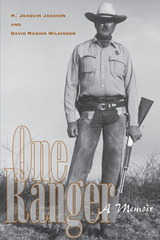 One Ranger: A Memoir
By H. Joaquin Jackson with David Marion Wilkinson
University of Texas Press, 2005 When his picture appeared on the cover of Texas Monthly, Joaquin Jackson became the icon of the modern Texas Rangers. Nick Nolte modeled his character in the movie Extreme Prejudice on him. Jackson even had a speaking part of his own in The Good Old Boys with Tommy Lee Jones. But the role that Jackson has always played the best is that of the man who wears the silver badge cut from a Mexican cinco peso coin—a working Texas Ranger. Legend says that one Ranger is all it takes to put down lawlessness and restore the peace—one riot, one Ranger. In this adventure-filled memoir, Joaquin Jackson recalls what it was like to be the Ranger who responded when riots threatened, violence erupted, and criminals needed to be brought to justice across a wide swath of the Texas-Mexico border from 1966 to 1993. Jackson has dramatic stories to tell. Defying all stereotypes, he was the one Ranger who ensured a fair election—and an overwhelming win for La Raza Unida party candidates—in Zavala County in 1972. He followed legendary Ranger Captain Alfred Y. Allee Sr. into a shootout at the Carrizo Springs jail that ended a prison revolt—and left him with nightmares. He captured "The See More Kid," an elusive horse thief and burglar who left clean dishes and swept floors in the houses he robbed. He investigated the 1988 shootings in Big Bend's Colorado Canyon and tried to understand the motives of the Mexican teenagers who terrorized three river rafters and killed one. He even helped train Afghan mujahedin warriors to fight the Soviet Union. Jackson's tenure in the Texas Rangers began when older Rangers still believed that law need not get in the way of maintaining order, and concluded as younger Rangers were turning to computer technology to help solve crimes. Though he insists, "I am only one Ranger. There was only one story that belonged to me," his story is part of the larger story of the Texas Rangers becoming a modern law enforcement agency that serves all the people of the state. It's a story that's as interesting as any of the legends. And yet, Jackson's story confirms the legends, too. With just over a hundred Texas Rangers to cover a state with 267,399 square miles, any one may become the one Ranger who, like Joaquin Jackson in Zavala County in 1972, stops one riot.
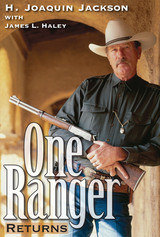 One Ranger Returns
By H. Joaquin Jackson, with James L. Haley
University of Texas Press, 2008 No Texas Ranger memoir has captured the public's imagination like Joaquin Jackson's One Ranger. Readers thrilled to Jackson's stories of catching criminals and keeping the peace across a wide swath of the Texas-Mexico border—and clamored for more. Now in One Ranger Returns, Jackson reopens his case files to tell more unforgettable stories, while also giving readers a deeply personal view of what being a Texas Ranger has meant to him and his family. Jackson recalls his five-year pursuit of two of America's most notorious serial killers, Henry Lee Lucas and Ottis Toole. He sets the record straight about the role of the Texas Rangers during the United Farm Workers strike in the Rio Grande Valley in 1966-1967. Jackson also describes the frustration of trying to solve a cold case from 1938—the brutal murder of a mother and daughter in the lonely desert east of Van Horn. He presents a rogue's gallery of cattle rustlers, drug smugglers, and a teetotaling bootlegger named Tom Bybee, a modest, likeable man who became an ax murderer. And in an eloquent concluding chapter, Jackson pays tribute to the Rangers who have gone before him, as well as those who keep the peace today.
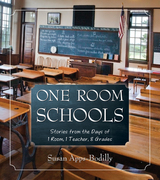 One Room Schools: Stories from the Days of 1 Room, 1 Teacher, 8 Grades
Susan Apps-Bodilly
Wisconsin Historical Society Press, 2013 Have you ever wondered what it was like to attend a one-room school, to be in the same classroom as your older brother or younger sister, or to have your teacher live with your family for part of the school year? In One Room Schools, Susan Apps-Bodilly chronicles life in Wisconsin’s early country schools, detailing the experiences of the students, the role of the teacher, and examples of the curriculum, including the importance of Wisconsin School of the Air radio programs. She describes the duties children had at school besides their schoolwork, from cleaning the erasers and sweeping cobwebs out of the outhouse to carrying in wood for the stove. She also tells what led to the closing of the one room schools, which were more than just centers of learning: they also served as the gathering place for the community. Susan Apps-Bodilly drew from the research compiled by her father Jerry Apps for his book, One-Room Country Schools: History and Recollections. Apps-Bodilly has geared her book toward young readers who will learn what students and their teacher did on cold mornings before the wood stove warmed them up. They also will find out how to play recess games like Fox and Geese and Anti-I-Over and will learn the locations of 10 former one room schools that can be toured. Apps-Bodilly also encourages readers to ask themselves what lessons can be learned from these early schools that have application for today’s schools? One Room Schools will transport young readers back in time and make their grandparents and others of that generation nostalgic—perhaps even prompting them to share memories of their school days.
One Semester Away from a Crisis: An Economist's Perspective on Leading Small Colleges
William T. Bogart
Rutgers University Press, 2026 Small colleges are a vital component of the United States higher education system. However, their unique characteristics are often overlooked in analyses that incorporate all colleges and universities. Many concepts familiar to economics professors but less familiar to more general audiences are helpful in understanding small colleges. These concepts include sophisticated ideas not typically covered in basic economics courses, such as regulatory capture, decision making under uncertainty, and the logic of collective action. By combining economic theories with his own experiences leading small colleges, William T. (Tom) Bogart provides a way for presidents, trustees, and other leaders of small colleges to more effectively help their institutions achieve their full potential.
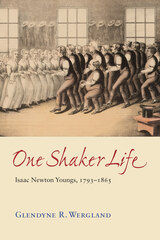 One Shaker Life: Isaac Newton Youngs, 1793-1865
Glendyne R. Wergland
University of Massachusetts Press, 2006 A member of the United Society of Believers, better known as the Shakers, Isaac Newton Youngs spent most of his life in New Lebanon, New York, home of the society's central Ministry. As both a private diarist and the official village scribe, he kept meticulous records throughout those years of both his own experience and that of the community. All told, more than four thousand pages of Brother Isaac's journals have survived, documenting the history of the Shakers during the period of their greatest success and providing a revealing view of the daily life of a rank-and-file Believer.
In this deeply researched biography, Glendyne R. Wergland draws on Youngs's writings to tell his story and to explore "the tension between desire and discipline" at the center of his life. She follows Youngs from childhood and adolescence to maturity, through years of demanding responsibility into his fatal decline. In each of these stages, he remained a talented and committed yet independent Shaker, one who chose to stay with the community but often struggled to abide by its stringent rules, including the vow of celibacy. Perhaps above all, he was a man who spent most of his waking hours working diligently at a succession of tasks, making clocks, sewing clothes, fixing roofs, writing poetry, chronicling his daily acts and thoughts.
In his journals, Brother Isaac writes at length of his efforts to control his lust as a young man, and he complains repeatedly about overwork as he grows older. He defines the rules of his community and identifies transgressors, while enciphering his critical entries (and those chronicling his own sexual desires) to avoid detection and uphold the demand for conformity. At times he admits doubt, but without ever relinquishing the belief that he is on the straight and narrow path to salvation. What emerges in the end is the complex portrait of an ordinary man striving to live up to the imperatives of his faith.
 One Shot for Gold: Developing a Modern Mine in Northern California
Eleanor Herz Swent
University of Nevada Press, 2021 Winner of the 2023 Clark Spence Award from the Mining History Association!
An account of the creation of a modern, environmentally sensitive mine as told by the people who developed and worked it.
In 1978, a geologist working for the Homestake Mining Company discovered gold in a remote corner of California’s Napa County. This discovery led to the establishment of California’s most productive gold mine in the twentieth century. Named the McLaughlin Mine, it produced about 3.4 million ounces of gold between 1985 and 2002. The mine was also one of the first attempts at creating a new full-scale mine in California after the advent of environmental regulations and the first to use autoclaves to extract gold from ore.
One Shot for Gold traces the history of the McLaughlin Mine and how it transformed a community and an industry. This lively and detailed account is based largely on oral history interviews with a wide range of people associated with the mine, including Homestake executives, geologists, and engineers as well as local neighbors of the mine, officials from county governments, townspeople, and environmental activists. Their narratives— supported by thorough research into mining company documents, public records, newspaper accounts, and other materials—chronicle the mine from its very beginning to its eventual end and transformation into a designated nature reserve as part of the University of California Natural Reserve System.
A mine created at the end of the twentieth century was vastly different from the mines of the Gold Rush. New regulations and concerns about the environmental, economic, and social impacts of a large mine in this remote and largely rural region of the state-required decisions at many levels. One Shot for Gold offers an engaging and accessible account of a modern gold mine and how it managed to exist in balance with the environment and the human community around it.
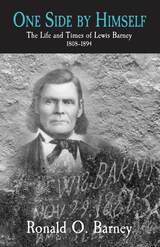 One Side By Himself
Ronald Barney
Utah State University Press, 2002 "What an astonishing life and what a remarkable biography. Lewis Barney's sojourn on the hard edge of the American frontier is a forgotten epic. Not only does this book tell of an amazing personal odyssey from his birth in upstate New York in 1808 to his death in Mancos, Colorado, in 1894, but Barney's tale represents a living evocation of some of the most significant themes in American history. Frederick Jackson Turner theorized that the frontier shaped our national character, but Lewis Barney's life stands as a testament to the real impact of the westering experience on a man and his family. Ron Barney's detailed biography of Lewis Barney provides a participant's view of Mormonism's first six decades of controversy, hardship, and triumph, viewed from the bottom of the social heap. Despite his wide-ranging experience and endless sacrifices, Lewis Barney was a worker in the Mormon vineyard, not one of the princes of the Kingdom of God whose lives have been so exhaustively celebrated. Barney's lack of status in this complex hierarchy adds tremendously to the value of this study, since so much nineteenth-century LDS biography has ignored the lives of ordinary people to celebrate a surprisingly small elite whose experiences were far different from those of the general Mormon population." —Will Bagley, editor of the series Kingdom in the West: The Mormons and the American Frontier and editor of The Pioneer Camp of the Saints: The 1846-1847 Mormon Trail Journals of Thomas Bullock.
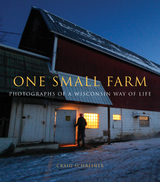 One Small Farm: Photographs of a Wisconsin Way of Life
Craig Schreiner
Wisconsin Historical Society Press, 2013 “People’s lives are written on the fields of old farms. The rows of the fields are like lines on a page, blank and white in winter, filled in with each year’s story of happiness, disappointment, drought, rain, sun, scarcity, plenty. The chapters accumulate, and people enter and leave the narrative. Only the farm goes on.”—From the Introduction In One Small Farm, Craig Schreiner’s evocative color photographs capture one family as they maintain the rhythms and routines of small farm life near Pine Bluff, Wisconsin. “Milk in the morning and milk at night. Feed the cows and calves. Plant crops. Grind feed. Chop and bale hay. Cut wood. Clean the barn. Spread manure on the fields. Plow snow and split wood in winter. In spring, pick rocks from the fields. Cultivate corn. Pick corn. Harvest oats and barley. Help calves be born. Milk in the morning and milk at night.”
There’s much more to life on the farm than just chores, of course, and Schreiner captures the rhythms and richness of everyday life on the farm in all seasons, evoking both the challenges and the joys and providing viewers a window into a world that is quickly fading. In documenting the Lamberty family’s daily work and life, these thoughtful photos explore larger questions concerning the future of small farm agriculture, Wisconsin cultural traditions, and the rural way of life.
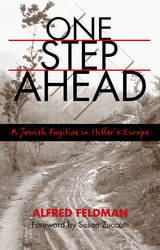 One Step Ahead: A Jewish Fugitive in Hitler's Europe
Alfred Feldman. Foreword by Susan Zuccotti
Southern Illinois University Press, 2001 Through compelling personal accounts and family correspondence, One Step Ahead documents Alfred Feldman’s harrowing flight into exile as he and his family fled the pogroms that flooded across Nazi-occupied Europe. It is a memoir of horror and hope recounted by a man who survived the organized terror of Hitler’s "Final Solution" as it destroyed entire generations of European Jewish life within ten catastrophic years in the mid-twentieth century. Feldman’s memoir conveys the searing pain that has never left him, while demonstrating the triumphant humanity of a survivor. Feldman vividly describes the impact of the escalating anti-Semitic hatred and violence in Germany during the 1930s, the impact of the notorious Nuremberg Laws in 1935, and the terrifying Kristallnacht pogrom in 1938. By age sixteen, Feldman was living with his parents and three younger sisters in Antwerp, Belgium, during the 1939 German invasions of Poland, marking the start of World War II. In the face of increasing persecution, Feldman’s extended family scattered over the globe in a desperate attempt to remain one step ahead of their Nazi pursuers. Recalling his life on the run, Feldman describes what few survivors have chosen to write about: the Vichy raids of August 26, 1942; the French labor brigades; the Comité Dubouchage; and life in super-vised residence in France under the Italians. While in the south of France, Feldman endured food shortages and Nazi anti-Semitic measures, beginning with work camps and culminating in the deportation and ultimate death of his mother and sisters at Auschwitz. To evade the Germans, Feldman and his father fled into the Italian Alps in September of 1943, hiding between the Allies and the Germans. Aided by local villagers, the Feldmans survived precariously for over a year and a half, along with other Jewish refugees, until that region was liberated. Only then, and only gradually, did Feldman manage to piece together the fate of his surviving family and learn at last of the death of his mother and sisters. Now, as an adult, Alfred Feldman has retraced his escape and exile, taking his wife and children to his hometown in Germany, the mountains in Italy, and Montagnac, where a plaque commemorates his mother and sisters.
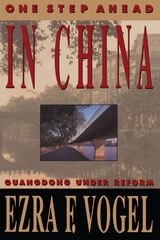 One Step Ahead in China: Guangdong under Reform
Ezra F. Vogel
Harvard University Press, 1989 Sprawled along China's southern coast near Hong Kong, Guangdong is the fastest growing and most envied region in the country. With sixty million people in an area the size of France, the province has been a fascinating laboratory for the transformation of a static socialist economy and social system. Reforms instituted in the late 1970s by Deng Xiaoping have allowed this area to look outward once again and to move “one step ahead” of the rest of China and the socialist world in introducing new political and economic policies. Why did the new strategy come about? What happened in the various parts of Guangdong during the first reform decade?
To answer these questions Ezra Vogel—one of the most widely respected observers of Asian economic and social development—returned to Guangdong, the subject of his award-winning book Canton under Communism, for eight months of fieldwork. The first Western scholar invited by a province to make such an extended visit, Vogel traveled to every prefecture in Guangdong and conducted hundreds of interviews to get a true picture of how post-Mao reforms are working. The result is a richly detailed study of a region on the cutting edge of socialist reform.
One Step Ahead in China is a groundbreaking book, unique in its detailed coverage of Guangdong, the first socialist dragon to follow in the path of South Korea and Taiwan. Vogel paints a vivid portrait of Guangdong's accelerated development and surveys the special economic zones, the Pearl Delta, Guangzhou, and the more remote areas, including Hainan. He looks at the entrepreneurs and the role of the pervasive Chinese tradition of guanxi, in which friends and relatives of officials receive preferential treatment. He examines the problems of opening up a socialist system and places Guangdong in the context of the newly developing economies of East Asia.
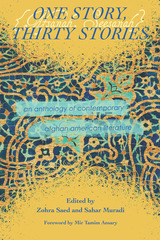 One Story, Thirty Stories: An Anthology of Contemporary Afghan American Literature
Zohra Saed
University of Arkansas Press, 2010 Since 9/11 there has been a cultural and political blossoming among those of the Afghan diaspora, especially in the United States, revealing a vibrant, active, and intellectual Afghan American community. And the success of Khaled Hosseni's The Kite Runner, the first work of fiction written by an Afghan American to become a bestseller, has created interest in the works of other Afghan American writers. One Story, Thirty Stories (or "Afsanah, Seesaneh," the Afghan equivalent of "once upon a time") collects poetry, fiction, essays, and selections from two blogs from thirty-three men and women—poets, fiction writers, journalists, filmmakers and video artists, photographers, community leaders and organizers, and diplomats. Some are veteran writers, such as Tamim Ansary and Donia Gobar, but others are novices and still learning how to craft their own "story," their unique Afghan American voice. The fifty pieces in this rich anthology reveal journeys in a new land and culture. They show people trying to come to grips with a life in exile, or they trace the migration maps of parents. They navigate the jagged landscape of the Soviet invasion, the civil war of the 1990s and the rise of the Taliban, and the ongoing American occupation.
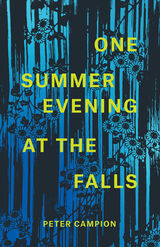 One Summer Evening at the Falls
Peter Campion
University of Chicago Press, 2021 The poems in this collection capture the fantastic feeling of falling in love, all while keeping eyes on its lifecycles of crashing aftermaths, lingering regrets, guilt, and renewal. Peter Campion brings us to a series of scenes—on the damp patio, in the darkroom, and along the interstate—where we find familiar characters, lovers, and strangers. In the title poem, he takes us to the falls, where people and passions mix amid the sticky hanging mists:
That charge of summer nights, that edge, like everyone’s checking
everyone out. Lingering a moment in the crowd
gathered to watch the rush and crash and let the mist
drift upward to our faces, I’m here: the future feels
open again. Even alone tonight—still: open.
Campion’s poems introduce us to a range of people, all of whom are rendered with distinctiveness and intimacy. Their voices proliferate through the collection, with lyric folding into speech, autobiography becoming dramatic monologue, and casual storytelling taking on a ritualistic intensity. The poems in One Summer Evening at the Falls show how each character and each moment can be worthy of love and that this love both undoes us and makes us who we are. In narrative and lyric, in formal verse and free, Campion brings contemporary playfulness together with his classical talent to create this far-reaching and tender collection.
One Sunny Day: A Child's Memories of Hiroshima
Hideko Tamura Snider
Oregon State University Press, 2023 Hideko was ten years old when the atomic bomb devastated her home in Hiroshima. In this eloquent and moving narrative, Hideko recalls her life before the bomb, the explosion itself, and the influence of that trauma upon her subsequent life in Japan and the United States. Her years in America have given her unusual insights into the relationship between Japanese and American cultures and the impact of Hiroshima on our lives. This new edition includes two expanded chapters and revisions throughout. A new epilogue brings the story up to date. This poignant story of courage and resilience remains deeply relevant today, offering a profoundly personal testament against the ongoing threat of nuclear warfare.
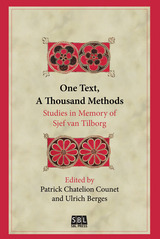 One Text, A Thousand Methods: Studies in Memory of Sjef van Tilborg
Patrick Chatelion Counet
SBL Press, 2016 A Brill classic now in paperback from SBL Press
Essays in this volume describe the shift in biblical exegesis within the last several decades from the interpretation of biblical texts as the outcome of historical development, or diachronic methodology, to the exploration of the text as the result of a reading process rather than a historical process, or synchronic methodology. The methods discussed include ideology criticism, semantic and poetic analysis, cognitive linguistics, drama theory, narratology, deconstruction, and anthropology, and intertextuality. The authors of this work challenge biblical scholars not to just perform exegesis, but to explore the methods and aims underlying their interpretations.
Features:
- Essays examine texts from the Old or New Testament through the lens of one of the many modern synchronic methods used in postmodern literary interpretation
- Fifteen essays from top scholars in the field
One Third of a Nation: Lorena Hickok Reports on the Great Depression
Lorena Hickok
University of Illinois Press, 1981 Between 1933 and 1935, Lorena Hickok traveled across thirty-two states as a "confidential investigator" for Harry Hopkins, head of FDR's Federal Emergency Relief Administration. Her assignment was to gather information about the day-to-day toll the Depression was exacting on individual citizens. One Third of a Nation is her record, underscored by the eloquent photographs of Dorothea Lange, Walker Evans, and others, of the shocking plight of millions of unemployed and dispossessed Americans.
The One Thomas More
Travis Curtright
Catholic University of America Press, 2012 The One Thomas More carefully studies the central humanist and polemical texts written by More to illustrate a coherent development of thought.
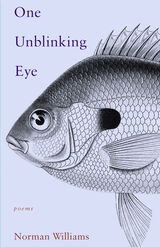 One Unblinking Eye: Poems
Norman Williams
Ohio University Press, 2003 The poems in One Unblinking Eye cast a steady and serious gaze at life outside the beltways. Whether testifying at a prayer meeting in Indiana, tramping the backwoods of northern New England, or working on an oil derrick in the Gulf, the inhabitants of these poems live on the margins of society. “They are the left-behind, odd-manneredones/Who speak in starts,” Norman Williams writes of the last residents of a West Virginia mining town. Describing the woods of central Maine, he speaks of “lives … scraped from sides/Of deer and garden plots; where double-wides,/On concrete pads abut a hard-pan road.” It is the art of these poems to convince the reader that these lives matter. There is desperation here, and madness, but there is an equal measure of determination and faith. In one poem, Mr. Williams writes of a fisherman haunted by his daughter’s death, who “casts his line/In hopes a flash and strike will draw him back.” These words describe the poet’s method as well. The work in this collection is built on a supple metrical foundation; it is filled with glancing rhymes and wordplay; and it is touched off by striking images. It is, in other words, composed with care, and it richly rewards a careful reading. Norman Williams writes in Burlington, Vermont, where he works as an attorney. His first book, The Unlovely Child, was published by Alfred A. Knopf to enthusiastic reviews. Anthony Hecht wrote that “the voice of these poems is marvelously modulated, low-key in its acceptances, modest in its exultations, steady and unintoxicated in its long vision. It is my fixed conviction that with his first book he has fashioned a landmark in our literature, and sounded a uniquely American note with beautiful certainty.” With his second book, more than fifteen years in the making, Norman Williams reafirms the truth of that assessment.
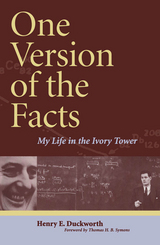 One Version of the Facts: My Life in the Ivory Tower
Henry E. Duckworth
University of Manitoba Press, 2000 In his engaging memoirs, One Version of the Facts: My Life in the Ivory Tower, Dr. Henry Duckworth takes readers from his student days in Winnipeg and Chicago in the 1930s to his time as president of the University of Winnipeg (1971-1981) and chancellor of the University of Manitoba. An accomplished physicist, he wrote the first definitive text in English on mass spectroscopy, discovered the last stable isotope (platinum), and helped create important programs at universities and at the National Research Council. He also served on numerous councils for scientific and university organizations, and rubbed shoulders with Nobel Prize winners at international conferences.With humour and modesty, Henry Duckworth recalls trends, changes, and crises he witnessed throughout his long university career. He offers his observations, his opinions, his "version of the facts," providing a special insight into critical years in Canada's university education history, as well as his own specialty, atomic research.
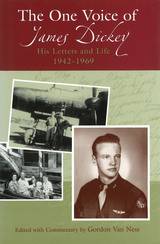 The One Voice of James Dickey: His Letters and Life, 1942-1969
Edited & Commentary by Gordon Van Ness
University of Missouri Press, 2003
In The One Voice of James Dickey, Gordon Van Ness skillfully documents James Dickey’s growth from a callow teen interested primarily in sports to a mature poet who possessed literary genius and who deliberately advanced himself and his career. The letters from 1942 through 1969 depict Dickey gradually establishing a self-identity, deciding to write, struggling to determine a subject matter and style, working determinedly to gain initial recognition, and eventually seeking out the literary establishment to promote himself and his views on poetry. The letters also portray a complex personality with broad interests, acute intelligence, and heightened imagination as well as a deep need to re-create his past and assume various roles in the present.
From Dickey’s extensive correspondence, Van Ness has selected not only those letters that best reveal the chronological development of Dickey’s career and his conscious efforts to chart its course, but also those that portray his other interests and depict the various features of his personality. The letters are grouped by decade, with each period placed in perspective by a critical introduction. The introductory sections offer a psychological understanding of Dickey’s personality by identifying the needs and fears that affected his actions. They also explain the American literary and cultural scene that Dickey confronted as he matured. Together, the letters and commentary yield a sense of Dickey’s complex personality—both the man as a writer and the writer as a man—while arguing that he remained “one voice.”
Because how a writer writes—the appearance of a writer’s words on a page—makes a statement, the letters are reproduced here without alterations. There are no silent deletions or revisions; the original spelling and punctuation have been preserved. Dickey’s letters gathered in The One Voice of James Dickey portray a poet’s consciousness, chronicling its growth and revealing its breadth. They do not contain the whole truth, but they are what we have.
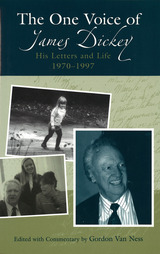 The One Voice of James Dickey: His Letters and Life, 1970-1997
Edited & Commentary by Gordon Van Ness
University of Missouri Press, 2005
This book completes and complements the first volume of the letters and life of James Dickey. Picking up where the previous volume left off, The One Voice of James Dickey: His Letters and Life, 1970–1997 chronicles Dickey’s career from the unparalleled success of his novel Deliverance in 1970 through his poetic experimentation in such books as The Eye Beaters, Blood, Victory, Madness, Buckhead and Mercy and Puella until his death in 1997. A prolific correspondent, Dickey tried to write at least three letters a day, and these letters provide a unique way for Gordon Van Ness to portray the vast and varied panorama of Dickey’s life.
The letters are grouped by decade largely because Dickey’s life was so very different in the seventies, eighties, and nineties. The chapter titles and their progression, as in the first volume, reflect Dickey’s sense that his life and career were a kind of warfare and that he was on a mission. A final section, “Debriefings,” offers a concise overview of Dickey’s full career. In earlier chapters, letters to people as varied as Saul Bellow, Arthur Schlesinger, and Robert Penn Warren indicate Dickey’s belief that this correspondence was a valuable networking tool, likely to open up new opportunities, while other letters, such as ones to Dickey’s oldest son, Christopher, expose the tender aspects of the author’s character.
No other critical study so well projects the development of Dickey’s career while simultaneously exhibiting the diversity of his interests and the often-conflicting sides of his personality. In the strictest sense, this volume is not a life-in-letters, but it does provide a general sense of Dickey’s comings, goings, and doings. Van Ness’s selection of letters suggests an acute understanding of Dickey, and his editorial commentary examines and reveals Dickey’s brilliance.
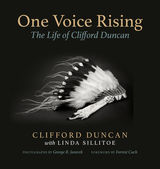 One Voice Rising: The Life of Clifford Duncan
Clifford Duncan with Linda Sillitoe, Photographs by George R. Janecek
University of Utah Press, 2019 One Voice Rising is a memoir by Ute healer, elder, and historian Clifford Duncan, as told to Anglo writer, Linda Sillitoe. Duncan (1933–2014) was an inspiring leader and a powerful medicine man, and he was, as Sillitoe wrote, “simultaneously one of the most bicultural and traditional American Indians in the West.” Duncan here covers both personal and tribal history during a crucial period in the tribe’s development. His discussions with Sillitoe offer a unique look at individual and societal issues, including the Native American Church, powwows and tribal celebrations, and interactions with the larger world. George Janecek’s photographs of Clifford Duncan and his world expand the impact of Duncan’s words.
“Everything was Indian then, when I was a boy. They had to explain to us about the white man's side. Now everything is in the white man's world and we teach Indian ways.”
—Clifford Duncan (from the book)
One Way: BERNARD DADIE OBSERVES AMERICA
Bernard Binlin Dadié
University of Illinois Press, 1994 In 1959, when Un Negre a Paris first appeared, the French still held West Africa under colonial rule. Dadie's observations and subtle parodies of Parisian manners and morals are entertaining and poignant, charming yet profound.
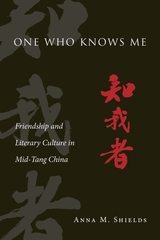 One Who Knows Me: Friendship and Literary Culture in Mid-Tang China
Anna M. Shields
Harvard University Press, 2015 The friendships of writers of the mid-Tang era (780s–820s)—between literary giants like Bai Juyi and Yuan Zhen, Han Yu and Meng Jiao, Liu Zongyuan and Liu Yuxi—became famous through the many texts they wrote to and about one another. What inspired mid-Tang literati to write about their friendships with such zeal? And how did these writings influence Tang literary culture more broadly? In One Who Knows Me, the first book to delve into friendship in medieval China, Anna M. Shields explores the literature of the mid-Tang to reveal the complex value its writers discovered in friendship—as a rewarding social practice, a rich literary topic, a way to negotiate literati identity, and a path toward self-understanding. Shields traces the evolution of the performance of friendship through a wide range of genres, including letters, prefaces, exchange poetry, and funerary texts, and interweaves elegant translations with close readings of these texts. For mid-Tang literati, writing about friendship became a powerful way to write about oneself and to reflect upon a shared culture. Their texts reveal the ways that friendship intersected the public and private realms of experience and, in the process, reshaped both.
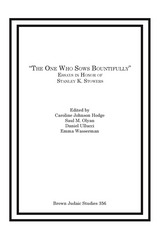 "The One Who Sows Bountifully": Essays in Honor of Stanley K. Stowers
Caroline Johnson Hodge
SBL Press, 2014 This festschrift honors the work of Stanley K. Stowers, a renowned specialist in the field of Pauline studies and early Christianity, on the occasion of his sixty-fifth birthday and retirement from Brown University. The collection includes twenty-eight essays on theory and history of interpretation, Israelite religion and ancient Judaism, the Greco-Roman world, and early Christinity, a preface honoring Stowers, and a select bibliography of his publications.
Contributors include: Adriana Destro, John T. Fitzgerald, John G. Gager, Caroline Johnson Hodge, Ross S. Kraemer, Saul M. Olyan, Mauro Pesce, Daniel Ullucci, Debra Scoggins Ballentine, William K. Gilders, David Konstan, Nathaniel B. Levtow, Jordan D. Rosenblum, Michael L. Satlow, Karen B. Stern, Emma Wasserman, Nathaniel DesRosiers, John S. Kloppenborg, Luther H. Martin, Arthur P. Urbano, L. Michael White, William Arnal, Pamela Eisenbaum, Troels Engberg-Pedersen, Karen L. King, Christopher R. Matthews, Erin Roberts, and Richard Wright.
 One Winter Up North
John Owens
University of Minnesota Press, 2022 A picture-book journey through the Boundary Waters Canoe Area Wilderness in winter, snowshoeing the frozen lakes and silent forest with family, encountering the wonders of northern wildlife in the cold season
In winter the Boundary Waters, way up north in Minnesota, is not the same place you canoed last summer—but still it beckons and welcomes you. Grab a pack, strap on snowshoes, make a path (Oh! they take some getting used to!), and venture out across the frozen lakes and through the snowy woods. The vast wintery world here is so still and quiet, you might think you’re all alone—but no! Who made these tracks? A deer? A hare? A fox? And far off there’s a musher, making tracks with his sled dogs. It’s a magical place. The bright sun brilliant on the snow, the sparkling silence—wait, is that a wolf calling? Try to answer! And when the dark descends, the stars and pine trees holding up the night, your nose gets cold and it’s back to camp, to your warm winter tent, where Father feeds the stove with wood you gathered, Mother snuggles into her big sleeping bag, and you curl up in the fire’s glow and know that in your dreams and memories you will return again and again to this one winter up north. A wintery adventure that unfolds in pictures, John Owens’s delightful book gives readers a chance to discover—or rediscover—another season full of wonder in the Boundary Waters Canoe Area Wilderness.
One With Nineveh: Politics, Consumption, and the Human Future
Paul R. Ehrlich and Anne H. Ehrlich
Island Press, 2005 Named a Notable Book for 2005 by the American Library Association, One with Nineveh is a fresh synthesis of the major issues of our time, now brought up to date with an afterword for the paperback edition. Through lucid explanations, telling anecdotes, and incisive analysis, the book spotlights the three elephants in our global living room-rising consumption, still-growing world population, and unchecked political and economic inequity-that together are increasingly shaping today's politics and humankind's future. One with Nineveh brilliantly puts today's political and environmental debates in a larger context and offers some bold proposals for improving our future prospect.
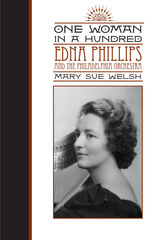 One Woman in a Hundred: Edna Phillips and the Philadelphia Orchestra
Mary Sue Welsh
University of Illinois Press, 2013 Gifted harpist Edna Phillips (1907–2003) joined the Philadelphia Orchestra in 1930, becoming not only that ensemble's first female member but also the first woman to hold a principal position in a major American orchestra. Plucked from the Curtis Institute of Music in the midst of her studies, Phillips was only twenty-three years old when Leopold Stokowski, one of the twentieth century's most innovative and controversial conductors, named her principal harpist. This candid, colorful account traces Phillips's journey through the competitive realm of Philadelphia's virtuoso players, where she survived--and thrived--thanks to her undeniable talent, determination, and lively humor. Drawing on extensive interviews with Phillips, her family, and colleagues as well as archival sources, One Woman in a Hundred chronicles the training, aspirations, setbacks, and successes of this pioneering woman musician. Mary Sue Welsh recounts numerous insider stories of rehearsal and performance with Stokowski and other renowned conductors of the period such as Arturo Toscanini, Fritz Reiner, Otto Klemperer, Sir Thomas Beecham, and Eugene Ormandy. She also depicts Phillips's interactions with fellow performers, the orchestra management, and her teacher, the wily and brilliant Carlos Salzedo. Blessed with a nimble wit, Phillips navigated a plethora of challenges, ranging from false conductors' cues to the advances of the debonair Stokowski and others. She remained with the orchestra through some of its most exciting years from 1930 to 1946 and was instrumental in fostering harp performance, commissioning many significant contributions to the literature. This portrait of Phillips's exceptional tenure with the Philadelphia Orchestra also reveals the behind-the-scenes life of a famous orchestra during a period in which Rachmaninoff declared it "the finest orchestra the world has ever heard." Through Phillips's perceptive eyes, readers will watch as Stokowski melds his musicians into a marvelously flexible ensemble; world-class performers reach great heights and make embarrassing flubs; Greta Garbo comes to Philadelphia to observe her lover Leopold Stokowski at work; and the orchestra encounters the novel experience of recording for Walt Disney's Fantasia. A colorful glimpse into a world-class orchestra at the height of its glory, One Woman in a Hundred tells the fascinating story of one woman brave enough and strong enough to overcome historic barriers and pursue her dreams.
One Woman in the War: Hungary 1944-1945
Alaine Polcz
Central European University Press, 2002 Before the publication of this book, Alaine Polcz was widely recognized as a psychologist ministering to the needs of disturbed and incurably ill children and their families, as the author of numerous articles and several books on thanatology, and as the founder of the hospice movement in Hungary. The autobiographic account of the experiences of a woman, then 19-20, in the closing months of the Second World War. When it was first published, in 1991, the book was a revelation of past horrors in Hungary which, until then, had lingered on in the farthest reaches of the national memory as rumor and suspicion about the violent acts committed against women during a time of chaos, havoc, and savagery. The literary world quickly recognized the merits of this book: It was highly praised by Hungarian reviewers, awarded prizes, and has already been translated into French, Rumanian, Slovenian, and Serbian.
One Word
Marc Straus
Northwestern University Press, 1994 One Word is the first collection of poems by physician Marc J. Straus. Its unusual combination of poetic craft and medical expertise produces striking, uncommon work--work informed by a keen sense of human vulnerability. These remarkable poems fill a void in the body of imaginative work relating to illness.
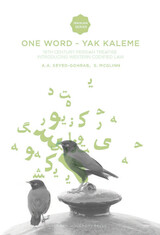 One Word - Yak Kaleme: 19th Century Persian Treatise Introducing Western Codified Law
Sen McGlinn
Amsterdam University Press, 2010 One Word - Yak Kaleme was one of the first treatises in the Middle East to demonstrate that Islam is compatible with the introduction of modern western forms of government, and specifically that the principles of the sharia can be incorporated in a codified law comparable to that found in European countries. This was a daring argument in the late 19th century, when it was extremely difficult to convince the rulers and religious class that a civil code of law was needed: would it not diminish the status of the ruler, and would it not be an admission that the religious law, the sharia, was deficient?
The author, Mirza Yu¯suf Kha¯n Mustashar al-Dawla (d. 1895), was a liberal-minded bureaucrat campaigning for reform of the absolutist system and the creation of one based on European principles of government. He held several posts abroad including St Petersburg (1854-62), and Paris (1867-71), as well as carrying out administrative duties in Iran itself.
In One Word he argues that the principles underlying constitutional government can be found in Islamic sources, particularly in the Quran and traditions of the Prophet. Unlike some Oriental travellers to Europe at that time, he observed that European dominance was not derived from a few technological advances, but primarily from the organisation of society, on the basis of codified law. One Word was a significant text in the lead-up to the Iranian Constitutional Revolution of 1906, but its message is relevant today.
|
|
